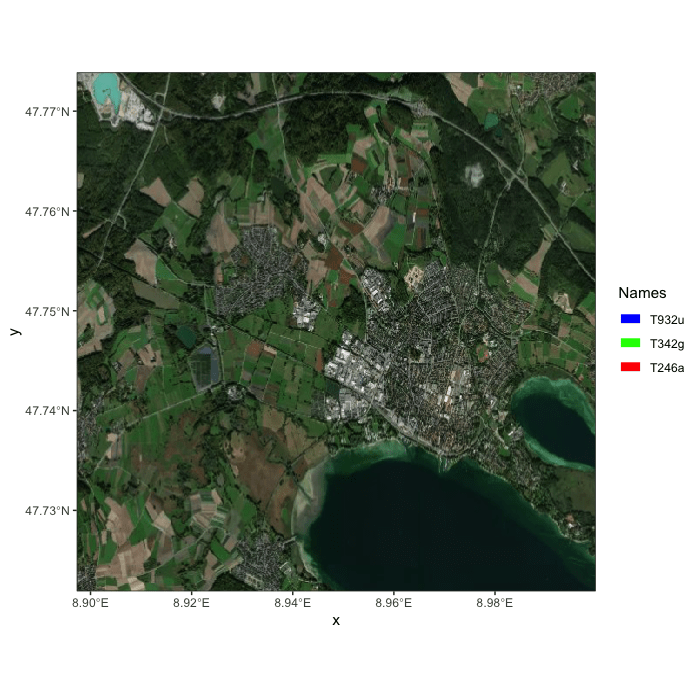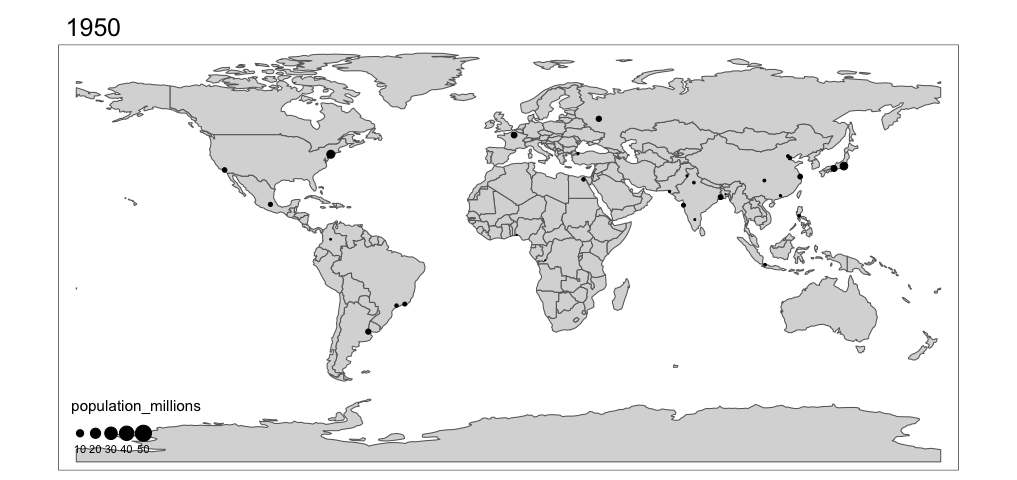name: 1 class: center middle main-title section-title-4 # Interactive webmapping and visualization with R .class-info[ **Session 19** .light[HES597: Introduction to Spatial Data in R<br> Boise State University Human-Environment Systems<br> Fall 2021] ] --- # 3 Categories of data visualization .pull-left[ - Static - Interactive - Dynamic ] .pull-right[  ] --- name: motivations class: center middle main-title section-title-4 # Motivations --- # Dealing with complex datasets .pull-left[ <figure> <img src="img/10/datasciencesteps.png" alt="ZZZ" title="ZZZ" width="100%"> </figure> ] .pull-right[ - Identifying structure that might otherwise be hidden - Diagnosing models and interpreting results - Aiding the sense-making process ] --- # Clarity in presentation - Zooming allows the user to determine scale of presentation - Hovering allows more information to be displayed 'on-demand' - Subsetting facilitates ease of interpretation --- # Clarity in presentation .pull-left[ <img src="10-slides_files/figure-html/gplot-1.png" width="504" style="display: block; margin: auto;" /> ] .pull-right[ <div id="htmlwidget-d3a42204eec90b79180d" style="width:504px;height:504px;" class="plotly html-widget"></div> <script type="application/json" data-for="htmlwidget-d3a42204eec90b79180d">{"x":{"visdat":{"2c99152368ee":["function () ","plotlyVisDat"],"2c9947bdec19":["function () ","data"]},"cur_data":"2c9947bdec19","attrs":{"2c99152368ee":{"x":{},"y":{},"alpha_stroke":1,"sizes":[10,100],"spans":[1,20],"type":"scatter","mode":"lines","name":"Texan Cities","hoverinfo":"none","line":{"color":"rgba(192,192,192,0.4)"},"inherit":true},"2c9947bdec19":{"x":{},"y":{},"alpha_stroke":1,"sizes":[10,100],"spans":[1,20],"type":"scatter","mode":"lines","name":{},"hoverinfo":{},"line":{"color":["red","blue"]},"color":{},"inherit":true}},"layout":{"margin":{"b":40,"l":60,"t":25,"r":10},"xaxis":{"domain":[0,1],"automargin":true,"title":"date"},"yaxis":{"domain":[0,1],"automargin":true,"title":"median"},"hovermode":"closest","showlegend":true},"source":"A","config":{"modeBarButtonsToAdd":["hoverclosest","hovercompare"],"showSendToCloud":false},"data":[{"x":[2000,2000.08333333333,2000.16666666667,2000.25,2000.33333333333,2000.41666666667,2000.5,2000.58333333333,2000.66666666667,2000.75,2000.83333333333,2000.91666666667,2001,2001.08333333333,2001.16666666667,2001.25,2001.33333333333,2001.41666666667,2001.5,2001.58333333333,2001.66666666667,2001.75,2001.83333333333,2001.91666666667,2002,2002.08333333333,2002.16666666667,2002.25,2002.33333333333,2002.41666666667,2002.5,2002.58333333333,2002.66666666667,2002.75,2002.83333333333,2002.91666666667,2003,2003.08333333333,2003.16666666667,2003.25,2003.33333333333,2003.41666666667,2003.5,2003.58333333333,2003.66666666667,2003.75,2003.83333333333,2003.91666666667,2004,2004.08333333333,2004.16666666667,2004.25,2004.33333333333,2004.41666666667,2004.5,2004.58333333333,2004.66666666667,2004.75,2004.83333333333,2004.91666666667,2005,2005.08333333333,2005.16666666667,2005.25,2005.33333333333,2005.41666666667,2005.5,2005.58333333333,2005.66666666667,2005.75,2005.83333333333,2005.91666666667,2006,2006.08333333333,2006.16666666667,2006.25,2006.33333333333,2006.41666666667,2006.5,2006.58333333333,2006.66666666667,2006.75,2006.83333333333,2006.91666666667,2007,2007.08333333333,2007.16666666667,2007.25,2007.33333333333,2007.41666666667,2007.5,2007.58333333333,2007.66666666667,2007.75,2007.83333333333,2007.91666666667,2008,2008.08333333333,2008.16666666667,2008.25,2008.33333333333,2008.41666666667,2008.5,2008.58333333333,2008.66666666667,2008.75,2008.83333333333,2008.91666666667,2009,2009.08333333333,2009.16666666667,2009.25,2009.33333333333,2009.41666666667,2009.5,2009.58333333333,2009.66666666667,2009.75,2009.83333333333,2009.91666666667,2010,2010.08333333333,2010.16666666667,2010.25,2010.33333333333,2010.41666666667,2010.5,2010.58333333333,2010.66666666667,2010.75,2010.83333333333,2010.91666666667,2011,2011.08333333333,2011.16666666667,2011.25,2011.33333333333,2011.41666666667,2011.5,2011.58333333333,2011.66666666667,2011.75,2011.83333333333,2011.91666666667,2012,2012.08333333333,2012.16666666667,2012.25,2012.33333333333,2012.41666666667,2012.5,2012.58333333333,2012.66666666667,2012.75,2012.83333333333,2012.91666666667,2013,2013.08333333333,2013.16666666667,2013.25,2013.33333333333,2013.41666666667,2013.5,2013.58333333333,2013.66666666667,2013.75,2013.83333333333,2013.91666666667,2014,2014.08333333333,2014.16666666667,2014.25,2014.33333333333,2014.41666666667,2014.5,2014.58333333333,2014.66666666667,2014.75,2014.83333333333,2014.91666666667,2015,2015.08333333333,2015.16666666667,2015.25,2015.33333333333,2015.41666666667,2015.5,null,2000,2000.08333333333,2000.16666666667,2000.25,2000.33333333333,2000.41666666667,2000.5,2000.58333333333,2000.66666666667,2000.75,2000.83333333333,2000.91666666667,2001,2001.08333333333,2001.16666666667,2001.25,2001.33333333333,2001.41666666667,2001.5,2001.58333333333,2001.66666666667,2001.75,2001.83333333333,2001.91666666667,2002,2002.08333333333,2002.16666666667,2002.25,2002.33333333333,2002.41666666667,2002.5,2002.58333333333,2002.66666666667,2002.75,2002.83333333333,2002.91666666667,2003,2003.08333333333,2003.16666666667,2003.25,2003.33333333333,2003.41666666667,2003.5,2003.58333333333,2003.66666666667,2003.75,2003.83333333333,2003.91666666667,2004,2004.08333333333,2004.16666666667,2004.25,2004.33333333333,2004.41666666667,2004.5,2004.58333333333,2004.66666666667,2004.75,2004.83333333333,2004.91666666667,2005,2005.08333333333,2005.16666666667,2005.25,2005.33333333333,2005.41666666667,2005.5,2005.58333333333,2005.66666666667,2005.75,2005.83333333333,2005.91666666667,2006,2006.08333333333,2006.16666666667,2006.25,2006.33333333333,2006.41666666667,2006.5,2006.58333333333,2006.66666666667,2006.75,2006.83333333333,2006.91666666667,2007,2007.08333333333,2007.16666666667,2007.25,2007.33333333333,2007.41666666667,2007.5,2007.58333333333,2007.66666666667,2007.75,2007.83333333333,2007.91666666667,2008,2008.08333333333,2008.16666666667,2008.25,2008.33333333333,2008.41666666667,2008.5,2008.58333333333,2008.66666666667,2008.75,2008.83333333333,2008.91666666667,2009,2009.08333333333,2009.16666666667,2009.25,2009.33333333333,2009.41666666667,2009.5,2009.58333333333,2009.66666666667,2009.75,2009.83333333333,2009.91666666667,2010,2010.08333333333,2010.16666666667,2010.25,2010.33333333333,2010.41666666667,2010.5,2010.58333333333,2010.66666666667,2010.75,2010.83333333333,2010.91666666667,2011,2011.08333333333,2011.16666666667,2011.25,2011.33333333333,2011.41666666667,2011.5,2011.58333333333,2011.66666666667,2011.75,2011.83333333333,2011.91666666667,2012,2012.08333333333,2012.16666666667,2012.25,2012.33333333333,2012.41666666667,2012.5,2012.58333333333,2012.66666666667,2012.75,2012.83333333333,2012.91666666667,2013,2013.08333333333,2013.16666666667,2013.25,2013.33333333333,2013.41666666667,2013.5,2013.58333333333,2013.66666666667,2013.75,2013.83333333333,2013.91666666667,2014,2014.08333333333,2014.16666666667,2014.25,2014.33333333333,2014.41666666667,2014.5,2014.58333333333,2014.66666666667,2014.75,2014.83333333333,2014.91666666667,2015,2015.08333333333,2015.16666666667,2015.25,2015.33333333333,2015.41666666667,2015.5,null,2000,2000.08333333333,2000.16666666667,2000.25,2000.33333333333,2000.41666666667,2000.5,2000.58333333333,2000.66666666667,2000.75,2000.83333333333,2000.91666666667,2001,2001.08333333333,2001.16666666667,2001.25,2001.33333333333,2001.41666666667,2001.5,2001.58333333333,2001.66666666667,2001.75,2001.83333333333,2001.91666666667,2002,2002.08333333333,2002.16666666667,2002.25,2002.33333333333,2002.41666666667,2002.5,2002.58333333333,2002.66666666667,2002.75,2002.83333333333,2002.91666666667,2003,2003.08333333333,2003.16666666667,2003.25,2003.33333333333,2003.41666666667,2003.5,2003.58333333333,2003.66666666667,2003.75,2003.83333333333,2003.91666666667,2004,2004.08333333333,2004.16666666667,2004.25,2004.33333333333,2004.41666666667,2004.5,2004.58333333333,2004.66666666667,2004.75,2004.83333333333,2004.91666666667,2005,2005.08333333333,2005.16666666667,2005.25,2005.33333333333,2005.41666666667,2005.5,2005.58333333333,2005.66666666667,2005.75,2005.83333333333,2005.91666666667,2006,2006.08333333333,2006.16666666667,2006.25,2006.33333333333,2006.41666666667,2006.5,2006.58333333333,2006.66666666667,2006.75,2006.83333333333,2006.91666666667,2007,2007.08333333333,2007.16666666667,2007.25,2007.33333333333,2007.41666666667,2007.5,2007.58333333333,2007.66666666667,2007.75,2007.83333333333,2007.91666666667,2008,2008.08333333333,2008.16666666667,2008.25,2008.33333333333,2008.41666666667,2008.5,2008.58333333333,2008.66666666667,2008.75,2008.83333333333,2008.91666666667,2009,2009.08333333333,2009.16666666667,2009.25,2009.33333333333,2009.41666666667,2009.5,2009.58333333333,2009.66666666667,2009.75,2009.83333333333,2009.91666666667,2010,2010.08333333333,2010.16666666667,2010.25,2010.33333333333,2010.41666666667,2010.5,2010.58333333333,2010.66666666667,2010.75,2010.83333333333,2010.91666666667,2011,2011.08333333333,2011.16666666667,2011.25,2011.33333333333,2011.41666666667,2011.5,2011.58333333333,2011.66666666667,2011.75,2011.83333333333,2011.91666666667,2012,2012.08333333333,2012.16666666667,2012.25,2012.33333333333,2012.41666666667,2012.5,2012.58333333333,2012.66666666667,2012.75,2012.83333333333,2012.91666666667,2013,2013.08333333333,2013.16666666667,2013.25,2013.33333333333,2013.41666666667,2013.5,2013.58333333333,2013.66666666667,2013.75,2013.83333333333,2013.91666666667,2014,2014.08333333333,2014.16666666667,2014.25,2014.33333333333,2014.41666666667,2014.5,2014.58333333333,2014.66666666667,2014.75,2014.83333333333,2014.91666666667,2015,2015.08333333333,2015.16666666667,2015.25,2015.33333333333,2015.41666666667,2015.5,null,2000,2000.08333333333,2000.16666666667,2000.25,2000.33333333333,2000.41666666667,2000.5,2000.58333333333,2000.66666666667,2000.75,2000.83333333333,2000.91666666667,2001,2001.08333333333,2001.16666666667,2001.25,2001.33333333333,2001.41666666667,2001.5,2001.58333333333,2001.66666666667,2001.75,2001.83333333333,2001.91666666667,2002,2002.08333333333,2002.16666666667,2002.25,2002.33333333333,2002.41666666667,2002.5,2002.58333333333,2002.66666666667,2002.75,2002.83333333333,2002.91666666667,2003,2003.08333333333,2003.16666666667,2003.25,2003.33333333333,2003.41666666667,2003.5,2003.58333333333,2003.66666666667,2003.75,2003.83333333333,2003.91666666667,2004,2004.08333333333,2004.16666666667,2004.25,2004.33333333333,2004.41666666667,2004.5,2004.58333333333,2004.66666666667,2004.75,2004.83333333333,2004.91666666667,2005,2005.08333333333,2005.16666666667,2005.25,2005.33333333333,2005.41666666667,2005.5,2005.58333333333,2005.66666666667,2005.75,2005.83333333333,2005.91666666667,2006,2006.08333333333,2006.16666666667,2006.25,2006.33333333333,2006.41666666667,2006.5,2006.58333333333,2006.66666666667,2006.75,2006.83333333333,2006.91666666667,2007,2007.08333333333,2007.16666666667,2007.25,2007.33333333333,2007.41666666667,2007.5,2007.58333333333,2007.66666666667,2007.75,2007.83333333333,2007.91666666667,2008,2008.08333333333,2008.16666666667,2008.25,2008.33333333333,2008.41666666667,2008.5,2008.58333333333,2008.66666666667,2008.75,2008.83333333333,2008.91666666667,2009,2009.08333333333,2009.16666666667,2009.25,2009.33333333333,2009.41666666667,2009.5,2009.58333333333,2009.66666666667,2009.75,2009.83333333333,2009.91666666667,2010,2010.08333333333,2010.16666666667,2010.25,2010.33333333333,2010.41666666667,2010.5,2010.58333333333,2010.66666666667,2010.75,2010.83333333333,2010.91666666667,2011,2011.08333333333,2011.16666666667,2011.25,2011.33333333333,2011.41666666667,2011.5,2011.58333333333,2011.66666666667,2011.75,2011.83333333333,2011.91666666667,2012,2012.08333333333,2012.16666666667,2012.25,2012.33333333333,2012.41666666667,2012.5,2012.58333333333,2012.66666666667,2012.75,2012.83333333333,2012.91666666667,2013,2013.08333333333,2013.16666666667,2013.25,2013.33333333333,2013.41666666667,2013.5,2013.58333333333,2013.66666666667,2013.75,2013.83333333333,2013.91666666667,2014,2014.08333333333,2014.16666666667,2014.25,2014.33333333333,2014.41666666667,2014.5,2014.58333333333,2014.66666666667,2014.75,2014.83333333333,2014.91666666667,2015,2015.08333333333,2015.16666666667,2015.25,2015.33333333333,2015.41666666667,2015.5,null,2000,2000.08333333333,2000.16666666667,2000.25,2000.33333333333,2000.41666666667,2000.5,2000.58333333333,2000.66666666667,2000.75,2000.83333333333,2000.91666666667,2001,2001.08333333333,2001.16666666667,2001.25,2001.33333333333,2001.41666666667,2001.5,2001.58333333333,2001.66666666667,2001.75,2001.83333333333,2001.91666666667,2002,2002.08333333333,2002.16666666667,2002.25,2002.33333333333,2002.41666666667,2002.5,2002.58333333333,2002.66666666667,2002.75,2002.83333333333,2002.91666666667,2003,2003.08333333333,2003.16666666667,2003.25,2003.33333333333,2003.41666666667,2003.5,2003.58333333333,2003.66666666667,2003.75,2003.83333333333,2003.91666666667,2004,2004.08333333333,2004.16666666667,2004.25,2004.33333333333,2004.41666666667,2004.5,2004.58333333333,2004.66666666667,2004.75,2004.83333333333,2004.91666666667,2005,2005.08333333333,2005.16666666667,2005.25,2005.33333333333,2005.41666666667,2005.5,2005.58333333333,2005.66666666667,2005.75,2005.83333333333,2005.91666666667,2006,2006.08333333333,2006.16666666667,2006.25,2006.33333333333,2006.41666666667,2006.5,2006.58333333333,2006.66666666667,2006.75,2006.83333333333,2006.91666666667,2007,2007.08333333333,2007.16666666667,2007.25,2007.33333333333,2007.41666666667,2007.5,2007.58333333333,2007.66666666667,2007.75,2007.83333333333,2007.91666666667,2008,2008.08333333333,2008.16666666667,2008.25,2008.33333333333,2008.41666666667,2008.5,2008.58333333333,2008.66666666667,2008.75,2008.83333333333,2008.91666666667,2009,2009.08333333333,2009.16666666667,2009.25,2009.33333333333,2009.41666666667,2009.5,2009.58333333333,2009.66666666667,2009.75,2009.83333333333,2009.91666666667,2010,2010.08333333333,2010.16666666667,2010.25,2010.33333333333,2010.41666666667,2010.5,2010.58333333333,2010.66666666667,2010.75,2010.83333333333,2010.91666666667,2011,2011.08333333333,2011.16666666667,2011.25,2011.33333333333,2011.41666666667,2011.5,2011.58333333333,2011.66666666667,2011.75,2011.83333333333,2011.91666666667,2012,2012.08333333333,2012.16666666667,2012.25,2012.33333333333,2012.41666666667,2012.5,2012.58333333333,2012.66666666667,2012.75,2012.83333333333,2012.91666666667,2013,2013.08333333333,2013.16666666667,2013.25,2013.33333333333,2013.41666666667,2013.5,2013.58333333333,2013.66666666667,2013.75,2013.83333333333,2013.91666666667,2014,2014.08333333333,2014.16666666667,2014.25,2014.33333333333,2014.41666666667,2014.5,2014.58333333333,2014.66666666667,2014.75,2014.83333333333,2014.91666666667,2015,2015.08333333333,2015.16666666667,2015.25,2015.33333333333,2015.41666666667,2015.5,null,2000,2000.08333333333,2000.16666666667,2000.25,2000.33333333333,2000.41666666667,2000.5,2000.58333333333,2000.66666666667,2000.75,2000.83333333333,2000.91666666667,2001,2001.08333333333,2001.16666666667,2001.25,2001.33333333333,2001.41666666667,2001.5,2001.58333333333,2001.66666666667,2001.75,2001.83333333333,2001.91666666667,2002,2002.08333333333,2002.16666666667,2002.25,2002.33333333333,2002.41666666667,2002.5,2002.58333333333,2002.66666666667,2002.75,2002.83333333333,2002.91666666667,2003,2003.08333333333,2003.16666666667,2003.25,2003.33333333333,2003.41666666667,2003.5,2003.58333333333,2003.66666666667,2003.75,2003.83333333333,2003.91666666667,2004,2004.08333333333,2004.16666666667,2004.25,2004.33333333333,2004.41666666667,2004.5,2004.58333333333,2004.66666666667,2004.75,2004.83333333333,2004.91666666667,2005,2005.08333333333,2005.16666666667,2005.25,2005.33333333333,2005.41666666667,2005.5,2005.58333333333,2005.66666666667,2005.75,2005.83333333333,2005.91666666667,2006,2006.08333333333,2006.16666666667,2006.25,2006.33333333333,2006.41666666667,2006.5,2006.58333333333,2006.66666666667,2006.75,2006.83333333333,2006.91666666667,2007,2007.08333333333,2007.16666666667,2007.25,2007.33333333333,2007.41666666667,2007.5,2007.58333333333,2007.66666666667,2007.75,2007.83333333333,2007.91666666667,2008,2008.08333333333,2008.16666666667,2008.25,2008.33333333333,2008.41666666667,2008.5,2008.58333333333,2008.66666666667,2008.75,2008.83333333333,2008.91666666667,2009,2009.08333333333,2009.16666666667,2009.25,2009.33333333333,2009.41666666667,2009.5,2009.58333333333,2009.66666666667,2009.75,2009.83333333333,2009.91666666667,2010,2010.08333333333,2010.16666666667,2010.25,2010.33333333333,2010.41666666667,2010.5,2010.58333333333,2010.66666666667,2010.75,2010.83333333333,2010.91666666667,2011,2011.08333333333,2011.16666666667,2011.25,2011.33333333333,2011.41666666667,2011.5,2011.58333333333,2011.66666666667,2011.75,2011.83333333333,2011.91666666667,2012,2012.08333333333,2012.16666666667,2012.25,2012.33333333333,2012.41666666667,2012.5,2012.58333333333,2012.66666666667,2012.75,2012.83333333333,2012.91666666667,2013,2013.08333333333,2013.16666666667,2013.25,2013.33333333333,2013.41666666667,2013.5,2013.58333333333,2013.66666666667,2013.75,2013.83333333333,2013.91666666667,2014,2014.08333333333,2014.16666666667,2014.25,2014.33333333333,2014.41666666667,2014.5,2014.58333333333,2014.66666666667,2014.75,2014.83333333333,2014.91666666667,2015,2015.08333333333,2015.16666666667,2015.25,2015.33333333333,2015.41666666667,2015.5,null,2000,2000.08333333333,2000.16666666667,2000.25,2000.33333333333,2000.41666666667,2000.5,2000.58333333333,2000.66666666667,2000.75,2000.83333333333,2000.91666666667,2001,2001.08333333333,2001.16666666667,2001.25,2001.33333333333,2001.41666666667,2001.5,2001.58333333333,2001.66666666667,null,2001.83333333333,2001.91666666667,2002,2002.08333333333,2002.16666666667,2002.25,2002.33333333333,2002.41666666667,2002.5,2002.58333333333,2002.66666666667,2002.75,2002.83333333333,2002.91666666667,null,2004,2004.08333333333,2004.16666666667,2004.25,2004.33333333333,2004.41666666667,2004.5,2004.58333333333,2004.66666666667,2004.75,2004.83333333333,2004.91666666667,2005,2005.08333333333,2005.16666666667,2005.25,2005.33333333333,2005.41666666667,2005.5,2005.58333333333,2005.66666666667,2005.75,2005.83333333333,2005.91666666667,2006,2006.08333333333,2006.16666666667,2006.25,2006.33333333333,2006.41666666667,2006.5,2006.58333333333,2006.66666666667,2006.75,2006.83333333333,2006.91666666667,2007,2007.08333333333,2007.16666666667,2007.25,2007.33333333333,2007.41666666667,2007.5,2007.58333333333,2007.66666666667,2007.75,2007.83333333333,2007.91666666667,2008,2008.08333333333,2008.16666666667,2008.25,2008.33333333333,2008.41666666667,2008.5,2008.58333333333,2008.66666666667,2008.75,2008.83333333333,2008.91666666667,2009,2009.08333333333,2009.16666666667,2009.25,2009.33333333333,2009.41666666667,2009.5,2009.58333333333,2009.66666666667,2009.75,2009.83333333333,2009.91666666667,2010,2010.08333333333,2010.16666666667,2010.25,2010.33333333333,2010.41666666667,2010.5,2010.58333333333,2010.66666666667,2010.75,2010.83333333333,2010.91666666667,2011,2011.08333333333,2011.16666666667,2011.25,2011.33333333333,2011.41666666667,2011.5,2011.58333333333,2011.66666666667,2011.75,2011.83333333333,2011.91666666667,2012,2012.08333333333,2012.16666666667,2012.25,2012.33333333333,2012.41666666667,2012.5,2012.58333333333,2012.66666666667,2012.75,2012.83333333333,2012.91666666667,2013,2013.08333333333,2013.16666666667,2013.25,2013.33333333333,2013.41666666667,2013.5,2013.58333333333,2013.66666666667,2013.75,2013.83333333333,2013.91666666667,2014,2014.08333333333,2014.16666666667,2014.25,2014.33333333333,2014.41666666667,2014.5,2014.58333333333,2014.66666666667,2014.75,2014.83333333333,2014.91666666667,2015,2015.08333333333,2015.16666666667,2015.25,2015.33333333333,2015.41666666667,null,2000.08333333333,2000.16666666667,2000.25,2000.33333333333,2000.41666666667,2000.5,2000.58333333333,2000.66666666667,2000.75,2000.83333333333,2000.91666666667,2001,2001.08333333333,2001.16666666667,2001.25,2001.33333333333,2001.41666666667,2001.5,2001.58333333333,2001.66666666667,2001.75,2001.83333333333,2001.91666666667,2002,2002.08333333333,2002.16666666667,2002.25,2002.33333333333,2002.41666666667,2002.5,2002.58333333333,2002.66666666667,2002.75,2002.83333333333,2002.91666666667,2003,2003.08333333333,2003.16666666667,2003.25,2003.33333333333,2003.41666666667,2003.5,2003.58333333333,2003.66666666667,2003.75,2003.83333333333,2003.91666666667,2004,2004.08333333333,2004.16666666667,2004.25,2004.33333333333,2004.41666666667,2004.5,2004.58333333333,2004.66666666667,2004.75,2004.83333333333,2004.91666666667,2005,2005.08333333333,2005.16666666667,2005.25,2005.33333333333,2005.41666666667,2005.5,2005.58333333333,2005.66666666667,2005.75,2005.83333333333,2005.91666666667,2006,2006.08333333333,2006.16666666667,2006.25,2006.33333333333,2006.41666666667,2006.5,2006.58333333333,2006.66666666667,2006.75,2006.83333333333,2006.91666666667,2007,2007.08333333333,2007.16666666667,2007.25,2007.33333333333,2007.41666666667,2007.5,2007.58333333333,2007.66666666667,2007.75,2007.83333333333,2007.91666666667,2008,2008.08333333333,2008.16666666667,2008.25,2008.33333333333,2008.41666666667,2008.5,2008.58333333333,2008.66666666667,2008.75,2008.83333333333,2008.91666666667,2009,2009.08333333333,2009.16666666667,2009.25,2009.33333333333,2009.41666666667,2009.5,2009.58333333333,2009.66666666667,2009.75,2009.83333333333,2009.91666666667,2010,2010.08333333333,2010.16666666667,2010.25,2010.33333333333,2010.41666666667,2010.5,2010.58333333333,2010.66666666667,2010.75,2010.83333333333,2010.91666666667,2011,2011.08333333333,2011.16666666667,2011.25,2011.33333333333,2011.41666666667,2011.5,2011.58333333333,2011.66666666667,2011.75,2011.83333333333,2011.91666666667,2012,2012.08333333333,2012.16666666667,2012.25,2012.33333333333,2012.41666666667,2012.5,2012.58333333333,2012.66666666667,2012.75,2012.83333333333,2012.91666666667,2013,2013.08333333333,2013.16666666667,2013.25,2013.33333333333,2013.41666666667,2013.5,2013.58333333333,2013.66666666667,2013.75,2013.83333333333,2013.91666666667,2014,2014.08333333333,2014.16666666667,2014.25,2014.33333333333,2014.41666666667,2014.5,2014.58333333333,2014.66666666667,2014.75,2014.83333333333,2014.91666666667,2015,2015.08333333333,2015.16666666667,2015.25,2015.33333333333,2015.41666666667,null,2000,2000.08333333333,2000.16666666667,2000.25,2000.33333333333,2000.41666666667,2000.5,2000.58333333333,2000.66666666667,2000.75,2000.83333333333,2000.91666666667,2001,2001.08333333333,2001.16666666667,2001.25,2001.33333333333,2001.41666666667,2001.5,2001.58333333333,2001.66666666667,2001.75,2001.83333333333,2001.91666666667,2002,2002.08333333333,2002.16666666667,2002.25,2002.33333333333,2002.41666666667,2002.5,2002.58333333333,2002.66666666667,2002.75,2002.83333333333,2002.91666666667,2003,2003.08333333333,2003.16666666667,2003.25,2003.33333333333,2003.41666666667,2003.5,2003.58333333333,2003.66666666667,2003.75,2003.83333333333,2003.91666666667,2004,2004.08333333333,2004.16666666667,2004.25,2004.33333333333,2004.41666666667,2004.5,2004.58333333333,2004.66666666667,2004.75,2004.83333333333,2004.91666666667,2005,2005.08333333333,2005.16666666667,2005.25,2005.33333333333,2005.41666666667,2005.5,2005.58333333333,2005.66666666667,2005.75,2005.83333333333,2005.91666666667,2006,2006.08333333333,2006.16666666667,2006.25,2006.33333333333,2006.41666666667,2006.5,2006.58333333333,2006.66666666667,2006.75,2006.83333333333,2006.91666666667,2007,2007.08333333333,2007.16666666667,2007.25,2007.33333333333,2007.41666666667,2007.5,2007.58333333333,2007.66666666667,2007.75,2007.83333333333,2007.91666666667,2008,2008.08333333333,2008.16666666667,2008.25,2008.33333333333,2008.41666666667,2008.5,2008.58333333333,2008.66666666667,2008.75,2008.83333333333,2008.91666666667,2009,2009.08333333333,2009.16666666667,2009.25,2009.33333333333,2009.41666666667,2009.5,2009.58333333333,2009.66666666667,2009.75,2009.83333333333,2009.91666666667,2010,2010.08333333333,2010.16666666667,2010.25,2010.33333333333,2010.41666666667,2010.5,2010.58333333333,2010.66666666667,2010.75,2010.83333333333,2010.91666666667,2011,2011.08333333333,2011.16666666667,2011.25,2011.33333333333,2011.41666666667,2011.5,2011.58333333333,2011.66666666667,2011.75,2011.83333333333,2011.91666666667,2012,2012.08333333333,2012.16666666667,2012.25,2012.33333333333,2012.41666666667,2012.5,2012.58333333333,2012.66666666667,2012.75,2012.83333333333,2012.91666666667,2013,2013.08333333333,2013.16666666667,2013.25,2013.33333333333,2013.41666666667,2013.5,2013.58333333333,2013.66666666667,2013.75,2013.83333333333,2013.91666666667,2014,2014.08333333333,2014.16666666667,2014.25,2014.33333333333,2014.41666666667,2014.5,2014.58333333333,2014.66666666667,2014.75,2014.83333333333,2014.91666666667,2015,2015.08333333333,2015.16666666667,2015.25,2015.33333333333,2015.41666666667,2015.5,null,2000,2000.08333333333,2000.16666666667,2000.25,2000.33333333333,2000.41666666667,2000.5,2000.58333333333,2000.66666666667,2000.75,2000.83333333333,2000.91666666667,2001,2001.08333333333,2001.16666666667,2001.25,2001.33333333333,2001.41666666667,2001.5,2001.58333333333,2001.66666666667,2001.75,2001.83333333333,2001.91666666667,2002,2002.08333333333,2002.16666666667,2002.25,2002.33333333333,2002.41666666667,2002.5,2002.58333333333,2002.66666666667,2002.75,2002.83333333333,2002.91666666667,2003,2003.08333333333,2003.16666666667,2003.25,2003.33333333333,2003.41666666667,2003.5,2003.58333333333,2003.66666666667,2003.75,2003.83333333333,2003.91666666667,2004,2004.08333333333,2004.16666666667,2004.25,2004.33333333333,2004.41666666667,2004.5,2004.58333333333,2004.66666666667,2004.75,2004.83333333333,2004.91666666667,2005,2005.08333333333,2005.16666666667,2005.25,2005.33333333333,2005.41666666667,2005.5,2005.58333333333,2005.66666666667,2005.75,2005.83333333333,2005.91666666667,2006,2006.08333333333,2006.16666666667,2006.25,2006.33333333333,2006.41666666667,2006.5,2006.58333333333,2006.66666666667,2006.75,2006.83333333333,2006.91666666667,2007,2007.08333333333,2007.16666666667,2007.25,2007.33333333333,2007.41666666667,2007.5,2007.58333333333,2007.66666666667,2007.75,2007.83333333333,2007.91666666667,2008,2008.08333333333,2008.16666666667,2008.25,2008.33333333333,2008.41666666667,2008.5,2008.58333333333,2008.66666666667,2008.75,2008.83333333333,2008.91666666667,2009,2009.08333333333,2009.16666666667,2009.25,2009.33333333333,2009.41666666667,2009.5,2009.58333333333,2009.66666666667,2009.75,2009.83333333333,2009.91666666667,2010,2010.08333333333,2010.16666666667,2010.25,2010.33333333333,2010.41666666667,2010.5,2010.58333333333,2010.66666666667,2010.75,2010.83333333333,2010.91666666667,2011,2011.08333333333,2011.16666666667,2011.25,2011.33333333333,2011.41666666667,2011.5,2011.58333333333,2011.66666666667,2011.75,2011.83333333333,2011.91666666667,2012,2012.08333333333,2012.16666666667,2012.25,2012.33333333333,2012.41666666667,2012.5,2012.58333333333,2012.66666666667,2012.75,2012.83333333333,2012.91666666667,2013,2013.08333333333,2013.16666666667,2013.25,2013.33333333333,2013.41666666667,2013.5,2013.58333333333,2013.66666666667,2013.75,2013.83333333333,2013.91666666667,2014,2014.08333333333,2014.16666666667,2014.25,2014.33333333333,2014.41666666667,2014.5,2014.58333333333,2014.66666666667,2014.75,2014.83333333333,2014.91666666667,2015,2015.08333333333,2015.16666666667,2015.25,2015.33333333333,2015.41666666667,2015.5,null,2000,2000.08333333333,2000.16666666667,2000.25,2000.33333333333,2000.41666666667,2000.5,2000.58333333333,2000.66666666667,2000.75,null,2000.91666666667,2001,2001.08333333333,2001.16666666667,2001.25,2001.33333333333,2001.41666666667,2001.5,2001.58333333333,2001.66666666667,2001.75,2001.83333333333,2001.91666666667,2002,2002.08333333333,2002.16666666667,2002.25,2002.33333333333,2002.41666666667,2002.5,2002.58333333333,2002.66666666667,2002.75,2002.83333333333,2002.91666666667,2003,2003.08333333333,2003.16666666667,2003.25,2003.33333333333,2003.41666666667,2003.5,2003.58333333333,2003.66666666667,2003.75,2003.83333333333,2003.91666666667,2004,2004.08333333333,2004.16666666667,2004.25,2004.33333333333,2004.41666666667,2004.5,2004.58333333333,2004.66666666667,2004.75,2004.83333333333,2004.91666666667,2005,2005.08333333333,2005.16666666667,2005.25,2005.33333333333,2005.41666666667,2005.5,2005.58333333333,2005.66666666667,2005.75,2005.83333333333,2005.91666666667,2006,2006.08333333333,2006.16666666667,2006.25,2006.33333333333,2006.41666666667,2006.5,2006.58333333333,2006.66666666667,2006.75,2006.83333333333,2006.91666666667,2007,2007.08333333333,2007.16666666667,2007.25,2007.33333333333,2007.41666666667,2007.5,2007.58333333333,2007.66666666667,2007.75,2007.83333333333,2007.91666666667,2008,2008.08333333333,2008.16666666667,2008.25,null,2008.41666666667,2008.5,2008.58333333333,2008.66666666667,2008.75,2008.83333333333,2008.91666666667,2009,2009.08333333333,2009.16666666667,2009.25,2009.33333333333,2009.41666666667,2009.5,2009.58333333333,2009.66666666667,2009.75,2009.83333333333,2009.91666666667,2010,2010.08333333333,2010.16666666667,2010.25,2010.33333333333,2010.41666666667,2010.5,2010.58333333333,2010.66666666667,2010.75,2010.83333333333,2010.91666666667,2011,2011.08333333333,2011.16666666667,2011.25,2011.33333333333,2011.41666666667,2011.5,2011.58333333333,2011.66666666667,2011.75,2011.83333333333,2011.91666666667,2012,2012.08333333333,2012.16666666667,2012.25,2012.33333333333,2012.41666666667,2012.5,2012.58333333333,2012.66666666667,2012.75,2012.83333333333,2012.91666666667,2013,2013.08333333333,2013.16666666667,2013.25,2013.33333333333,2013.41666666667,2013.5,2013.58333333333,2013.66666666667,2013.75,2013.83333333333,2013.91666666667,2014,2014.08333333333,2014.16666666667,2014.25,2014.33333333333,2014.41666666667,2014.5,2014.58333333333,2014.66666666667,2014.75,2014.83333333333,2014.91666666667,2015,2015.08333333333,2015.16666666667,2015.25,2015.33333333333,2015.41666666667,null,2000,2000.08333333333,2000.16666666667,2000.25,2000.33333333333,2000.41666666667,2000.5,2000.58333333333,2000.66666666667,2000.75,2000.83333333333,2000.91666666667,2001,2001.08333333333,2001.16666666667,2001.25,2001.33333333333,2001.41666666667,2001.5,2001.58333333333,2001.66666666667,2001.75,2001.83333333333,2001.91666666667,2002,2002.08333333333,2002.16666666667,2002.25,2002.33333333333,2002.41666666667,2002.5,2002.58333333333,2002.66666666667,2002.75,2002.83333333333,2002.91666666667,2003,2003.08333333333,2003.16666666667,2003.25,2003.33333333333,2003.41666666667,2003.5,2003.58333333333,2003.66666666667,2003.75,2003.83333333333,2003.91666666667,2004,2004.08333333333,2004.16666666667,2004.25,2004.33333333333,2004.41666666667,2004.5,2004.58333333333,2004.66666666667,2004.75,2004.83333333333,2004.91666666667,2005,2005.08333333333,2005.16666666667,2005.25,2005.33333333333,2005.41666666667,2005.5,2005.58333333333,2005.66666666667,2005.75,2005.83333333333,2005.91666666667,2006,2006.08333333333,2006.16666666667,2006.25,2006.33333333333,2006.41666666667,2006.5,2006.58333333333,2006.66666666667,2006.75,2006.83333333333,2006.91666666667,2007,2007.08333333333,2007.16666666667,2007.25,2007.33333333333,2007.41666666667,2007.5,2007.58333333333,2007.66666666667,2007.75,2007.83333333333,2007.91666666667,2008,2008.08333333333,2008.16666666667,2008.25,2008.33333333333,2008.41666666667,2008.5,2008.58333333333,2008.66666666667,2008.75,2008.83333333333,2008.91666666667,2009,2009.08333333333,2009.16666666667,2009.25,2009.33333333333,2009.41666666667,2009.5,2009.58333333333,2009.66666666667,2009.75,2009.83333333333,2009.91666666667,2010,2010.08333333333,2010.16666666667,2010.25,2010.33333333333,2010.41666666667,2010.5,2010.58333333333,2010.66666666667,2010.75,2010.83333333333,2010.91666666667,2011,2011.08333333333,2011.16666666667,2011.25,2011.33333333333,2011.41666666667,2011.5,2011.58333333333,2011.66666666667,2011.75,2011.83333333333,2011.91666666667,2012,2012.08333333333,2012.16666666667,2012.25,2012.33333333333,2012.41666666667,2012.5,2012.58333333333,2012.66666666667,2012.75,2012.83333333333,2012.91666666667,2013,2013.08333333333,2013.16666666667,2013.25,2013.33333333333,2013.41666666667,2013.5,2013.58333333333,2013.66666666667,2013.75,2013.83333333333,2013.91666666667,2014,2014.08333333333,2014.16666666667,2014.25,2014.33333333333,2014.41666666667,2014.5,2014.58333333333,2014.66666666667,2014.75,2014.83333333333,2014.91666666667,2015,2015.08333333333,2015.16666666667,2015.25,2015.33333333333,2015.41666666667,2015.5,null,2000,2000.08333333333,2000.16666666667,2000.25,2000.33333333333,2000.41666666667,2000.5,2000.58333333333,2000.66666666667,2000.75,2000.83333333333,2000.91666666667,2001,2001.08333333333,2001.16666666667,2001.25,2001.33333333333,2001.41666666667,2001.5,2001.58333333333,2001.66666666667,2001.75,2001.83333333333,2001.91666666667,2002,2002.08333333333,2002.16666666667,2002.25,2002.33333333333,2002.41666666667,2002.5,2002.58333333333,2002.66666666667,2002.75,2002.83333333333,2002.91666666667,2003,2003.08333333333,2003.16666666667,2003.25,2003.33333333333,2003.41666666667,2003.5,2003.58333333333,2003.66666666667,2003.75,2003.83333333333,2003.91666666667,2004,2004.08333333333,2004.16666666667,2004.25,2004.33333333333,2004.41666666667,2004.5,2004.58333333333,2004.66666666667,2004.75,2004.83333333333,2004.91666666667,2005,2005.08333333333,2005.16666666667,2005.25,2005.33333333333,2005.41666666667,2005.5,2005.58333333333,2005.66666666667,2005.75,2005.83333333333,2005.91666666667,2006,2006.08333333333,2006.16666666667,2006.25,2006.33333333333,2006.41666666667,2006.5,2006.58333333333,2006.66666666667,2006.75,2006.83333333333,2006.91666666667,2007,2007.08333333333,2007.16666666667,2007.25,2007.33333333333,2007.41666666667,2007.5,2007.58333333333,2007.66666666667,2007.75,2007.83333333333,2007.91666666667,2008,2008.08333333333,2008.16666666667,2008.25,2008.33333333333,2008.41666666667,2008.5,2008.58333333333,2008.66666666667,2008.75,2008.83333333333,2008.91666666667,2009,2009.08333333333,2009.16666666667,2009.25,2009.33333333333,2009.41666666667,2009.5,2009.58333333333,2009.66666666667,2009.75,2009.83333333333,2009.91666666667,2010,2010.08333333333,2010.16666666667,2010.25,2010.33333333333,2010.41666666667,2010.5,2010.58333333333,2010.66666666667,2010.75,2010.83333333333,2010.91666666667,2011,2011.08333333333,2011.16666666667,2011.25,2011.33333333333,2011.41666666667,2011.5,2011.58333333333,2011.66666666667,2011.75,2011.83333333333,2011.91666666667,2012,2012.08333333333,2012.16666666667,2012.25,2012.33333333333,2012.41666666667,2012.5,2012.58333333333,2012.66666666667,2012.75,2012.83333333333,2012.91666666667,2013,2013.08333333333,2013.16666666667,2013.25,2013.33333333333,2013.41666666667,2013.5,2013.58333333333,2013.66666666667,2013.75,2013.83333333333,2013.91666666667,2014,2014.08333333333,2014.16666666667,2014.25,2014.33333333333,2014.41666666667,2014.5,2014.58333333333,2014.66666666667,2014.75,2014.83333333333,2014.91666666667,2015,2015.08333333333,2015.16666666667,2015.25,2015.33333333333,2015.41666666667,2015.5,null,2000,2000.08333333333,2000.16666666667,2000.25,2000.33333333333,2000.41666666667,2000.5,2000.58333333333,2000.66666666667,2000.75,2000.83333333333,2000.91666666667,2001,2001.08333333333,2001.16666666667,2001.25,2001.33333333333,2001.41666666667,2001.5,2001.58333333333,2001.66666666667,2001.75,2001.83333333333,2001.91666666667,2002,2002.08333333333,2002.16666666667,2002.25,2002.33333333333,2002.41666666667,2002.5,2002.58333333333,2002.66666666667,2002.75,2002.83333333333,2002.91666666667,2003,2003.08333333333,2003.16666666667,2003.25,2003.33333333333,2003.41666666667,2003.5,2003.58333333333,2003.66666666667,2003.75,2003.83333333333,2003.91666666667,2004,2004.08333333333,2004.16666666667,2004.25,2004.33333333333,2004.41666666667,2004.5,2004.58333333333,2004.66666666667,2004.75,2004.83333333333,2004.91666666667,2005,2005.08333333333,2005.16666666667,2005.25,2005.33333333333,2005.41666666667,2005.5,2005.58333333333,2005.66666666667,2005.75,2005.83333333333,2005.91666666667,2006,2006.08333333333,2006.16666666667,2006.25,2006.33333333333,2006.41666666667,2006.5,2006.58333333333,2006.66666666667,2006.75,2006.83333333333,2006.91666666667,2007,2007.08333333333,2007.16666666667,2007.25,2007.33333333333,2007.41666666667,2007.5,2007.58333333333,2007.66666666667,2007.75,2007.83333333333,2007.91666666667,2008,2008.08333333333,2008.16666666667,2008.25,2008.33333333333,2008.41666666667,2008.5,2008.58333333333,2008.66666666667,2008.75,2008.83333333333,2008.91666666667,2009,2009.08333333333,2009.16666666667,2009.25,2009.33333333333,2009.41666666667,2009.5,2009.58333333333,2009.66666666667,2009.75,2009.83333333333,2009.91666666667,2010,2010.08333333333,2010.16666666667,2010.25,2010.33333333333,2010.41666666667,2010.5,2010.58333333333,2010.66666666667,2010.75,2010.83333333333,2010.91666666667,2011,2011.08333333333,2011.16666666667,2011.25,2011.33333333333,2011.41666666667,2011.5,2011.58333333333,2011.66666666667,2011.75,2011.83333333333,2011.91666666667,2012,2012.08333333333,2012.16666666667,2012.25,2012.33333333333,2012.41666666667,2012.5,2012.58333333333,2012.66666666667,2012.75,2012.83333333333,2012.91666666667,2013,2013.08333333333,2013.16666666667,2013.25,2013.33333333333,2013.41666666667,2013.5,2013.58333333333,2013.66666666667,2013.75,2013.83333333333,2013.91666666667,2014,2014.08333333333,2014.16666666667,2014.25,2014.33333333333,2014.41666666667,2014.5,2014.58333333333,2014.66666666667,2014.75,2014.83333333333,2014.91666666667,2015,2015.08333333333,2015.16666666667,2015.25,2015.33333333333,2015.41666666667,2015.5,null,2000,2000.08333333333,2000.16666666667,2000.25,2000.33333333333,2000.41666666667,2000.5,2000.58333333333,2000.66666666667,2000.75,2000.83333333333,2000.91666666667,2001,2001.08333333333,2001.16666666667,2001.25,2001.33333333333,2001.41666666667,2001.5,2001.58333333333,2001.66666666667,2001.75,2001.83333333333,2001.91666666667,2002,2002.08333333333,2002.16666666667,2002.25,2002.33333333333,2002.41666666667,2002.5,2002.58333333333,2002.66666666667,2002.75,2002.83333333333,2002.91666666667,2003,2003.08333333333,2003.16666666667,2003.25,2003.33333333333,2003.41666666667,2003.5,2003.58333333333,2003.66666666667,2003.75,2003.83333333333,2003.91666666667,2004,2004.08333333333,2004.16666666667,2004.25,2004.33333333333,2004.41666666667,2004.5,2004.58333333333,2004.66666666667,2004.75,2004.83333333333,2004.91666666667,2005,2005.08333333333,2005.16666666667,2005.25,2005.33333333333,2005.41666666667,2005.5,2005.58333333333,2005.66666666667,2005.75,2005.83333333333,2005.91666666667,2006,2006.08333333333,2006.16666666667,2006.25,2006.33333333333,2006.41666666667,2006.5,2006.58333333333,2006.66666666667,2006.75,2006.83333333333,2006.91666666667,2007,2007.08333333333,2007.16666666667,2007.25,2007.33333333333,2007.41666666667,2007.5,2007.58333333333,2007.66666666667,2007.75,2007.83333333333,2007.91666666667,2008,2008.08333333333,2008.16666666667,2008.25,2008.33333333333,2008.41666666667,2008.5,2008.58333333333,2008.66666666667,2008.75,2008.83333333333,2008.91666666667,2009,2009.08333333333,2009.16666666667,2009.25,2009.33333333333,2009.41666666667,2009.5,2009.58333333333,2009.66666666667,2009.75,2009.83333333333,2009.91666666667,2010,2010.08333333333,2010.16666666667,2010.25,2010.33333333333,2010.41666666667,2010.5,2010.58333333333,2010.66666666667,2010.75,2010.83333333333,2010.91666666667,2011,2011.08333333333,2011.16666666667,2011.25,2011.33333333333,2011.41666666667,2011.5,2011.58333333333,2011.66666666667,2011.75,2011.83333333333,2011.91666666667,2012,2012.08333333333,2012.16666666667,2012.25,2012.33333333333,2012.41666666667,2012.5,2012.58333333333,2012.66666666667,2012.75,2012.83333333333,2012.91666666667,2013,2013.08333333333,2013.16666666667,2013.25,2013.33333333333,2013.41666666667,2013.5,2013.58333333333,2013.66666666667,2013.75,2013.83333333333,2013.91666666667,2014,2014.08333333333,2014.16666666667,2014.25,2014.33333333333,2014.41666666667,2014.5,2014.58333333333,2014.66666666667,2014.75,2014.83333333333,2014.91666666667,2015,2015.08333333333,2015.16666666667,2015.25,2015.33333333333,2015.41666666667,2015.5,null,2000,2000.08333333333,2000.16666666667,2000.25,2000.33333333333,2000.41666666667,2000.5,2000.58333333333,2000.66666666667,2000.75,2000.83333333333,2000.91666666667,2001,2001.08333333333,2001.16666666667,2001.25,2001.33333333333,2001.41666666667,2001.5,2001.58333333333,2001.66666666667,2001.75,2001.83333333333,2001.91666666667,2002,2002.08333333333,2002.16666666667,2002.25,2002.33333333333,2002.41666666667,2002.5,2002.58333333333,2002.66666666667,2002.75,2002.83333333333,2002.91666666667,2003,2003.08333333333,2003.16666666667,2003.25,2003.33333333333,2003.41666666667,2003.5,2003.58333333333,2003.66666666667,2003.75,2003.83333333333,2003.91666666667,2004,2004.08333333333,2004.16666666667,2004.25,2004.33333333333,2004.41666666667,2004.5,2004.58333333333,2004.66666666667,2004.75,2004.83333333333,2004.91666666667,2005,2005.08333333333,2005.16666666667,2005.25,2005.33333333333,2005.41666666667,2005.5,2005.58333333333,2005.66666666667,2005.75,2005.83333333333,2005.91666666667,2006,2006.08333333333,2006.16666666667,2006.25,2006.33333333333,2006.41666666667,2006.5,2006.58333333333,2006.66666666667,2006.75,2006.83333333333,2006.91666666667,2007,2007.08333333333,2007.16666666667,2007.25,2007.33333333333,2007.41666666667,2007.5,2007.58333333333,2007.66666666667,2007.75,2007.83333333333,2007.91666666667,2008,2008.08333333333,2008.16666666667,2008.25,2008.33333333333,2008.41666666667,2008.5,2008.58333333333,2008.66666666667,2008.75,2008.83333333333,2008.91666666667,2009,2009.08333333333,2009.16666666667,2009.25,2009.33333333333,2009.41666666667,2009.5,2009.58333333333,2009.66666666667,2009.75,2009.83333333333,2009.91666666667,2010,2010.08333333333,2010.16666666667,2010.25,2010.33333333333,2010.41666666667,2010.5,2010.58333333333,2010.66666666667,2010.75,2010.83333333333,2010.91666666667,2011,2011.08333333333,2011.16666666667,2011.25,2011.33333333333,2011.41666666667,2011.5,2011.58333333333,2011.66666666667,2011.75,2011.83333333333,2011.91666666667,2012,2012.08333333333,2012.16666666667,2012.25,2012.33333333333,2012.41666666667,2012.5,2012.58333333333,2012.66666666667,2012.75,2012.83333333333,2012.91666666667,2013,2013.08333333333,2013.16666666667,2013.25,2013.33333333333,2013.41666666667,2013.5,2013.58333333333,2013.66666666667,2013.75,2013.83333333333,2013.91666666667,2014,2014.08333333333,2014.16666666667,2014.25,2014.33333333333,2014.41666666667,2014.5,2014.58333333333,2014.66666666667,2014.75,2014.83333333333,2014.91666666667,2015,2015.08333333333,2015.16666666667,2015.25,2015.33333333333,2015.41666666667,2015.5,null,2000,2000.08333333333,2000.16666666667,2000.25,2000.33333333333,2000.41666666667,2000.5,2000.58333333333,2000.66666666667,2000.75,2000.83333333333,2000.91666666667,2001,2001.08333333333,2001.16666666667,null,2003,2003.08333333333,null,2003.25,2003.33333333333,2003.41666666667,2003.5,2003.58333333333,2003.66666666667,2003.75,null,2003.91666666667,2004,2004.08333333333,2004.16666666667,2004.25,2004.33333333333,2004.41666666667,2004.5,2004.58333333333,2004.66666666667,2004.75,2004.83333333333,2004.91666666667,2005,2005.08333333333,2005.16666666667,2005.25,2005.33333333333,2005.41666666667,2005.5,2005.58333333333,2005.66666666667,2005.75,2005.83333333333,2005.91666666667,2006,2006.08333333333,2006.16666666667,2006.25,2006.33333333333,2006.41666666667,2006.5,2006.58333333333,2006.66666666667,2006.75,2006.83333333333,2006.91666666667,2007,2007.08333333333,2007.16666666667,2007.25,2007.33333333333,2007.41666666667,2007.5,2007.58333333333,2007.66666666667,2007.75,2007.83333333333,2007.91666666667,2008,2008.08333333333,2008.16666666667,2008.25,2008.33333333333,2008.41666666667,2008.5,2008.58333333333,2008.66666666667,2008.75,2008.83333333333,2008.91666666667,2009,2009.08333333333,2009.16666666667,2009.25,2009.33333333333,2009.41666666667,2009.5,2009.58333333333,2009.66666666667,2009.75,2009.83333333333,2009.91666666667,2010,2010.08333333333,2010.16666666667,2010.25,2010.33333333333,2010.41666666667,2010.5,2010.58333333333,2010.66666666667,2010.75,2010.83333333333,2010.91666666667,2011,2011.08333333333,2011.16666666667,2011.25,2011.33333333333,2011.41666666667,2011.5,2011.58333333333,2011.66666666667,2011.75,2011.83333333333,2011.91666666667,2012,2012.08333333333,2012.16666666667,2012.25,2012.33333333333,2012.41666666667,2012.5,2012.58333333333,2012.66666666667,2012.75,2012.83333333333,2012.91666666667,2013,2013.08333333333,2013.16666666667,2013.25,2013.33333333333,2013.41666666667,2013.5,2013.58333333333,2013.66666666667,2013.75,2013.83333333333,2013.91666666667,2014,2014.08333333333,2014.16666666667,2014.25,2014.33333333333,2014.41666666667,2014.5,2014.58333333333,2014.66666666667,2014.75,2014.83333333333,2014.91666666667,2015,2015.08333333333,2015.16666666667,2015.25,2015.33333333333,2015.41666666667,2015.5,null,2000,2000.08333333333,2000.16666666667,2000.25,2000.33333333333,2000.41666666667,2000.5,2000.58333333333,2000.66666666667,2000.75,2000.83333333333,2000.91666666667,2001,2001.08333333333,2001.16666666667,2001.25,2001.33333333333,2001.41666666667,2001.5,2001.58333333333,2001.66666666667,2001.75,2001.83333333333,2001.91666666667,2002,2002.08333333333,2002.16666666667,2002.25,2002.33333333333,2002.41666666667,2002.5,2002.58333333333,2002.66666666667,2002.75,2002.83333333333,2002.91666666667,2003,2003.08333333333,2003.16666666667,2003.25,2003.33333333333,2003.41666666667,2003.5,2003.58333333333,2003.66666666667,2003.75,2003.83333333333,2003.91666666667,2004,2004.08333333333,2004.16666666667,2004.25,2004.33333333333,2004.41666666667,2004.5,2004.58333333333,2004.66666666667,2004.75,2004.83333333333,2004.91666666667,2005,2005.08333333333,2005.16666666667,2005.25,2005.33333333333,2005.41666666667,2005.5,2005.58333333333,2005.66666666667,2005.75,2005.83333333333,2005.91666666667,2006,2006.08333333333,2006.16666666667,2006.25,2006.33333333333,2006.41666666667,2006.5,2006.58333333333,2006.66666666667,2006.75,2006.83333333333,2006.91666666667,2007,2007.08333333333,2007.16666666667,2007.25,2007.33333333333,2007.41666666667,2007.5,2007.58333333333,2007.66666666667,2007.75,2007.83333333333,2007.91666666667,2008,2008.08333333333,2008.16666666667,2008.25,2008.33333333333,2008.41666666667,2008.5,2008.58333333333,2008.66666666667,2008.75,2008.83333333333,2008.91666666667,2009,2009.08333333333,2009.16666666667,2009.25,2009.33333333333,2009.41666666667,2009.5,2009.58333333333,2009.66666666667,2009.75,2009.83333333333,2009.91666666667,2010,2010.08333333333,2010.16666666667,2010.25,2010.33333333333,2010.41666666667,2010.5,2010.58333333333,2010.66666666667,2010.75,2010.83333333333,2010.91666666667,2011,2011.08333333333,2011.16666666667,2011.25,2011.33333333333,2011.41666666667,2011.5,2011.58333333333,2011.66666666667,2011.75,2011.83333333333,2011.91666666667,2012,2012.08333333333,2012.16666666667,2012.25,2012.33333333333,2012.41666666667,2012.5,2012.58333333333,2012.66666666667,2012.75,2012.83333333333,2012.91666666667,2013,2013.08333333333,2013.16666666667,2013.25,2013.33333333333,2013.41666666667,2013.5,2013.58333333333,2013.66666666667,2013.75,2013.83333333333,2013.91666666667,2014,2014.08333333333,2014.16666666667,2014.25,2014.33333333333,2014.41666666667,2014.5,2014.58333333333,2014.66666666667,2014.75,2014.83333333333,2014.91666666667,2015,2015.08333333333,2015.16666666667,2015.25,2015.33333333333,2015.41666666667,2015.5,null,2000,2000.08333333333,2000.16666666667,2000.25,2000.33333333333,2000.41666666667,2000.5,2000.58333333333,2000.66666666667,2000.75,2000.83333333333,2000.91666666667,2001,2001.08333333333,2001.16666666667,null,2001.33333333333,null,2001.5,2001.58333333333,null,2001.75,2001.83333333333,2001.91666666667,2002,null,2002.16666666667,null,2002.33333333333,2002.41666666667,2002.5,null,2003.16666666667,null,2003.33333333333,2003.41666666667,null,2003.58333333333,2003.66666666667,2003.75,null,2003.91666666667,2004,2004.08333333333,2004.16666666667,2004.25,2004.33333333333,2004.41666666667,2004.5,2004.58333333333,2004.66666666667,2004.75,2004.83333333333,2004.91666666667,2005,2005.08333333333,2005.16666666667,2005.25,2005.33333333333,null,2006.25,2006.33333333333,2006.41666666667,2006.5,2006.58333333333,2006.66666666667,2006.75,2006.83333333333,2006.91666666667,2007,2007.08333333333,2007.16666666667,2007.25,2007.33333333333,2007.41666666667,2007.5,2007.58333333333,2007.66666666667,2007.75,2007.83333333333,2007.91666666667,2008,2008.08333333333,2008.16666666667,2008.25,2008.33333333333,2008.41666666667,2008.5,2008.58333333333,2008.66666666667,2008.75,2008.83333333333,2008.91666666667,2009,2009.08333333333,2009.16666666667,2009.25,2009.33333333333,2009.41666666667,2009.5,2009.58333333333,2009.66666666667,2009.75,2009.83333333333,2009.91666666667,2010,2010.08333333333,2010.16666666667,2010.25,2010.33333333333,2010.41666666667,2010.5,2010.58333333333,2010.66666666667,2010.75,2010.83333333333,2010.91666666667,2011,2011.08333333333,2011.16666666667,2011.25,2011.33333333333,2011.41666666667,2011.5,2011.58333333333,2011.66666666667,2011.75,2011.83333333333,2011.91666666667,2012,2012.08333333333,2012.16666666667,2012.25,2012.33333333333,2012.41666666667,2012.5,2012.58333333333,2012.66666666667,2012.75,2012.83333333333,2012.91666666667,2013,2013.08333333333,2013.16666666667,2013.25,2013.33333333333,2013.41666666667,2013.5,2013.58333333333,2013.66666666667,2013.75,2013.83333333333,2013.91666666667,2014,2014.08333333333,2014.16666666667,2014.25,2014.33333333333,2014.41666666667,2014.5,2014.58333333333,2014.66666666667,2014.75,2014.83333333333,2014.91666666667,2015,2015.08333333333,2015.16666666667,2015.25,2015.33333333333,2015.41666666667,2015.5,null,2000,2000.08333333333,2000.16666666667,2000.25,2000.33333333333,2000.41666666667,2000.5,2000.58333333333,2000.66666666667,2000.75,2000.83333333333,2000.91666666667,2001,2001.08333333333,2001.16666666667,2001.25,2001.33333333333,2001.41666666667,2001.5,2001.58333333333,2001.66666666667,2001.75,2001.83333333333,2001.91666666667,2002,2002.08333333333,2002.16666666667,2002.25,2002.33333333333,2002.41666666667,2002.5,2002.58333333333,2002.66666666667,2002.75,2002.83333333333,2002.91666666667,2003,2003.08333333333,2003.16666666667,2003.25,2003.33333333333,2003.41666666667,2003.5,2003.58333333333,2003.66666666667,2003.75,2003.83333333333,2003.91666666667,2004,2004.08333333333,2004.16666666667,2004.25,2004.33333333333,2004.41666666667,2004.5,2004.58333333333,2004.66666666667,2004.75,2004.83333333333,2004.91666666667,2005,2005.08333333333,2005.16666666667,2005.25,2005.33333333333,2005.41666666667,2005.5,2005.58333333333,2005.66666666667,2005.75,2005.83333333333,2005.91666666667,2006,2006.08333333333,2006.16666666667,2006.25,2006.33333333333,2006.41666666667,2006.5,2006.58333333333,2006.66666666667,2006.75,2006.83333333333,2006.91666666667,2007,2007.08333333333,2007.16666666667,2007.25,2007.33333333333,2007.41666666667,2007.5,2007.58333333333,2007.66666666667,2007.75,2007.83333333333,2007.91666666667,2008,2008.08333333333,2008.16666666667,2008.25,2008.33333333333,2008.41666666667,2008.5,2008.58333333333,2008.66666666667,2008.75,2008.83333333333,2008.91666666667,2009,2009.08333333333,2009.16666666667,2009.25,2009.33333333333,2009.41666666667,2009.5,2009.58333333333,2009.66666666667,2009.75,2009.83333333333,2009.91666666667,2010,2010.08333333333,2010.16666666667,2010.25,2010.33333333333,2010.41666666667,2010.5,2010.58333333333,2010.66666666667,2010.75,2010.83333333333,2010.91666666667,2011,2011.08333333333,2011.16666666667,2011.25,2011.33333333333,2011.41666666667,2011.5,2011.58333333333,2011.66666666667,2011.75,2011.83333333333,2011.91666666667,2012,2012.08333333333,2012.16666666667,2012.25,2012.33333333333,2012.41666666667,2012.5,2012.58333333333,2012.66666666667,2012.75,2012.83333333333,2012.91666666667,2013,2013.08333333333,2013.16666666667,2013.25,2013.33333333333,2013.41666666667,2013.5,2013.58333333333,2013.66666666667,2013.75,2013.83333333333,2013.91666666667,2014,2014.08333333333,2014.16666666667,2014.25,2014.33333333333,2014.41666666667,2014.5,2014.58333333333,2014.66666666667,2014.75,2014.83333333333,2014.91666666667,2015,2015.08333333333,2015.16666666667,2015.25,2015.33333333333,2015.41666666667,2015.5,null,2000,2000.08333333333,2000.16666666667,2000.25,2000.33333333333,2000.41666666667,2000.5,2000.58333333333,2000.66666666667,2000.75,2000.83333333333,2000.91666666667,2001,2001.08333333333,2001.16666666667,2001.25,2001.33333333333,2001.41666666667,2001.5,2001.58333333333,2001.66666666667,2001.75,2001.83333333333,2001.91666666667,2002,2002.08333333333,2002.16666666667,2002.25,2002.33333333333,2002.41666666667,2002.5,2002.58333333333,2002.66666666667,2002.75,2002.83333333333,2002.91666666667,2003,2003.08333333333,2003.16666666667,2003.25,2003.33333333333,2003.41666666667,2003.5,2003.58333333333,2003.66666666667,2003.75,2003.83333333333,2003.91666666667,2004,2004.08333333333,2004.16666666667,2004.25,2004.33333333333,2004.41666666667,2004.5,2004.58333333333,2004.66666666667,2004.75,2004.83333333333,2004.91666666667,2005,2005.08333333333,2005.16666666667,2005.25,2005.33333333333,2005.41666666667,2005.5,2005.58333333333,2005.66666666667,2005.75,2005.83333333333,2005.91666666667,2006,2006.08333333333,2006.16666666667,2006.25,2006.33333333333,2006.41666666667,2006.5,2006.58333333333,2006.66666666667,2006.75,2006.83333333333,2006.91666666667,2007,2007.08333333333,2007.16666666667,2007.25,2007.33333333333,2007.41666666667,2007.5,2007.58333333333,2007.66666666667,2007.75,2007.83333333333,2007.91666666667,2008,2008.08333333333,2008.16666666667,2008.25,2008.33333333333,2008.41666666667,2008.5,2008.58333333333,2008.66666666667,2008.75,2008.83333333333,2008.91666666667,2009,2009.08333333333,2009.16666666667,2009.25,2009.33333333333,2009.41666666667,2009.5,2009.58333333333,2009.66666666667,2009.75,2009.83333333333,2009.91666666667,2010,2010.08333333333,2010.16666666667,2010.25,2010.33333333333,2010.41666666667,2010.5,2010.58333333333,2010.66666666667,2010.75,2010.83333333333,2010.91666666667,2011,2011.08333333333,2011.16666666667,2011.25,2011.33333333333,2011.41666666667,2011.5,2011.58333333333,2011.66666666667,2011.75,2011.83333333333,2011.91666666667,2012,2012.08333333333,2012.16666666667,2012.25,2012.33333333333,2012.41666666667,2012.5,2012.58333333333,2012.66666666667,2012.75,2012.83333333333,2012.91666666667,2013,2013.08333333333,2013.16666666667,2013.25,2013.33333333333,2013.41666666667,2013.5,2013.58333333333,2013.66666666667,2013.75,2013.83333333333,2013.91666666667,2014,2014.08333333333,2014.16666666667,2014.25,2014.33333333333,2014.41666666667,2014.5,2014.58333333333,2014.66666666667,2014.75,2014.83333333333,2014.91666666667,2015,2015.08333333333,2015.16666666667,2015.25,2015.33333333333,2015.41666666667,2015.5,null,2008.66666666667,2008.75,2008.83333333333,2008.91666666667,2009,2009.08333333333,2009.16666666667,2009.25,2009.33333333333,2009.41666666667,2009.5,2009.58333333333,2009.66666666667,2009.75,2009.83333333333,2009.91666666667,2010,2010.08333333333,2010.16666666667,2010.25,2010.33333333333,2010.41666666667,2010.5,2010.58333333333,2010.66666666667,2010.75,2010.83333333333,2010.91666666667,2011,2011.08333333333,2011.16666666667,2011.25,2011.33333333333,2011.41666666667,2011.5,2011.58333333333,2011.66666666667,2011.75,2011.83333333333,2011.91666666667,2012,2012.08333333333,2012.16666666667,2012.25,2012.33333333333,2012.41666666667,2012.5,2012.58333333333,2012.66666666667,2012.75,2012.83333333333,2012.91666666667,2013,2013.08333333333,2013.16666666667,2013.25,2013.33333333333,2013.41666666667,2013.5,2013.58333333333,2013.66666666667,2013.75,2013.83333333333,2013.91666666667,2014,2014.08333333333,2014.16666666667,2014.25,2014.33333333333,2014.41666666667,2014.5,2014.58333333333,2014.66666666667,2014.75,2014.83333333333,2014.91666666667,2015,2015.08333333333,2015.16666666667,2015.25,2015.33333333333,2015.41666666667,2015.5,null,2000,2000.08333333333,2000.16666666667,2000.25,2000.33333333333,2000.41666666667,2000.5,2000.58333333333,2000.66666666667,2000.75,2000.83333333333,2000.91666666667,2001,2001.08333333333,2001.16666666667,2001.25,2001.33333333333,2001.41666666667,2001.5,2001.58333333333,2001.66666666667,2001.75,2001.83333333333,2001.91666666667,2002,2002.08333333333,2002.16666666667,2002.25,2002.33333333333,2002.41666666667,2002.5,2002.58333333333,2002.66666666667,2002.75,2002.83333333333,2002.91666666667,2003,2003.08333333333,2003.16666666667,2003.25,2003.33333333333,2003.41666666667,2003.5,2003.58333333333,2003.66666666667,2003.75,2003.83333333333,2003.91666666667,2004,2004.08333333333,2004.16666666667,2004.25,2004.33333333333,2004.41666666667,2004.5,2004.58333333333,2004.66666666667,2004.75,2004.83333333333,2004.91666666667,2005,2005.08333333333,2005.16666666667,2005.25,2005.33333333333,2005.41666666667,2005.5,2005.58333333333,2005.66666666667,2005.75,2005.83333333333,2005.91666666667,2006,2006.08333333333,2006.16666666667,2006.25,2006.33333333333,2006.41666666667,2006.5,2006.58333333333,2006.66666666667,2006.75,2006.83333333333,2006.91666666667,2007,2007.08333333333,2007.16666666667,2007.25,2007.33333333333,2007.41666666667,2007.5,2007.58333333333,2007.66666666667,2007.75,2007.83333333333,2007.91666666667,2008,2008.08333333333,2008.16666666667,2008.25,2008.33333333333,2008.41666666667,2008.5,2008.58333333333,2008.66666666667,2008.75,2008.83333333333,2008.91666666667,2009,2009.08333333333,2009.16666666667,2009.25,2009.33333333333,2009.41666666667,2009.5,2009.58333333333,2009.66666666667,2009.75,2009.83333333333,2009.91666666667,2010,2010.08333333333,2010.16666666667,2010.25,2010.33333333333,2010.41666666667,2010.5,2010.58333333333,2010.66666666667,2010.75,2010.83333333333,2010.91666666667,2011,2011.08333333333,2011.16666666667,2011.25,2011.33333333333,2011.41666666667,2011.5,2011.58333333333,2011.66666666667,2011.75,2011.83333333333,2011.91666666667,2012,2012.08333333333,2012.16666666667,2012.25,2012.33333333333,2012.41666666667,2012.5,2012.58333333333,2012.66666666667,2012.75,2012.83333333333,2012.91666666667,2013,2013.08333333333,2013.16666666667,2013.25,2013.33333333333,2013.41666666667,2013.5,2013.58333333333,2013.66666666667,2013.75,2013.83333333333,2013.91666666667,2014,2014.08333333333,2014.16666666667,2014.25,2014.33333333333,2014.41666666667,2014.5,2014.58333333333,2014.66666666667,2014.75,2014.83333333333,2014.91666666667,2015,2015.08333333333,2015.16666666667,2015.25,2015.33333333333,2015.41666666667,null,2003,2003.08333333333,2003.16666666667,2003.25,2003.33333333333,2003.41666666667,2003.5,2003.58333333333,2003.66666666667,2003.75,2003.83333333333,2003.91666666667,2004,2004.08333333333,2004.16666666667,2004.25,2004.33333333333,2004.41666666667,2004.5,2004.58333333333,2004.66666666667,2004.75,2004.83333333333,2004.91666666667,2005,2005.08333333333,2005.16666666667,2005.25,2005.33333333333,2005.41666666667,2005.5,2005.58333333333,2005.66666666667,2005.75,2005.83333333333,2005.91666666667,2006,2006.08333333333,2006.16666666667,2006.25,2006.33333333333,2006.41666666667,2006.5,2006.58333333333,2006.66666666667,2006.75,2006.83333333333,2006.91666666667,2007,2007.08333333333,2007.16666666667,2007.25,2007.33333333333,2007.41666666667,2007.5,2007.58333333333,2007.66666666667,2007.75,2007.83333333333,2007.91666666667,2008,2008.08333333333,2008.16666666667,2008.25,2008.33333333333,2008.41666666667,2008.5,2008.58333333333,2008.66666666667,2008.75,2008.83333333333,2008.91666666667,2009,2009.08333333333,2009.16666666667,2009.25,2009.33333333333,2009.41666666667,2009.5,2009.58333333333,null,2009.83333333333,2009.91666666667,2010,2010.08333333333,2010.16666666667,2010.25,2010.33333333333,2010.41666666667,2010.5,2010.58333333333,2010.66666666667,2010.75,2010.83333333333,2010.91666666667,2011,2011.08333333333,2011.16666666667,2011.25,2011.33333333333,2011.41666666667,2011.5,2011.58333333333,2011.66666666667,2011.75,2011.83333333333,2011.91666666667,2012,2012.08333333333,2012.16666666667,2012.25,2012.33333333333,2012.41666666667,2012.5,2012.58333333333,2012.66666666667,2012.75,2012.83333333333,2012.91666666667,2013,2013.08333333333,2013.16666666667,2013.25,2013.33333333333,2013.41666666667,2013.5,2013.58333333333,2013.66666666667,2013.75,2013.83333333333,2013.91666666667,2014,2014.08333333333,2014.16666666667,2014.25,2014.33333333333,2014.41666666667,2014.5,2014.58333333333,2014.66666666667,2014.75,2014.83333333333,2014.91666666667,2015,2015.08333333333,2015.16666666667,2015.25,2015.33333333333,2015.41666666667,2015.5,null,2000,2000.08333333333,2000.16666666667,2000.25,2000.33333333333,2000.41666666667,null,2000.58333333333,2000.66666666667,2000.75,2000.83333333333,2000.91666666667,2001,2001.08333333333,2001.16666666667,2001.25,2001.33333333333,2001.41666666667,2001.5,2001.58333333333,2001.66666666667,2001.75,null,2001.91666666667,2002,null,2002.5,null,2002.91666666667,2003,2003.08333333333,2003.16666666667,2003.25,2003.33333333333,2003.41666666667,2003.5,2003.58333333333,2003.66666666667,2003.75,2003.83333333333,2003.91666666667,2004,2004.08333333333,2004.16666666667,2004.25,2004.33333333333,2004.41666666667,2004.5,2004.58333333333,2004.66666666667,2004.75,2004.83333333333,2004.91666666667,2005,2005.08333333333,2005.16666666667,2005.25,2005.33333333333,2005.41666666667,2005.5,2005.58333333333,2005.66666666667,2005.75,2005.83333333333,2005.91666666667,2006,2006.08333333333,2006.16666666667,2006.25,2006.33333333333,2006.41666666667,2006.5,2006.58333333333,2006.66666666667,2006.75,2006.83333333333,2006.91666666667,2007,2007.08333333333,2007.16666666667,2007.25,2007.33333333333,2007.41666666667,2007.5,2007.58333333333,2007.66666666667,2007.75,2007.83333333333,2007.91666666667,2008,2008.08333333333,2008.16666666667,2008.25,2008.33333333333,2008.41666666667,2008.5,2008.58333333333,2008.66666666667,2008.75,2008.83333333333,2008.91666666667,2009,2009.08333333333,2009.16666666667,2009.25,2009.33333333333,2009.41666666667,2009.5,2009.58333333333,2009.66666666667,2009.75,2009.83333333333,2009.91666666667,2010,2010.08333333333,2010.16666666667,2010.25,2010.33333333333,2010.41666666667,2010.5,2010.58333333333,2010.66666666667,2010.75,2010.83333333333,2010.91666666667,2011,2011.08333333333,2011.16666666667,2011.25,2011.33333333333,2011.41666666667,null,2011.58333333333,2011.66666666667,2011.75,2011.83333333333,2011.91666666667,2012,2012.08333333333,2012.16666666667,2012.25,2012.33333333333,2012.41666666667,2012.5,2012.58333333333,2012.66666666667,2012.75,2012.83333333333,2012.91666666667,2013,2013.08333333333,2013.16666666667,2013.25,2013.33333333333,2013.41666666667,2013.5,2013.58333333333,2013.66666666667,2013.75,2013.83333333333,2013.91666666667,2014,2014.08333333333,2014.16666666667,2014.25,2014.33333333333,2014.41666666667,2014.5,2014.58333333333,2014.66666666667,2014.75,2014.83333333333,2014.91666666667,2015,2015.08333333333,2015.16666666667,2015.25,2015.33333333333,2015.41666666667,2015.5,null,2000,2000.08333333333,2000.16666666667,2000.25,2000.33333333333,2000.41666666667,2000.5,2000.58333333333,2000.66666666667,2000.75,2000.83333333333,2000.91666666667,2001,2001.08333333333,2001.16666666667,2001.25,2001.33333333333,2001.41666666667,2001.5,2001.58333333333,2001.66666666667,2001.75,2001.83333333333,2001.91666666667,2002,2002.08333333333,2002.16666666667,2002.25,2002.33333333333,2002.41666666667,2002.5,2002.58333333333,2002.66666666667,2002.75,2002.83333333333,2002.91666666667,2003,2003.08333333333,2003.16666666667,2003.25,2003.33333333333,2003.41666666667,2003.5,2003.58333333333,2003.66666666667,2003.75,2003.83333333333,2003.91666666667,2004,2004.08333333333,2004.16666666667,2004.25,2004.33333333333,2004.41666666667,2004.5,2004.58333333333,2004.66666666667,2004.75,2004.83333333333,2004.91666666667,2005,2005.08333333333,2005.16666666667,2005.25,2005.33333333333,2005.41666666667,2005.5,2005.58333333333,2005.66666666667,2005.75,2005.83333333333,2005.91666666667,2006,2006.08333333333,2006.16666666667,2006.25,2006.33333333333,2006.41666666667,2006.5,2006.58333333333,2006.66666666667,2006.75,2006.83333333333,2006.91666666667,2007,2007.08333333333,2007.16666666667,2007.25,2007.33333333333,2007.41666666667,2007.5,2007.58333333333,2007.66666666667,2007.75,2007.83333333333,2007.91666666667,2008,2008.08333333333,2008.16666666667,2008.25,2008.33333333333,2008.41666666667,2008.5,2008.58333333333,2008.66666666667,2008.75,2008.83333333333,2008.91666666667,2009,2009.08333333333,2009.16666666667,2009.25,2009.33333333333,2009.41666666667,2009.5,2009.58333333333,2009.66666666667,2009.75,2009.83333333333,2009.91666666667,2010,2010.08333333333,2010.16666666667,2010.25,2010.33333333333,2010.41666666667,2010.5,2010.58333333333,2010.66666666667,2010.75,2010.83333333333,2010.91666666667,2011,2011.08333333333,2011.16666666667,2011.25,2011.33333333333,2011.41666666667,2011.5,2011.58333333333,2011.66666666667,2011.75,2011.83333333333,2011.91666666667,2012,2012.08333333333,2012.16666666667,2012.25,2012.33333333333,2012.41666666667,2012.5,2012.58333333333,2012.66666666667,2012.75,2012.83333333333,2012.91666666667,2013,2013.08333333333,2013.16666666667,2013.25,2013.33333333333,2013.41666666667,2013.5,2013.58333333333,2013.66666666667,2013.75,2013.83333333333,null,2014,2014.08333333333,2014.16666666667,2014.25,2014.33333333333,2014.41666666667,2014.5,2014.58333333333,2014.66666666667,2014.75,2014.83333333333,2014.91666666667,2015,2015.08333333333,2015.16666666667,2015.25,2015.33333333333,2015.41666666667,2015.5,null,2000,2000.08333333333,2000.16666666667,2000.25,2000.33333333333,2000.41666666667,2000.5,2000.58333333333,2000.66666666667,2000.75,2000.83333333333,2000.91666666667,2001,2001.08333333333,2001.16666666667,2001.25,2001.33333333333,2001.41666666667,2001.5,2001.58333333333,2001.66666666667,2001.75,2001.83333333333,2001.91666666667,2002,2002.08333333333,2002.16666666667,2002.25,2002.33333333333,2002.41666666667,2002.5,2002.58333333333,2002.66666666667,2002.75,2002.83333333333,2002.91666666667,2003,2003.08333333333,2003.16666666667,2003.25,2003.33333333333,2003.41666666667,2003.5,2003.58333333333,2003.66666666667,2003.75,2003.83333333333,2003.91666666667,2004,2004.08333333333,2004.16666666667,2004.25,2004.33333333333,2004.41666666667,2004.5,2004.58333333333,2004.66666666667,2004.75,2004.83333333333,2004.91666666667,2005,2005.08333333333,2005.16666666667,2005.25,2005.33333333333,2005.41666666667,2005.5,2005.58333333333,2005.66666666667,2005.75,2005.83333333333,2005.91666666667,2006,2006.08333333333,2006.16666666667,2006.25,2006.33333333333,2006.41666666667,2006.5,2006.58333333333,2006.66666666667,2006.75,2006.83333333333,2006.91666666667,2007,2007.08333333333,2007.16666666667,2007.25,2007.33333333333,2007.41666666667,2007.5,2007.58333333333,2007.66666666667,2007.75,2007.83333333333,2007.91666666667,2008,2008.08333333333,2008.16666666667,2008.25,2008.33333333333,2008.41666666667,2008.5,2008.58333333333,2008.66666666667,2008.75,2008.83333333333,2008.91666666667,2009,2009.08333333333,2009.16666666667,2009.25,2009.33333333333,2009.41666666667,2009.5,2009.58333333333,2009.66666666667,2009.75,2009.83333333333,2009.91666666667,2010,2010.08333333333,2010.16666666667,2010.25,2010.33333333333,2010.41666666667,2010.5,2010.58333333333,2010.66666666667,2010.75,2010.83333333333,2010.91666666667,2011,2011.08333333333,2011.16666666667,2011.25,2011.33333333333,2011.41666666667,2011.5,2011.58333333333,2011.66666666667,2011.75,2011.83333333333,2011.91666666667,2012,2012.08333333333,2012.16666666667,2012.25,2012.33333333333,2012.41666666667,2012.5,2012.58333333333,2012.66666666667,2012.75,2012.83333333333,2012.91666666667,2013,2013.08333333333,2013.16666666667,2013.25,2013.33333333333,2013.41666666667,2013.5,2013.58333333333,2013.66666666667,2013.75,2013.83333333333,2013.91666666667,2014,2014.08333333333,2014.16666666667,2014.25,2014.33333333333,2014.41666666667,2014.5,2014.58333333333,2014.66666666667,2014.75,2014.83333333333,2014.91666666667,2015,2015.08333333333,2015.16666666667,2015.25,2015.33333333333,2015.41666666667,2015.5,null,2000,2000.08333333333,null,2000.25,2000.33333333333,2000.41666666667,2000.5,2000.58333333333,2000.66666666667,2000.75,2000.83333333333,null,2001,2001.08333333333,2001.16666666667,2001.25,2001.33333333333,2001.41666666667,2001.5,2001.58333333333,2001.66666666667,2001.75,2001.83333333333,2001.91666666667,2002,2002.08333333333,2002.16666666667,2002.25,2002.33333333333,2002.41666666667,2002.5,2002.58333333333,2002.66666666667,2002.75,2002.83333333333,2002.91666666667,2003,2003.08333333333,2003.16666666667,2003.25,2003.33333333333,2003.41666666667,2003.5,2003.58333333333,2003.66666666667,2003.75,2003.83333333333,2003.91666666667,2004,2004.08333333333,2004.16666666667,2004.25,2004.33333333333,2004.41666666667,2004.5,2004.58333333333,2004.66666666667,2004.75,2004.83333333333,2004.91666666667,2005,2005.08333333333,2005.16666666667,2005.25,2005.33333333333,2005.41666666667,2005.5,2005.58333333333,2005.66666666667,2005.75,2005.83333333333,2005.91666666667,2006,2006.08333333333,2006.16666666667,2006.25,2006.33333333333,2006.41666666667,2006.5,2006.58333333333,2006.66666666667,2006.75,2006.83333333333,2006.91666666667,2007,2007.08333333333,2007.16666666667,2007.25,2007.33333333333,2007.41666666667,2007.5,2007.58333333333,2007.66666666667,2007.75,2007.83333333333,2007.91666666667,2008,2008.08333333333,2008.16666666667,2008.25,2008.33333333333,2008.41666666667,2008.5,2008.58333333333,2008.66666666667,2008.75,2008.83333333333,2008.91666666667,2009,2009.08333333333,2009.16666666667,2009.25,2009.33333333333,2009.41666666667,2009.5,2009.58333333333,2009.66666666667,2009.75,2009.83333333333,2009.91666666667,2010,2010.08333333333,2010.16666666667,2010.25,2010.33333333333,2010.41666666667,2010.5,2010.58333333333,2010.66666666667,2010.75,2010.83333333333,2010.91666666667,2011,2011.08333333333,2011.16666666667,2011.25,2011.33333333333,2011.41666666667,2011.5,2011.58333333333,2011.66666666667,2011.75,2011.83333333333,2011.91666666667,2012,2012.08333333333,2012.16666666667,2012.25,2012.33333333333,2012.41666666667,2012.5,2012.58333333333,2012.66666666667,2012.75,2012.83333333333,2012.91666666667,2013,2013.08333333333,2013.16666666667,2013.25,2013.33333333333,2013.41666666667,2013.5,2013.58333333333,2013.66666666667,2013.75,2013.83333333333,2013.91666666667,2014,2014.08333333333,2014.16666666667,2014.25,2014.33333333333,2014.41666666667,2014.5,2014.58333333333,2014.66666666667,2014.75,2014.83333333333,2014.91666666667,2015,2015.08333333333,2015.16666666667,2015.25,2015.33333333333,2015.41666666667,2015.5,null,2006.08333333333,null,2006.25,2006.33333333333,2006.41666666667,2006.5,2006.58333333333,2006.66666666667,2006.75,2006.83333333333,2006.91666666667,2007,2007.08333333333,2007.16666666667,2007.25,2007.33333333333,2007.41666666667,2007.5,2007.58333333333,2007.66666666667,2007.75,2007.83333333333,2007.91666666667,2008,2008.08333333333,2008.16666666667,2008.25,2008.33333333333,2008.41666666667,2008.5,2008.58333333333,2008.66666666667,2008.75,2008.83333333333,2008.91666666667,2009,2009.08333333333,2009.16666666667,2009.25,2009.33333333333,2009.41666666667,2009.5,2009.58333333333,2009.66666666667,2009.75,2009.83333333333,2009.91666666667,2010,2010.08333333333,2010.16666666667,2010.25,2010.33333333333,2010.41666666667,2010.5,2010.58333333333,2010.66666666667,2010.75,2010.83333333333,2010.91666666667,2011,2011.08333333333,2011.16666666667,2011.25,2011.33333333333,2011.41666666667,2011.5,2011.58333333333,2011.66666666667,2011.75,2011.83333333333,2011.91666666667,2012,2012.08333333333,2012.16666666667,2012.25,2012.33333333333,2012.41666666667,2012.5,2012.58333333333,2012.66666666667,2012.75,2012.83333333333,2012.91666666667,2013,2013.08333333333,2013.16666666667,2013.25,2013.33333333333,2013.41666666667,2013.5,2013.58333333333,2013.66666666667,2013.75,2013.83333333333,2013.91666666667,2014,2014.08333333333,2014.16666666667,2014.25,2014.33333333333,2014.41666666667,2014.5,2014.58333333333,2014.66666666667,2014.75,2014.83333333333,2014.91666666667,2015,2015.08333333333,2015.16666666667,2015.25,2015.33333333333,2015.41666666667,null,2000,2000.08333333333,2000.16666666667,2000.25,2000.33333333333,2000.41666666667,2000.5,2000.58333333333,2000.66666666667,2000.75,2000.83333333333,2000.91666666667,2001,2001.08333333333,2001.16666666667,2001.25,2001.33333333333,2001.41666666667,2001.5,2001.58333333333,2001.66666666667,2001.75,2001.83333333333,2001.91666666667,2002,2002.08333333333,2002.16666666667,2002.25,2002.33333333333,2002.41666666667,2002.5,2002.58333333333,2002.66666666667,2002.75,2002.83333333333,2002.91666666667,2003,2003.08333333333,2003.16666666667,2003.25,2003.33333333333,2003.41666666667,2003.5,2003.58333333333,2003.66666666667,2003.75,2003.83333333333,2003.91666666667,2004,2004.08333333333,2004.16666666667,2004.25,2004.33333333333,2004.41666666667,2004.5,2004.58333333333,2004.66666666667,2004.75,2004.83333333333,2004.91666666667,2005,2005.08333333333,2005.16666666667,2005.25,2005.33333333333,2005.41666666667,2005.5,2005.58333333333,2005.66666666667,2005.75,2005.83333333333,2005.91666666667,2006,2006.08333333333,2006.16666666667,2006.25,2006.33333333333,2006.41666666667,2006.5,2006.58333333333,2006.66666666667,2006.75,2006.83333333333,2006.91666666667,2007,2007.08333333333,2007.16666666667,2007.25,2007.33333333333,2007.41666666667,2007.5,2007.58333333333,2007.66666666667,2007.75,2007.83333333333,2007.91666666667,2008,2008.08333333333,2008.16666666667,2008.25,2008.33333333333,2008.41666666667,2008.5,2008.58333333333,2008.66666666667,2008.75,2008.83333333333,2008.91666666667,2009,2009.08333333333,2009.16666666667,2009.25,2009.33333333333,2009.41666666667,2009.5,2009.58333333333,2009.66666666667,2009.75,2009.83333333333,2009.91666666667,2010,2010.08333333333,2010.16666666667,2010.25,2010.33333333333,2010.41666666667,2010.5,2010.58333333333,2010.66666666667,2010.75,2010.83333333333,2010.91666666667,2011,2011.08333333333,2011.16666666667,2011.25,2011.33333333333,2011.41666666667,2011.5,2011.58333333333,2011.66666666667,2011.75,2011.83333333333,2011.91666666667,2012,2012.08333333333,2012.16666666667,2012.25,2012.33333333333,2012.41666666667,2012.5,2012.58333333333,2012.66666666667,2012.75,2012.83333333333,2012.91666666667,2013,2013.08333333333,2013.16666666667,2013.25,2013.33333333333,2013.41666666667,2013.5,2013.58333333333,2013.66666666667,2013.75,2013.83333333333,2013.91666666667,2014,2014.08333333333,2014.16666666667,2014.25,2014.33333333333,2014.41666666667,2014.5,2014.58333333333,2014.66666666667,2014.75,2014.83333333333,2014.91666666667,2015,2015.08333333333,2015.16666666667,2015.25,2015.33333333333,2015.41666666667,2015.5,null,2000.83333333333,null,2001,2001.08333333333,2001.16666666667,2001.25,2001.33333333333,2001.41666666667,2001.5,2001.58333333333,2001.66666666667,2001.75,2001.83333333333,2001.91666666667,2002,2002.08333333333,2002.16666666667,2002.25,2002.33333333333,2002.41666666667,2002.5,2002.58333333333,2002.66666666667,2002.75,2002.83333333333,2002.91666666667,2003,2003.08333333333,2003.16666666667,2003.25,2003.33333333333,2003.41666666667,2003.5,2003.58333333333,2003.66666666667,2003.75,2003.83333333333,2003.91666666667,2004,2004.08333333333,2004.16666666667,2004.25,2004.33333333333,2004.41666666667,2004.5,2004.58333333333,2004.66666666667,2004.75,2004.83333333333,2004.91666666667,2005,2005.08333333333,2005.16666666667,2005.25,2005.33333333333,2005.41666666667,2005.5,2005.58333333333,2005.66666666667,2005.75,2005.83333333333,2005.91666666667,2006,2006.08333333333,2006.16666666667,2006.25,2006.33333333333,2006.41666666667,2006.5,2006.58333333333,2006.66666666667,2006.75,2006.83333333333,2006.91666666667,2007,2007.08333333333,2007.16666666667,2007.25,2007.33333333333,2007.41666666667,2007.5,2007.58333333333,2007.66666666667,2007.75,2007.83333333333,2007.91666666667,2008,2008.08333333333,2008.16666666667,2008.25,2008.33333333333,2008.41666666667,2008.5,2008.58333333333,2008.66666666667,2008.75,2008.83333333333,2008.91666666667,2009,2009.08333333333,2009.16666666667,2009.25,2009.33333333333,2009.41666666667,2009.5,2009.58333333333,2009.66666666667,2009.75,2009.83333333333,2009.91666666667,2010,2010.08333333333,2010.16666666667,2010.25,2010.33333333333,2010.41666666667,2010.5,2010.58333333333,2010.66666666667,2010.75,2010.83333333333,2010.91666666667,2011,2011.08333333333,2011.16666666667,2011.25,2011.33333333333,2011.41666666667,2011.5,2011.58333333333,2011.66666666667,2011.75,2011.83333333333,2011.91666666667,2012,2012.08333333333,2012.16666666667,2012.25,2012.33333333333,2012.41666666667,2012.5,2012.58333333333,2012.66666666667,2012.75,2012.83333333333,2012.91666666667,2013,2013.08333333333,2013.16666666667,2013.25,2013.33333333333,2013.41666666667,2013.5,2013.58333333333,2013.66666666667,2013.75,2013.83333333333,2013.91666666667,2014,2014.08333333333,2014.16666666667,2014.25,2014.33333333333,2014.41666666667,2014.5,2014.58333333333,2014.66666666667,2014.75,2014.83333333333,2014.91666666667,2015,2015.08333333333,2015.16666666667,2015.25,2015.33333333333,2015.41666666667,2015.5,null,2000,2000.08333333333,2000.16666666667,2000.25,2000.33333333333,2000.41666666667,2000.5,2000.58333333333,2000.66666666667,2000.75,2000.83333333333,2000.91666666667,2001,2001.08333333333,2001.16666666667,2001.25,2001.33333333333,2001.41666666667,2001.5,2001.58333333333,2001.66666666667,2001.75,2001.83333333333,2001.91666666667,2002,2002.08333333333,2002.16666666667,2002.25,2002.33333333333,2002.41666666667,2002.5,2002.58333333333,2002.66666666667,2002.75,2002.83333333333,2002.91666666667,2003,2003.08333333333,2003.16666666667,2003.25,2003.33333333333,2003.41666666667,2003.5,2003.58333333333,2003.66666666667,2003.75,2003.83333333333,2003.91666666667,2004,2004.08333333333,2004.16666666667,2004.25,2004.33333333333,2004.41666666667,2004.5,2004.58333333333,2004.66666666667,2004.75,2004.83333333333,2004.91666666667,2005,2005.08333333333,2005.16666666667,2005.25,2005.33333333333,2005.41666666667,2005.5,2005.58333333333,2005.66666666667,2005.75,2005.83333333333,2005.91666666667,2006,2006.08333333333,2006.16666666667,2006.25,2006.33333333333,2006.41666666667,2006.5,2006.58333333333,2006.66666666667,2006.75,2006.83333333333,2006.91666666667,2007,2007.08333333333,2007.16666666667,2007.25,2007.33333333333,2007.41666666667,2007.5,2007.58333333333,2007.66666666667,2007.75,2007.83333333333,2007.91666666667,2008,2008.08333333333,2008.16666666667,2008.25,2008.33333333333,2008.41666666667,2008.5,2008.58333333333,2008.66666666667,2008.75,2008.83333333333,2008.91666666667,2009,2009.08333333333,2009.16666666667,2009.25,2009.33333333333,2009.41666666667,2009.5,2009.58333333333,2009.66666666667,2009.75,2009.83333333333,2009.91666666667,2010,2010.08333333333,2010.16666666667,2010.25,2010.33333333333,2010.41666666667,2010.5,2010.58333333333,2010.66666666667,2010.75,2010.83333333333,2010.91666666667,2011,2011.08333333333,2011.16666666667,2011.25,2011.33333333333,2011.41666666667,2011.5,2011.58333333333,2011.66666666667,2011.75,2011.83333333333,2011.91666666667,2012,2012.08333333333,2012.16666666667,2012.25,2012.33333333333,2012.41666666667,2012.5,2012.58333333333,2012.66666666667,2012.75,2012.83333333333,2012.91666666667,2013,2013.08333333333,2013.16666666667,2013.25,2013.33333333333,2013.41666666667,2013.5,2013.58333333333,2013.66666666667,2013.75,2013.83333333333,2013.91666666667,2014,2014.08333333333,2014.16666666667,2014.25,2014.33333333333,2014.41666666667,2014.5,2014.58333333333,2014.66666666667,2014.75,2014.83333333333,2014.91666666667,2015,2015.08333333333,2015.16666666667,2015.25,2015.33333333333,2015.41666666667,2015.5,null,2006,2006.08333333333,2006.16666666667,2006.25,2006.33333333333,2006.41666666667,2006.5,2006.58333333333,2006.66666666667,2006.75,2006.83333333333,2006.91666666667,2007,2007.08333333333,2007.16666666667,2007.25,2007.33333333333,2007.41666666667,2007.5,2007.58333333333,2007.66666666667,2007.75,2007.83333333333,2007.91666666667,2008,2008.08333333333,2008.16666666667,2008.25,2008.33333333333,2008.41666666667,2008.5,2008.58333333333,2008.66666666667,2008.75,2008.83333333333,2008.91666666667,2009,2009.08333333333,2009.16666666667,2009.25,2009.33333333333,2009.41666666667,2009.5,2009.58333333333,2009.66666666667,2009.75,2009.83333333333,2009.91666666667,2010,2010.08333333333,2010.16666666667,2010.25,2010.33333333333,2010.41666666667,2010.5,2010.58333333333,2010.66666666667,2010.75,2010.83333333333,2010.91666666667,2011,2011.08333333333,2011.16666666667,2011.25,2011.33333333333,2011.41666666667,2011.5,2011.58333333333,2011.66666666667,2011.75,2011.83333333333,2011.91666666667,2012,2012.08333333333,2012.16666666667,2012.25,2012.33333333333,2012.41666666667,2012.5,2012.58333333333,2012.66666666667,2012.75,2012.83333333333,2012.91666666667,2013,2013.08333333333,2013.16666666667,2013.25,2013.33333333333,2013.41666666667,2013.5,2013.58333333333,2013.66666666667,2013.75,2013.83333333333,2013.91666666667,2014,2014.08333333333,2014.16666666667,2014.25,2014.33333333333,2014.41666666667,2014.5,2014.58333333333,2014.66666666667,2014.75,2014.83333333333,2014.91666666667,2015,2015.08333333333,2015.16666666667,2015.25,2015.33333333333,2015.41666666667,2015.5,null,2000,2000.08333333333,2000.16666666667,2000.25,2000.33333333333,2000.41666666667,2000.5,2000.58333333333,2000.66666666667,2000.75,2000.83333333333,2000.91666666667,2001,2001.08333333333,2001.16666666667,2001.25,2001.33333333333,2001.41666666667,2001.5,2001.58333333333,2001.66666666667,2001.75,2001.83333333333,2001.91666666667,2002,2002.08333333333,2002.16666666667,2002.25,2002.33333333333,2002.41666666667,2002.5,2002.58333333333,2002.66666666667,2002.75,2002.83333333333,2002.91666666667,2003,2003.08333333333,2003.16666666667,2003.25,2003.33333333333,2003.41666666667,2003.5,2003.58333333333,2003.66666666667,2003.75,2003.83333333333,2003.91666666667,2004,2004.08333333333,2004.16666666667,2004.25,2004.33333333333,2004.41666666667,2004.5,2004.58333333333,2004.66666666667,2004.75,2004.83333333333,2004.91666666667,2005,2005.08333333333,2005.16666666667,2005.25,2005.33333333333,2005.41666666667,2005.5,2005.58333333333,2005.66666666667,2005.75,2005.83333333333,2005.91666666667,2006,2006.08333333333,2006.16666666667,2006.25,2006.33333333333,2006.41666666667,2006.5,2006.58333333333,2006.66666666667,2006.75,2006.83333333333,2006.91666666667,2007,2007.08333333333,2007.16666666667,2007.25,2007.33333333333,2007.41666666667,2007.5,2007.58333333333,2007.66666666667,2007.75,2007.83333333333,2007.91666666667,2008,2008.08333333333,2008.16666666667,2008.25,2008.33333333333,2008.41666666667,2008.5,2008.58333333333,2008.66666666667,2008.75,2008.83333333333,2008.91666666667,2009,2009.08333333333,2009.16666666667,2009.25,2009.33333333333,2009.41666666667,2009.5,2009.58333333333,2009.66666666667,2009.75,2009.83333333333,2009.91666666667,2010,2010.08333333333,2010.16666666667,2010.25,2010.33333333333,2010.41666666667,2010.5,2010.58333333333,2010.66666666667,2010.75,2010.83333333333,2010.91666666667,2011,2011.08333333333,2011.16666666667,2011.25,2011.33333333333,2011.41666666667,2011.5,2011.58333333333,2011.66666666667,2011.75,2011.83333333333,2011.91666666667,2012,2012.08333333333,2012.16666666667,2012.25,2012.33333333333,2012.41666666667,2012.5,2012.58333333333,2012.66666666667,2012.75,2012.83333333333,2012.91666666667,2013,2013.08333333333,2013.16666666667,2013.25,2013.33333333333,2013.41666666667,2013.5,2013.58333333333,2013.66666666667,2013.75,2013.83333333333,2013.91666666667,2014,2014.08333333333,2014.16666666667,2014.25,2014.33333333333,2014.41666666667,2014.5,2014.58333333333,2014.66666666667,2014.75,2014.83333333333,2014.91666666667,2015,2015.08333333333,2015.16666666667,2015.25,2015.33333333333,2015.41666666667,2015.5,null,2000,2000.08333333333,2000.16666666667,2000.25,2000.33333333333,2000.41666666667,2000.5,2000.58333333333,2000.66666666667,2000.75,2000.83333333333,2000.91666666667,2001,null,2001.25,2001.33333333333,2001.41666666667,2001.5,2001.58333333333,2001.66666666667,2001.75,2001.83333333333,2001.91666666667,2002,2002.08333333333,2002.16666666667,2002.25,2002.33333333333,2002.41666666667,2002.5,2002.58333333333,2002.66666666667,2002.75,2002.83333333333,2002.91666666667,2003,2003.08333333333,2003.16666666667,2003.25,2003.33333333333,2003.41666666667,2003.5,2003.58333333333,2003.66666666667,2003.75,2003.83333333333,2003.91666666667,2004,2004.08333333333,2004.16666666667,2004.25,2004.33333333333,2004.41666666667,2004.5,2004.58333333333,2004.66666666667,2004.75,2004.83333333333,2004.91666666667,2005,2005.08333333333,2005.16666666667,2005.25,2005.33333333333,2005.41666666667,2005.5,2005.58333333333,2005.66666666667,2005.75,2005.83333333333,2005.91666666667,2006,2006.08333333333,2006.16666666667,2006.25,2006.33333333333,2006.41666666667,2006.5,2006.58333333333,2006.66666666667,2006.75,2006.83333333333,2006.91666666667,2007,2007.08333333333,2007.16666666667,2007.25,2007.33333333333,2007.41666666667,2007.5,2007.58333333333,2007.66666666667,2007.75,2007.83333333333,2007.91666666667,2008,2008.08333333333,2008.16666666667,2008.25,2008.33333333333,2008.41666666667,2008.5,2008.58333333333,2008.66666666667,2008.75,2008.83333333333,2008.91666666667,2009,2009.08333333333,2009.16666666667,2009.25,2009.33333333333,2009.41666666667,2009.5,2009.58333333333,2009.66666666667,2009.75,2009.83333333333,2009.91666666667,2010,2010.08333333333,2010.16666666667,2010.25,2010.33333333333,2010.41666666667,2010.5,2010.58333333333,2010.66666666667,2010.75,2010.83333333333,2010.91666666667,2011,2011.08333333333,2011.16666666667,2011.25,2011.33333333333,2011.41666666667,2011.5,2011.58333333333,2011.66666666667,2011.75,2011.83333333333,2011.91666666667,2012,2012.08333333333,2012.16666666667,2012.25,2012.33333333333,2012.41666666667,2012.5,2012.58333333333,2012.66666666667,2012.75,2012.83333333333,2012.91666666667,2013,2013.08333333333,2013.16666666667,2013.25,2013.33333333333,2013.41666666667,2013.5,2013.58333333333,2013.66666666667,2013.75,2013.83333333333,2013.91666666667,2014,2014.08333333333,2014.16666666667,2014.25,2014.33333333333,2014.41666666667,2014.5,2014.58333333333,2014.66666666667,2014.75,2014.83333333333,2014.91666666667,2015,2015.08333333333,2015.16666666667,2015.25,2015.33333333333,2015.41666666667,2015.5,null,2000,2000.08333333333,2000.16666666667,2000.25,null,2000.5,2000.58333333333,2000.66666666667,2000.75,2000.83333333333,2000.91666666667,2001,2001.08333333333,2001.16666666667,2001.25,2001.33333333333,2001.41666666667,2001.5,2001.58333333333,2001.66666666667,2001.75,2001.83333333333,2001.91666666667,2002,2002.08333333333,2002.16666666667,2002.25,2002.33333333333,2002.41666666667,2002.5,2002.58333333333,2002.66666666667,2002.75,2002.83333333333,2002.91666666667,2003,2003.08333333333,2003.16666666667,2003.25,2003.33333333333,2003.41666666667,2003.5,2003.58333333333,2003.66666666667,2003.75,2003.83333333333,2003.91666666667,2004,2004.08333333333,2004.16666666667,2004.25,2004.33333333333,2004.41666666667,2004.5,2004.58333333333,2004.66666666667,2004.75,2004.83333333333,2004.91666666667,2005,2005.08333333333,2005.16666666667,2005.25,2005.33333333333,2005.41666666667,2005.5,2005.58333333333,2005.66666666667,2005.75,2005.83333333333,2005.91666666667,2006,2006.08333333333,2006.16666666667,2006.25,2006.33333333333,2006.41666666667,2006.5,2006.58333333333,2006.66666666667,2006.75,2006.83333333333,2006.91666666667,2007,2007.08333333333,2007.16666666667,2007.25,2007.33333333333,2007.41666666667,2007.5,2007.58333333333,2007.66666666667,2007.75,2007.83333333333,2007.91666666667,2008,2008.08333333333,2008.16666666667,2008.25,2008.33333333333,2008.41666666667,2008.5,2008.58333333333,2008.66666666667,2008.75,2008.83333333333,2008.91666666667,2009,2009.08333333333,2009.16666666667,2009.25,2009.33333333333,2009.41666666667,2009.5,2009.58333333333,2009.66666666667,2009.75,2009.83333333333,2009.91666666667,2010,2010.08333333333,2010.16666666667,2010.25,2010.33333333333,2010.41666666667,2010.5,2010.58333333333,2010.66666666667,2010.75,2010.83333333333,2010.91666666667,2011,2011.08333333333,2011.16666666667,2011.25,2011.33333333333,2011.41666666667,2011.5,2011.58333333333,2011.66666666667,2011.75,2011.83333333333,2011.91666666667,2012,2012.08333333333,2012.16666666667,2012.25,2012.33333333333,2012.41666666667,2012.5,2012.58333333333,2012.66666666667,2012.75,2012.83333333333,2012.91666666667,2013,2013.08333333333,2013.16666666667,2013.25,2013.33333333333,2013.41666666667,2013.5,2013.58333333333,2013.66666666667,2013.75,2013.83333333333,2013.91666666667,2014,2014.08333333333,2014.16666666667,2014.25,2014.33333333333,2014.41666666667,2014.5,2014.58333333333,2014.66666666667,2014.75,2014.83333333333,2014.91666666667,2015,2015.08333333333,2015.16666666667,2015.25,2015.33333333333,2015.41666666667,2015.5,null,2000,2000.08333333333,2000.16666666667,2000.25,2000.33333333333,2000.41666666667,2000.5,2000.58333333333,2000.66666666667,2000.75,2000.83333333333,2000.91666666667,2001,2001.08333333333,2001.16666666667,2001.25,2001.33333333333,2001.41666666667,2001.5,2001.58333333333,2001.66666666667,2001.75,2001.83333333333,2001.91666666667,2002,2002.08333333333,2002.16666666667,2002.25,2002.33333333333,2002.41666666667,2002.5,2002.58333333333,2002.66666666667,2002.75,2002.83333333333,2002.91666666667,2003,2003.08333333333,2003.16666666667,2003.25,2003.33333333333,2003.41666666667,2003.5,2003.58333333333,2003.66666666667,2003.75,2003.83333333333,2003.91666666667,2004,2004.08333333333,2004.16666666667,2004.25,2004.33333333333,2004.41666666667,2004.5,2004.58333333333,2004.66666666667,2004.75,2004.83333333333,2004.91666666667,2005,2005.08333333333,2005.16666666667,2005.25,2005.33333333333,2005.41666666667,2005.5,2005.58333333333,2005.66666666667,2005.75,2005.83333333333,2005.91666666667,2006,2006.08333333333,2006.16666666667,2006.25,2006.33333333333,2006.41666666667,2006.5,2006.58333333333,2006.66666666667,2006.75,2006.83333333333,2006.91666666667,2007,2007.08333333333,2007.16666666667,2007.25,2007.33333333333,2007.41666666667,2007.5,2007.58333333333,2007.66666666667,2007.75,2007.83333333333,2007.91666666667,2008,2008.08333333333,2008.16666666667,2008.25,2008.33333333333,2008.41666666667,2008.5,2008.58333333333,2008.66666666667,2008.75,2008.83333333333,2008.91666666667,2009,2009.08333333333,2009.16666666667,2009.25,2009.33333333333,2009.41666666667,2009.5,2009.58333333333,2009.66666666667,2009.75,2009.83333333333,2009.91666666667,2010,2010.08333333333,2010.16666666667,2010.25,2010.33333333333,2010.41666666667,2010.5,2010.58333333333,2010.66666666667,2010.75,2010.83333333333,2010.91666666667,2011,2011.08333333333,2011.16666666667,2011.25,2011.33333333333,2011.41666666667,2011.5,2011.58333333333,2011.66666666667,2011.75,2011.83333333333,2011.91666666667,2012,2012.08333333333,2012.16666666667,2012.25,2012.33333333333,2012.41666666667,2012.5,2012.58333333333,2012.66666666667,2012.75,2012.83333333333,2012.91666666667,2013,2013.08333333333,2013.16666666667,2013.25,2013.33333333333,2013.41666666667,2013.5,2013.58333333333,2013.66666666667,2013.75,2013.83333333333,2013.91666666667,2014,2014.08333333333,2014.16666666667,2014.25,2014.33333333333,2014.41666666667,2014.5,2014.58333333333,2014.66666666667,2014.75,2014.83333333333,2014.91666666667,2015,2015.08333333333,2015.16666666667,2015.25,2015.33333333333,2015.41666666667,2015.5,null,2000,2000.08333333333,2000.16666666667,2000.25,2000.33333333333,2000.41666666667,2000.5,2000.58333333333,2000.66666666667,2000.75,2000.83333333333,2000.91666666667,null,2001.08333333333,2001.16666666667,2001.25,null,2005,2005.08333333333,2005.16666666667,2005.25,2005.33333333333,2005.41666666667,2005.5,2005.58333333333,2005.66666666667,2005.75,2005.83333333333,2005.91666666667,2006,2006.08333333333,2006.16666666667,2006.25,2006.33333333333,2006.41666666667,2006.5,2006.58333333333,2006.66666666667,2006.75,2006.83333333333,2006.91666666667,2007,2007.08333333333,2007.16666666667,2007.25,2007.33333333333,2007.41666666667,2007.5,2007.58333333333,2007.66666666667,2007.75,2007.83333333333,2007.91666666667,2008,2008.08333333333,2008.16666666667,2008.25,2008.33333333333,2008.41666666667,2008.5,2008.58333333333,2008.66666666667,2008.75,2008.83333333333,2008.91666666667,2009,2009.08333333333,2009.16666666667,2009.25,2009.33333333333,2009.41666666667,2009.5,2009.58333333333,2009.66666666667,2009.75,2009.83333333333,2009.91666666667,2010,2010.08333333333,2010.16666666667,2010.25,2010.33333333333,2010.41666666667,2010.5,2010.58333333333,2010.66666666667,2010.75,2010.83333333333,2010.91666666667,2011,2011.08333333333,2011.16666666667,2011.25,2011.33333333333,2011.41666666667,2011.5,2011.58333333333,2011.66666666667,2011.75,2011.83333333333,2011.91666666667,2012,2012.08333333333,2012.16666666667,2012.25,2012.33333333333,2012.41666666667,2012.5,2012.58333333333,2012.66666666667,2012.75,2012.83333333333,2012.91666666667,2013,2013.08333333333,2013.16666666667,2013.25,2013.33333333333,2013.41666666667,2013.5,2013.58333333333,2013.66666666667,2013.75,2013.83333333333,2013.91666666667,2014,2014.08333333333,2014.16666666667,2014.25,2014.33333333333,2014.41666666667,2014.5,2014.58333333333,2014.66666666667,2014.75,2014.83333333333,2014.91666666667,2015,2015.08333333333,2015.16666666667,2015.25,2015.33333333333,2015.41666666667,null,2000,2000.08333333333,2000.16666666667,2000.25,2000.33333333333,2000.41666666667,2000.5,2000.58333333333,2000.66666666667,2000.75,2000.83333333333,2000.91666666667,2001,2001.08333333333,2001.16666666667,2001.25,2001.33333333333,2001.41666666667,2001.5,2001.58333333333,2001.66666666667,2001.75,2001.83333333333,2001.91666666667,2002,2002.08333333333,2002.16666666667,2002.25,2002.33333333333,2002.41666666667,2002.5,2002.58333333333,2002.66666666667,2002.75,2002.83333333333,2002.91666666667,2003,2003.08333333333,2003.16666666667,2003.25,2003.33333333333,2003.41666666667,2003.5,2003.58333333333,2003.66666666667,2003.75,2003.83333333333,2003.91666666667,2004,2004.08333333333,2004.16666666667,2004.25,2004.33333333333,2004.41666666667,2004.5,2004.58333333333,2004.66666666667,2004.75,2004.83333333333,2004.91666666667,2005,2005.08333333333,2005.16666666667,2005.25,2005.33333333333,2005.41666666667,2005.5,2005.58333333333,2005.66666666667,2005.75,2005.83333333333,2005.91666666667,2006,2006.08333333333,2006.16666666667,2006.25,2006.33333333333,2006.41666666667,2006.5,2006.58333333333,2006.66666666667,2006.75,2006.83333333333,2006.91666666667,2007,2007.08333333333,2007.16666666667,2007.25,2007.33333333333,2007.41666666667,2007.5,2007.58333333333,2007.66666666667,2007.75,2007.83333333333,2007.91666666667,2008,2008.08333333333,2008.16666666667,2008.25,2008.33333333333,2008.41666666667,2008.5,2008.58333333333,2008.66666666667,2008.75,2008.83333333333,2008.91666666667,2009,2009.08333333333,2009.16666666667,2009.25,2009.33333333333,2009.41666666667,2009.5,2009.58333333333,2009.66666666667,2009.75,2009.83333333333,2009.91666666667,2010,2010.08333333333,2010.16666666667,2010.25,2010.33333333333,2010.41666666667,2010.5,2010.58333333333,2010.66666666667,2010.75,2010.83333333333,2010.91666666667,2011,2011.08333333333,2011.16666666667,2011.25,2011.33333333333,2011.41666666667,2011.5,2011.58333333333,2011.66666666667,2011.75,2011.83333333333,2011.91666666667,2012,2012.08333333333,2012.16666666667,2012.25,2012.33333333333,2012.41666666667,2012.5,2012.58333333333,2012.66666666667,2012.75,2012.83333333333,2012.91666666667,2013,2013.08333333333,2013.16666666667,2013.25,2013.33333333333,2013.41666666667,2013.5,2013.58333333333,2013.66666666667,2013.75,2013.83333333333,2013.91666666667,2014,2014.08333333333,2014.16666666667,2014.25,2014.33333333333,2014.41666666667,2014.5,2014.58333333333,2014.66666666667,2014.75,2014.83333333333,2014.91666666667,2015,2015.08333333333,2015.16666666667,2015.25,2015.33333333333,2015.41666666667,2015.5,null,2009.66666666667,2009.75,2009.83333333333,2009.91666666667,2010,2010.08333333333,2010.16666666667,2010.25,2010.33333333333,2010.41666666667,2010.5,2010.58333333333,2010.66666666667,2010.75,2010.83333333333,2010.91666666667,2011,2011.08333333333,2011.16666666667,2011.25,2011.33333333333,2011.41666666667,2011.5,2011.58333333333,2011.66666666667,2011.75,2011.83333333333,2011.91666666667,2012,2012.08333333333,2012.16666666667,2012.25,2012.33333333333,2012.41666666667,2012.5,2012.58333333333,2012.66666666667,2012.75,2012.83333333333,2012.91666666667,2013,2013.08333333333,2013.16666666667,2013.25,2013.33333333333,2013.41666666667,2013.5,2013.58333333333,2013.66666666667,2013.75,2013.83333333333,2013.91666666667,2014,2014.08333333333,2014.16666666667,2014.25,2014.33333333333,2014.41666666667,2014.5,2014.58333333333,2014.66666666667,2014.75,2014.83333333333,2014.91666666667,2015,2015.08333333333,2015.16666666667,2015.25,2015.33333333333,2015.41666666667,2015.5,null,2000,2000.08333333333,2000.16666666667,2000.25,2000.33333333333,2000.41666666667,2000.5,2000.58333333333,2000.66666666667,2000.75,2000.83333333333,2000.91666666667,2001,2001.08333333333,2001.16666666667,2001.25,2001.33333333333,2001.41666666667,2001.5,2001.58333333333,2001.66666666667,2001.75,2001.83333333333,2001.91666666667,2002,null,2003,2003.08333333333,2003.16666666667,2003.25,2003.33333333333,2003.41666666667,2003.5,2003.58333333333,2003.66666666667,2003.75,2003.83333333333,2003.91666666667,2004,2004.08333333333,2004.16666666667,2004.25,2004.33333333333,2004.41666666667,2004.5,2004.58333333333,2004.66666666667,2004.75,2004.83333333333,2004.91666666667,2005,2005.08333333333,2005.16666666667,2005.25,2005.33333333333,2005.41666666667,2005.5,2005.58333333333,2005.66666666667,2005.75,2005.83333333333,2005.91666666667,2006,2006.08333333333,2006.16666666667,2006.25,2006.33333333333,2006.41666666667,2006.5,2006.58333333333,2006.66666666667,2006.75,2006.83333333333,2006.91666666667,2007,2007.08333333333,2007.16666666667,2007.25,2007.33333333333,2007.41666666667,2007.5,2007.58333333333,2007.66666666667,2007.75,2007.83333333333,2007.91666666667,2008,2008.08333333333,2008.16666666667,2008.25,2008.33333333333,2008.41666666667,2008.5,2008.58333333333,2008.66666666667,2008.75,2008.83333333333,2008.91666666667,2009,2009.08333333333,2009.16666666667,2009.25,2009.33333333333,2009.41666666667,2009.5,2009.58333333333,2009.66666666667,2009.75,2009.83333333333,2009.91666666667,2010,2010.08333333333,2010.16666666667,2010.25,2010.33333333333,2010.41666666667,2010.5,2010.58333333333,2010.66666666667,2010.75,2010.83333333333,2010.91666666667,2011,2011.08333333333,2011.16666666667,2011.25,2011.33333333333,2011.41666666667,2011.5,2011.58333333333,2011.66666666667,2011.75,2011.83333333333,2011.91666666667,2012,2012.08333333333,2012.16666666667,2012.25,2012.33333333333,2012.41666666667,2012.5,2012.58333333333,2012.66666666667,2012.75,2012.83333333333,2012.91666666667,2013,2013.08333333333,2013.16666666667,2013.25,2013.33333333333,2013.41666666667,2013.5,2013.58333333333,2013.66666666667,2013.75,2013.83333333333,2013.91666666667,2014,2014.08333333333,2014.16666666667,2014.25,2014.33333333333,2014.41666666667,2014.5,2014.58333333333,2014.66666666667,2014.75,2014.83333333333,2014.91666666667,2015,2015.08333333333,2015.16666666667,2015.25,2015.33333333333,2015.41666666667,2015.5,null,2001,null,2001.41666666667,null,2001.58333333333,2001.66666666667,2001.75,2001.83333333333,2001.91666666667,2002,2002.08333333333,2002.16666666667,2002.25,2002.33333333333,2002.41666666667,2002.5,2002.58333333333,2002.66666666667,2002.75,2002.83333333333,2002.91666666667,2003,2003.08333333333,2003.16666666667,2003.25,2003.33333333333,2003.41666666667,2003.5,2003.58333333333,2003.66666666667,2003.75,2003.83333333333,2003.91666666667,2004,2004.08333333333,2004.16666666667,2004.25,2004.33333333333,2004.41666666667,2004.5,2004.58333333333,2004.66666666667,2004.75,2004.83333333333,2004.91666666667,2005,2005.08333333333,2005.16666666667,2005.25,2005.33333333333,2005.41666666667,2005.5,2005.58333333333,2005.66666666667,2005.75,2005.83333333333,2005.91666666667,2006,2006.08333333333,2006.16666666667,2006.25,2006.33333333333,2006.41666666667,2006.5,2006.58333333333,2006.66666666667,2006.75,2006.83333333333,2006.91666666667,2007,2007.08333333333,2007.16666666667,2007.25,2007.33333333333,2007.41666666667,2007.5,2007.58333333333,2007.66666666667,2007.75,2007.83333333333,2007.91666666667,2008,2008.08333333333,2008.16666666667,2008.25,2008.33333333333,2008.41666666667,2008.5,2008.58333333333,2008.66666666667,2008.75,2008.83333333333,2008.91666666667,2009,2009.08333333333,2009.16666666667,2009.25,2009.33333333333,2009.41666666667,2009.5,2009.58333333333,2009.66666666667,2009.75,2009.83333333333,2009.91666666667,2010,2010.08333333333,2010.16666666667,2010.25,2010.33333333333,2010.41666666667,2010.5,2010.58333333333,2010.66666666667,2010.75,2010.83333333333,2010.91666666667,2011,2011.08333333333,2011.16666666667,2011.25,2011.33333333333,2011.41666666667,2011.5,2011.58333333333,2011.66666666667,2011.75,2011.83333333333,2011.91666666667,2012,2012.08333333333,2012.16666666667,2012.25,2012.33333333333,2012.41666666667,2012.5,2012.58333333333,2012.66666666667,2012.75,2012.83333333333,2012.91666666667,2013,2013.08333333333,2013.16666666667,2013.25,2013.33333333333,2013.41666666667,2013.5,2013.58333333333,2013.66666666667,2013.75,2013.83333333333,2013.91666666667,2014,2014.08333333333,2014.16666666667,2014.25,2014.33333333333,2014.41666666667,2014.5,2014.58333333333,2014.66666666667,2014.75,2014.83333333333,2014.91666666667,2015,2015.08333333333,2015.16666666667,2015.25,2015.33333333333,2015.41666666667,2015.5,null,2000,2000.08333333333,2000.16666666667,2000.25,2000.33333333333,2000.41666666667,2000.5,2000.58333333333,2000.66666666667,2000.75,2000.83333333333,2000.91666666667,2001,2001.08333333333,2001.16666666667,2001.25,2001.33333333333,2001.41666666667,2001.5,2001.58333333333,2001.66666666667,2001.75,2001.83333333333,2001.91666666667,2002,2002.08333333333,2002.16666666667,2002.25,2002.33333333333,2002.41666666667,2002.5,2002.58333333333,2002.66666666667,2002.75,2002.83333333333,2002.91666666667,2003,2003.08333333333,2003.16666666667,2003.25,2003.33333333333,2003.41666666667,2003.5,2003.58333333333,2003.66666666667,2003.75,2003.83333333333,2003.91666666667,2004,2004.08333333333,2004.16666666667,2004.25,2004.33333333333,2004.41666666667,2004.5,2004.58333333333,2004.66666666667,2004.75,2004.83333333333,2004.91666666667,2005,2005.08333333333,2005.16666666667,2005.25,2005.33333333333,2005.41666666667,2005.5,2005.58333333333,2005.66666666667,2005.75,2005.83333333333,2005.91666666667,2006,2006.08333333333,2006.16666666667,2006.25,2006.33333333333,2006.41666666667,2006.5,2006.58333333333,2006.66666666667,2006.75,2006.83333333333,2006.91666666667,2007,2007.08333333333,2007.16666666667,2007.25,2007.33333333333,2007.41666666667,2007.5,2007.58333333333,2007.66666666667,2007.75,2007.83333333333,2007.91666666667,2008,2008.08333333333,2008.16666666667,2008.25,2008.33333333333,2008.41666666667,2008.5,2008.58333333333,2008.66666666667,2008.75,2008.83333333333,2008.91666666667,2009,2009.08333333333,2009.16666666667,2009.25,2009.33333333333,2009.41666666667,2009.5,2009.58333333333,2009.66666666667,2009.75,2009.83333333333,2009.91666666667,2010,2010.08333333333,2010.16666666667,2010.25,2010.33333333333,2010.41666666667,2010.5,2010.58333333333,2010.66666666667,2010.75,2010.83333333333,2010.91666666667,2011,2011.08333333333,2011.16666666667,2011.25,2011.33333333333,2011.41666666667,2011.5,2011.58333333333,2011.66666666667,2011.75,2011.83333333333,2011.91666666667,2012,2012.08333333333,2012.16666666667,2012.25,2012.33333333333,2012.41666666667,2012.5,2012.58333333333,2012.66666666667,2012.75,2012.83333333333,2012.91666666667,2013,2013.08333333333,2013.16666666667,2013.25,2013.33333333333,2013.41666666667,2013.5,2013.58333333333,2013.66666666667,2013.75,2013.83333333333,2013.91666666667,2014,2014.08333333333,2014.16666666667,2014.25,2014.33333333333,2014.41666666667,2014.5,2014.58333333333,2014.66666666667,2014.75,2014.83333333333,2014.91666666667,2015,2015.08333333333,2015.16666666667,2015.25,2015.33333333333,2015.41666666667,2015.5,null,2000,2000.08333333333,2000.16666666667,2000.25,2000.33333333333,2000.41666666667,2000.5,2000.58333333333,2000.66666666667,2000.75,2000.83333333333,2000.91666666667,2001,2001.08333333333,2001.16666666667,2001.25,2001.33333333333,2001.41666666667,2001.5,2001.58333333333,2001.66666666667,2001.75,2001.83333333333,2001.91666666667,null,2002.16666666667,2002.25,2002.33333333333,2002.41666666667,2002.5,2002.58333333333,2002.66666666667,2002.75,2002.83333333333,2002.91666666667,2003,2003.08333333333,2003.16666666667,2003.25,2003.33333333333,2003.41666666667,2003.5,2003.58333333333,2003.66666666667,2003.75,2003.83333333333,2003.91666666667,2004,2004.08333333333,2004.16666666667,2004.25,2004.33333333333,2004.41666666667,2004.5,2004.58333333333,2004.66666666667,2004.75,2004.83333333333,2004.91666666667,2005,2005.08333333333,2005.16666666667,2005.25,2005.33333333333,2005.41666666667,2005.5,2005.58333333333,2005.66666666667,2005.75,2005.83333333333,2005.91666666667,2006,2006.08333333333,2006.16666666667,2006.25,2006.33333333333,2006.41666666667,2006.5,2006.58333333333,2006.66666666667,2006.75,2006.83333333333,2006.91666666667,2007,2007.08333333333,2007.16666666667,2007.25,2007.33333333333,2007.41666666667,2007.5,2007.58333333333,2007.66666666667,2007.75,2007.83333333333,2007.91666666667,2008,2008.08333333333,2008.16666666667,2008.25,2008.33333333333,2008.41666666667,2008.5,2008.58333333333,2008.66666666667,2008.75,2008.83333333333,2008.91666666667,2009,2009.08333333333,2009.16666666667,2009.25,2009.33333333333,2009.41666666667,2009.5,2009.58333333333,2009.66666666667,2009.75,2009.83333333333,2009.91666666667,2010,2010.08333333333,2010.16666666667,2010.25,2010.33333333333,2010.41666666667,2010.5,2010.58333333333,2010.66666666667,2010.75,2010.83333333333,2010.91666666667,2011,2011.08333333333,2011.16666666667,2011.25,2011.33333333333,2011.41666666667,2011.5,2011.58333333333,2011.66666666667,2011.75,2011.83333333333,2011.91666666667,2012,2012.08333333333,2012.16666666667,2012.25,2012.33333333333,2012.41666666667,2012.5,2012.58333333333,2012.66666666667,2012.75,2012.83333333333,2012.91666666667,2013,2013.08333333333,2013.16666666667,2013.25,2013.33333333333,2013.41666666667,2013.5,2013.58333333333,2013.66666666667,2013.75,2013.83333333333,2013.91666666667,2014,2014.08333333333,2014.16666666667,2014.25,2014.33333333333,2014.41666666667,2014.5,2014.58333333333,2014.66666666667,2014.75,2014.83333333333,2014.91666666667,2015,2015.08333333333,2015.16666666667,2015.25,2015.33333333333,2015.41666666667,2015.5,null,2001.33333333333,null,2003.08333333333,2003.16666666667,2003.25,2003.33333333333,2003.41666666667,2003.5,2003.58333333333,2003.66666666667,null,2003.83333333333,2003.91666666667,2004,2004.08333333333,2004.16666666667,2004.25,2004.33333333333,2004.41666666667,2004.5,2004.58333333333,2004.66666666667,2004.75,2004.83333333333,2004.91666666667,2005,2005.08333333333,2005.16666666667,2005.25,2005.33333333333,2005.41666666667,2005.5,2005.58333333333,2005.66666666667,2005.75,2005.83333333333,2005.91666666667,2006,2006.08333333333,2006.16666666667,2006.25,2006.33333333333,2006.41666666667,2006.5,2006.58333333333,2006.66666666667,2006.75,2006.83333333333,2006.91666666667,2007,2007.08333333333,2007.16666666667,2007.25,2007.33333333333,2007.41666666667,2007.5,2007.58333333333,2007.66666666667,2007.75,2007.83333333333,2007.91666666667,2008,2008.08333333333,2008.16666666667,2008.25,2008.33333333333,2008.41666666667,2008.5,2008.58333333333,2008.66666666667,2008.75,2008.83333333333,2008.91666666667,2009,2009.08333333333,2009.16666666667,2009.25,2009.33333333333,2009.41666666667,2009.5,2009.58333333333,2009.66666666667,2009.75,2009.83333333333,2009.91666666667,2010,2010.08333333333,2010.16666666667,2010.25,2010.33333333333,2010.41666666667,2010.5,2010.58333333333,2010.66666666667,2010.75,2010.83333333333,2010.91666666667,2011,2011.08333333333,2011.16666666667,2011.25,2011.33333333333,2011.41666666667,2011.5,2011.58333333333,2011.66666666667,2011.75,2011.83333333333,2011.91666666667,2012,2012.08333333333,2012.16666666667,2012.25,2012.33333333333,2012.41666666667,2012.5,2012.58333333333,2012.66666666667,2012.75,2012.83333333333,2012.91666666667,2013,2013.08333333333,2013.16666666667,2013.25,2013.33333333333,2013.41666666667,2013.5,2013.58333333333,2013.66666666667,2013.75,2013.83333333333,2013.91666666667,2014,2014.08333333333,2014.16666666667,2014.25,2014.33333333333,2014.41666666667,2014.5,2014.58333333333,2014.66666666667,2014.75,2014.83333333333,2014.91666666667,2015,2015.08333333333,2015.16666666667,2015.25,2015.33333333333,2015.41666666667,2015.5,null,2000,2000.08333333333,2000.16666666667,2000.25,2000.33333333333,2000.41666666667,2000.5,2000.58333333333,2000.66666666667,2000.75,2000.83333333333,2000.91666666667,2001,2001.08333333333,2001.16666666667,2001.25,2001.33333333333,2001.41666666667,2001.5,2001.58333333333,2001.66666666667,2001.75,2001.83333333333,2001.91666666667,2002,2002.08333333333,2002.16666666667,2002.25,2002.33333333333,2002.41666666667,2002.5,2002.58333333333,2002.66666666667,2002.75,2002.83333333333,2002.91666666667,2003,2003.08333333333,2003.16666666667,2003.25,2003.33333333333,2003.41666666667,2003.5,2003.58333333333,2003.66666666667,2003.75,2003.83333333333,2003.91666666667,2004,2004.08333333333,2004.16666666667,2004.25,2004.33333333333,2004.41666666667,2004.5,2004.58333333333,2004.66666666667,2004.75,2004.83333333333,2004.91666666667,2005,2005.08333333333,2005.16666666667,2005.25,2005.33333333333,2005.41666666667,2005.5,2005.58333333333,2005.66666666667,2005.75,2005.83333333333,2005.91666666667,2006,2006.08333333333,2006.16666666667,2006.25,2006.33333333333,2006.41666666667,2006.5,2006.58333333333,2006.66666666667,2006.75,2006.83333333333,2006.91666666667,2007,2007.08333333333,2007.16666666667,2007.25,2007.33333333333,2007.41666666667,2007.5,2007.58333333333,2007.66666666667,2007.75,2007.83333333333,2007.91666666667,2008,2008.08333333333,2008.16666666667,2008.25,2008.33333333333,2008.41666666667,2008.5,2008.58333333333,2008.66666666667,2008.75,2008.83333333333,2008.91666666667,2009,2009.08333333333,2009.16666666667,2009.25,2009.33333333333,2009.41666666667,2009.5,2009.58333333333,2009.66666666667,2009.75,2009.83333333333,2009.91666666667,2010,2010.08333333333,2010.16666666667,2010.25,2010.33333333333,2010.41666666667,2010.5,2010.58333333333,2010.66666666667,2010.75,2010.83333333333,2010.91666666667,2011,2011.08333333333,2011.16666666667,2011.25,2011.33333333333,2011.41666666667,2011.5,2011.58333333333,2011.66666666667,2011.75,2011.83333333333,2011.91666666667,2012,2012.08333333333,2012.16666666667,2012.25,2012.33333333333,2012.41666666667,2012.5,2012.58333333333,2012.66666666667,2012.75,2012.83333333333,2012.91666666667,2013,2013.08333333333,2013.16666666667,2013.25,2013.33333333333,2013.41666666667,2013.5,2013.58333333333,2013.66666666667,2013.75,2013.83333333333,2013.91666666667,2014,2014.08333333333,2014.16666666667,2014.25,2014.33333333333,2014.41666666667,2014.5,2014.58333333333,2014.66666666667,2014.75,2014.83333333333,2014.91666666667,2015,2015.08333333333,2015.16666666667,2015.25,2015.33333333333,2015.41666666667,2015.5],"y":[71400,58700,58100,68600,67300,66900,73500,75000,64500,59300,70900,65000,64500,68900,72300,71500,71000,78100,86700,69000,64200,64600,69100,71800,64000,62900,62100,66900,69200,76700,73900,82200,67300,73600,59400,65000,70000,72300,62300,79700,79400,71400,75000,78200,74300,67300,66400,66900,66100,70400,63900,68600,71700,79600,82000,91800,74700,81000,77500,71100,74200,74300,71300,80300,87100,92500,93500,97500,92800,92300,92800,102500,90800,98200,105400,100000,103000,99800,93200,104000,109500,97100,99400,103100,91700,100000,86500,89100,99500,121200,114300,113700,111500,110700,102600,103000,88800,111900,97500,106900,104000,110400,106400,111200,106900,131600,100000,110000,92900,95700,106400,113800,105500,119300,126200,106900,111200,96800,114300,111400,112200,98300,114000,103600,99300,127900,127300,122000,121300,111900,87900,118300,123300,111200,110000,112000,115300,105400,117900,99000,121400,111100,127300,120000,105600,102000,112000,104400,111600,120000,127500,130600,123200,103200,125900,106200,125300,94400,102500,113700,130000,127300,140000,120000,127500,119000,113200,104700,117000,127600,112400,124500,129300,135200,145800,129200,135900,122400,132200,130000,134100,126500,136800,129600,144700,141500,148700,null,80000,78300,74800,87700,81100,84100,94300,95300,91000,89000,87300,88300,89000,87100,86300,93200,88300,91200,97100,93900,87600,88400,90000,96000,83300,86400,85300,89100,95600,97700,99600,93900,95800,91900,95000,79600,79600,86700,95500,88900,98300,108900,93500,107400,91900,95600,95000,90900,90400,94500,93500,95500,94400,99600,106100,98400,89700,98000,97700,105500,93900,108300,109200,97700,112700,117000,107200,112600,111800,87000,112400,102500,115000,110700,105100,108700,123000,120700,124300,122200,114100,107400,114200,105200,112600,105000,117100,118400,113800,117700,114400,133100,121800,116100,114800,129000,123600,122700,122300,124900,122200,122600,123100,129500,132700,130000,116500,117900,127300,118800,121200,126000,129500,126000,124600,124700,117600,123700,123500,116500,131200,115000,113500,122800,122100,139400,126200,130300,125800,125500,130700,118900,122700,113800,123500,126200,126600,136000,124400,137100,128000,126800,128100,126700,125500,122500,131000,132100,145000,131500,139300,141800,136600,138500,121500,128300,115000,127700,126200,138900,137900,145100,149700,145600,139700,143700,132400,142200,137500,139000,138100,139400,137000,145700,150900,152500,136700,141100,137900,145200,138500,149400,140900,147200,157900,152100,149700,null,94000,94300,98700,99000,103000,107900,105800,103400,110500,104100,107700,105700,105700,106400,109700,111600,114400,108500,116000,113600,112000,113200,111700,116400,112000,107500,113700,111800,116100,116300,119100,117200,116100,116000,116600,117100,114500,119500,119900,113800,118000,122900,123500,123900,119200,123400,123100,120200,114500,120400,117000,117100,118300,121300,123800,121500,120300,124100,123700,123300,120500,122200,123900,124600,124200,127000,135100,132800,134100,130700,130500,135600,125200,125500,129500,128600,129300,134300,132600,130900,131800,128800,133100,134100,130500,126800,131700,129200,128000,133200,135700,128300,132300,128600,132900,126200,128000,127000,131100,130400,131700,131400,136600,130700,127900,126300,123200,130200,121300,127400,123900,127100,128200,135100,131400,132900,126100,131700,127600,132400,123100,126000,129700,130100,132300,134600,133200,135000,128000,127500,127100,130000,114400,120400,123000,120000,123100,126900,126700,130000,129300,126900,130900,119600,115300,118500,132200,131400,134100,143100,139500,137500,127600,131700,125200,126200,123100,131600,132700,146700,146500,149200,150200,149600,144800,144400,143800,144600,140600,147400,157500,154800,161600,159900,159200,168300,156000,157100,155200,161000,159700,162400,164300,166600,179100,180000,178900,null,133700,134000,136700,136900,144700,148800,149300,146300,148700,150100,148000,149900,142000,151000,148500,151100,151900,151500,155500,153800,146800,139700,152400,155700,152600,157300,156600,156200,156000,158900,151700,156900,152400,150300,149800,151600,144100,150600,153000,154700,156800,162400,160500,155300,151500,152700,151500,155600,144400,148900,154100,154500,155500,160100,158700,152800,158200,150300,147500,154000,148300,156900,154700,158200,159500,166100,165800,167500,158400,158800,167900,168600,167900,165700,166700,171600,170300,175400,174600,179400,167000,174500,172200,175900,174400,177500,177300,181900,183500,191000,188900,190600,182500,181700,185200,189300,185300,180300,188800,187000,193800,196400,190900,194300,181800,188500,180100,179600,176000,187600,179100,186900,193400,195600,189900,187800,184800,179300,176100,187800,175300,182600,179400,185100,188600,200500,213600,195200,190500,193300,180600,191200,185100,188000,184400,191600,194800,199900,193900,193900,186900,188900,184700,188300,177400,191600,198600,207400,210200,216000,211000,205100,196800,197100,198200,211500,199200,206800,217100,227300,228100,234100,227900,218800,224000,218300,217900,226600,213700,229400,235600,237000,243900,248900,246900,243800,238900,239600,242100,245700,237500,245300,253900,270300,271200,270200,264600,null,100700,110400,113400,107000,115900,122800,114900,119100,111100,108800,116200,118500,112500,107000,124800,119000,116800,126500,124900,126400,115400,122000,126100,124400,122600,124800,127800,124000,133500,138400,135700,133900,132000,127500,129300,141800,125900,126500,121900,131500,135900,139700,143100,137400,130600,130000,132200,130400,127200,134400,133200,137200,135400,137900,136900,132700,127700,131000,123800,135400,123600,132200,131600,134400,138000,144900,145200,146600,143700,136600,139400,143200,133100,138900,143700,143800,146200,158000,148700,150300,149200,134400,141700,149200,147500,147900,151300,149400,158000,156100,158300,163200,150700,151000,149100,155900,141500,146900,158000,153100,159700,162800,170200,167300,170900,147200,139300,149400,134300,143700,146100,151900,156500,163800,161500,153200,151700,152300,146900,153600,156400,147500,153800,155400,154400,162100,161700,158500,153400,158200,140400,158200,136700,150700,151800,159600,157000,157600,151600,156400,158600,155100,152400,157400,140000,156300,152700,155000,165400,162700,162200,152200,165500,157500,159000,157500,142400,156200,159800,165200,170300,177900,173200,175000,169500,167100,163800,170500,157500,172800,171100,171700,182000,186000,178200,183700,178400,174300,185000,188500,172200,186100,185900,192100,194300,200700,200800,null,82100,81500,82700,83800,94400,87800,85000,78800,94400,89500,85300,79300,86500,83800,89400,88400,87000,90000,88500,89700,91700,74600,92100,87500,82100,79600,85600,87000,91900,99600,97000,98300,94100,81500,92700,88000,83100,93200,89000,91600,87800,100400,101000,103200,101400,95000,86100,116300,99400,112000,97400,103700,103100,106000,100300,103200,97000,90000,92900,95400,97700,106200,90900,93000,103300,111200,105800,104800,116700,120000,109700,106700,98300,116900,105800,108600,117100,121400,122000,109700,124000,123900,122500,124800,119400,122200,122100,117800,137200,131700,128900,130900,133300,112400,119100,123500,134300,120600,121100,126700,127600,127700,138600,121900,135500,139000,134400,128100,126000,132800,137400,131200,139200,144800,126500,138100,131400,130900,124700,121100,163800,138200,122400,123200,123100,122800,124300,136800,121100,138500,150700,132500,130700,116700,120000,130000,120700,131200,132800,144600,123800,132100,111100,114000,110000,117500,129600,126200,134100,130800,127000,133600,118800,121800,134300,134700,126100,130000,121200,131400,134200,134100,128200,135000,147000,121100,140500,140000,106700,132500,129100,138300,134500,134500,142200,142400,128100,140600,124300,133800,122000,126700,134500,138800,132400,145200,139300,null,74400,82500,80500,81900,85300,85400,88800,97500,84500,75000,78900,85000,87800,82500,77100,81700,88300,89600,98300,92000,84000,null,89000,100000,76400,91200,86000,92500,92500,86800,101400,101400,100000,92500,102500,90000,null,98800,89000,91700,95000,100000,93100,100000,99700,91700,108600,111500,120000,98000,106700,107300,99400,107500,114100,117700,107800,100000,112700,104100,127200,115600,108500,115600,100600,114500,118400,122100,124000,111100,105600,108000,120000,123100,112900,113200,123100,125300,125800,133300,119200,112900,118000,119200,140000,128200,119000,126000,128000,125500,137700,132300,132900,122500,121800,117100,120000,110000,128500,122900,132000,134300,127500,130000,143300,128000,127000,118200,113800,103300,122700,123600,119100,124000,118200,125900,125000,135300,123600,131400,111400,121700,115000,117900,130000,120800,129000,124000,126900,125500,100000,133800,128800,102500,116000,120000,130000,121200,141100,130000,126200,129200,135000,124700,133800,126200,125700,123300,135300,137200,148500,139400,134700,155000,118600,135700,132000,123000,131200,153800,131300,131200,148200,159200,165000,160900,142500,164400,146700,146000,144500,153000,152700,159000,173100,null,66700,67500,55800,80500,84400,63800,83300,70000,76000,83900,77500,73800,72900,70000,75000,77000,73800,88300,80000,89000,87500,69400,91200,77500,80000,81000,87500,91200,74000,85000,98300,92500,78000,85000,82000,92500,85000,90700,81200,88800,75800,98300,77500,87100,82500,86700,95000,81700,74000,87500,103300,98100,86700,90000,106000,100000,93000,86200,76700,91700,87500,88800,89100,95000,127300,96000,106700,120000,107300,133300,112000,110600,121400,105000,100000,126400,112500,96400,102900,95800,88600,118300,94500,98300,87700,115000,110000,117500,161700,133000,131400,114600,90000,118800,88300,101800,90000,90000,88800,96000,105000,96400,102500,87900,103300,88000,75000,83300,85000,83300,77500,86000,86700,108600,105700,94400,86400,100000,101700,72500,85700,87700,96700,94400,96000,107100,113800,110000,95000,95000,111400,83300,101400,113800,83300,98300,91200,91200,117100,85700,85600,95000,86800,85000,93800,93800,87100,115000,81700,90800,104600,99000,107300,99000,121400,101400,92000,100900,88300,116700,100000,89600,104400,93800,100000,108000,120900,86700,109100,102700,111400,107100,120000,120000,104400,120000,112000,121200,96700,97000,110000,97500,94000,130000,115000,null,77900,89500,113300,102800,102800,95600,110800,94100,113200,108600,119000,106200,121000,120000,115800,112600,120600,109600,118100,119000,126700,116700,113500,111000,118600,112900,119600,108600,111100,115200,116800,115600,117300,129500,126900,114100,126500,125000,126500,123900,124100,121800,118100,124600,122100,126800,121900,121800,115300,122500,122700,116600,129300,121300,121800,130000,122400,131100,126400,119500,126400,136400,120000,121000,125900,130900,125900,134400,134600,134200,133300,139500,132700,133800,125600,133100,129300,138300,136100,140200,136300,134200,139500,140000,130800,133100,137100,147900,138800,140400,137200,144800,137100,137500,132500,138700,134500,129600,139700,143200,139200,144400,154500,150700,141300,148000,139200,148000,155500,139500,151200,142800,149400,149800,151000,147900,152500,148800,149300,157200,151900,165300,148300,151000,150200,151700,152200,148500,149300,161400,159300,153300,147700,148500,152100,151200,148900,149400,148700,146700,156400,157300,156200,153900,140700,152000,154300,156600,153100,149300,154400,159700,170000,155200,149100,148400,155500,146900,161000,158200,161200,163700,161000,166100,156500,167300,156500,158800,155300,168500,155300,169500,165200,169600,172600,172200,180000,176100,172800,177300,189300,173100,179700,183200,177300,187400,190700,null,158700,152300,156600,159500,167600,167600,169700,164000,162400,170500,168700,166700,165900,166600,169700,169200,170800,174600,175900,173400,175600,169800,173300,173200,174200,174100,173900,176800,179100,180300,177300,175700,175800,173800,172800,182500,172100,170700,171000,172800,173700,180300,179000,178100,181900,175900,174700,177400,169600,175400,175500,174200,175800,183200,184200,182600,177700,185900,176300,176600,170700,177700,176600,183500,183600,186400,184900,191400,184200,177200,192800,188000,186300,184000,183100,186200,198100,201600,200500,193400,189800,191500,192800,197200,188000,188100,196900,195900,205800,213400,204200,210000,197300,196000,205900,196600,195600,197300,203000,209500,207200,201800,211300,212200,194600,204400,193000,200300,188600,199100,194200,198000,208100,207200,208700,201800,194300,193600,186800,206800,193200,196600,197000,193400,198700,223100,224700,217500,210300,205700,219000,210400,196200,207100,201100,212700,207700,213100,218100,214600,214800,205700,194400,207000,203700,208300,202300,218500,217000,221200,223900,219000,220300,213000,212200,224200,224100,222100,228700,240200,243300,252600,241100,246000,239700,238800,242600,251100,233500,257000,259500,257400,261500,271600,271500,268500,256500,263400,267000,272200,268000,283400,285800,291400,304200,300400,292600,null,78500,78700,85500,80000,90200,93600,90700,85400,86100,82600,null,90000,86500,85300,84600,85200,90100,91200,89100,92100,88400,92800,89500,93300,92300,91300,85000,93000,90900,95800,95600,93300,93600,93900,95600,100000,93300,93300,99200,98800,103200,107000,107600,108200,102300,97600,104800,104700,99100,98900,112900,104800,116800,118600,116700,114400,118900,116600,120000,113900,112600,120000,116800,115800,122900,129300,127400,130900,127000,127900,136300,130200,126900,125600,127900,131600,132000,136300,134300,128600,127600,125600,129800,135000,132700,122000,136400,133300,132700,143200,141000,146400,134900,143300,130000,139300,127700,136700,144300,147900,null,143500,146800,135800,138100,139200,130500,133100,129600,133800,122200,122200,133700,140000,138700,138100,144100,135300,138400,136900,125900,119700,137600,138000,133100,143000,135000,148500,137100,134200,138400,138400,128500,143900,132400,133600,130800,139700,145900,135100,134600,128900,141500,138100,127100,137900,132200,139800,147600,144600,148900,144100,143600,139800,154200,142100,135900,140400,143700,143600,154800,160500,163800,154100,156400,156700,156400,144000,155000,168600,164400,160600,169500,170800,175000,172900,164600,168000,172600,174900,162800,174500,173200,175000,186100,189600,null,124400,127700,128500,132000,137100,138800,139600,134500,136000,134600,133200,138700,130300,139300,142400,140800,141700,146300,144300,141400,144500,136000,142300,142600,140700,143700,145200,144900,145600,148400,145100,145500,142800,143700,143400,148100,141900,145600,146100,146800,150600,154000,153400,153300,148300,143600,144500,147200,138900,146700,146600,148900,149600,159300,154500,152400,146300,148900,148900,148100,140200,147600,151700,152000,154400,158900,159800,158000,154500,155100,158500,157100,149600,154100,154900,154800,164500,163400,164000,158300,150200,152300,154900,156300,149300,153500,158200,164100,163000,169100,163700,165700,157500,153500,155400,153700,146100,147400,159600,157600,162100,164400,163500,159300,150100,154300,144000,147600,138300,147200,147900,149100,164300,166600,163400,159600,155700,152700,151200,149800,140800,149800,156800,160100,161900,166700,167800,164900,155200,154100,154900,161900,149900,156700,152400,158200,163600,165700,164000,162600,157200,153100,149400,160300,150800,157100,167300,168700,175100,177900,176000,174200,173500,166700,168300,177800,163100,168100,180800,193300,198000,202800,199200,198000,188800,189200,186600,194900,180300,194600,199300,202300,209700,217100,215800,211400,205800,200400,205200,217400,203300,213700,224800,232500,241300,242300,233000,null,138700,130600,142100,140100,143500,152700,156200,143500,145000,146300,138800,150000,140800,145600,152200,150200,148100,152400,154900,157000,153600,144400,154900,150000,148200,151700,154500,155400,151900,155200,151500,153100,149900,152800,146800,153800,144900,149700,149500,152200,155500,161900,156600,158900,158000,149600,152800,148700,147600,152900,155800,155000,152000,166100,153300,158200,155100,156100,157500,152900,149700,153900,154500,152100,154900,164000,161000,163100,159400,158600,164200,160000,156800,152900,159000,162300,165700,169400,165100,163900,155000,158800,168500,162000,159600,156000,168900,165600,164500,173200,168600,176500,170700,163000,159500,157900,158100,154900,164800,152000,163100,163800,164100,167600,161900,158500,153700,152500,148800,160200,156000,153800,168400,163500,166600,163700,156900,156300,156300,156400,158800,155200,160000,156800,164600,169900,175300,172000,159700,161500,162200,159600,155700,158900,152500,155000,163900,162400,164600,163800,157900,162600,155300,158700,153900,161700,163300,165300,172100,182500,174300,175500,176100,165700,175300,177500,168700,167500,177600,185700,188600,191500,193900,194500,180000,190000,186900,185300,185400,188600,197100,202300,206900,215900,209500,208100,208000,196800,212100,211600,216100,212500,226300,235400,239500,238000,229200,null,82100,76600,77100,79400,80100,83200,82600,81700,78300,81900,84300,80400,86000,80500,82800,86400,85600,99400,88500,90600,87900,86600,84500,83100,84700,86600,87900,82300,87900,93400,92400,88500,88400,94800,90400,88700,88600,89900,86100,88100,89000,100000,96900,95700,92600,92100,92200,97800,93500,89600,89000,89900,97500,97200,99900,95400,85800,94800,96200,98200,99200,103400,108700,107000,104300,106100,110400,109800,111300,113700,120000,124700,112500,120400,125900,120400,128600,129900,129600,129500,127000,131000,131400,133800,124800,124000,129200,128100,130200,138900,134200,138900,136000,130900,133600,133500,133200,133800,128700,126700,137800,142800,138500,133300,134300,130500,132800,136300,126900,130900,133500,128100,126800,134500,135200,129600,130000,131000,131900,135000,130700,126300,126900,132200,133200,132600,139800,137300,137000,134400,134100,134100,127900,134500,131800,133300,130000,134200,133900,140300,131200,136900,137500,135700,130600,136000,127700,136000,136100,136400,140700,145100,138100,140100,143300,148300,135300,139000,141600,137000,136500,142900,146800,144800,138600,143900,140000,146100,135200,136300,137300,134400,143000,146300,147500,138300,137600,147600,138900,143900,135200,139000,141200,134500,145100,147700,148600,null,129000,123100,125100,132900,129800,140500,136700,138400,139900,130900,133200,140200,134600,137300,138800,148000,140400,151000,146300,151200,142700,139100,142600,143000,146200,143200,149600,147000,153200,154700,149800,157600,155300,151000,151600,152500,149500,149100,148900,158500,153100,156500,163500,159000,156000,149200,149000,155400,143800,145100,150300,151500,159100,159800,159800,159800,155700,152900,152900,155100,154200,151200,153700,161300,163400,167600,166700,163500,165100,162100,158300,173600,163700,163800,168500,163200,172200,176000,182000,172300,170800,166200,170700,170800,165800,164300,167400,175900,181600,187300,185100,186600,175300,165100,177300,179700,171200,172900,180400,176700,183600,187200,191000,191900,184400,178600,175800,189100,159500,175100,177700,181800,195000,198400,204900,201200,189500,178600,190500,199300,183900,186300,197100,190700,191400,212200,205400,204700,196300,199600,205900,200900,183400,185700,204700,184700,196200,216700,205300,199700,198000,194300,201100,200900,180000,192800,202800,209600,204400,208200,219600,201800,202000,208900,209800,212900,196700,199800,217800,233000,248500,245500,244000,239400,234000,230800,236300,251500,229500,240500,257100,261100,256600,282300,267600,273500,254100,258400,263300,277300,260300,255300,276100,270800,279700,284200,280400,null,79200,75000,79300,82900,81700,85900,85100,87600,89000,85300,88300,85500,78100,88900,86000,87300,92600,96700,93200,92000,89600,85900,102100,97700,89400,89500,95800,95100,96800,97600,96800,97200,92500,95000,92900,99700,93200,98800,95000,94300,96800,102300,103700,102300,98300,92600,102900,102800,90800,95900,97100,99100,103500,109100,107100,103400,101100,102900,102000,104100,100600,100900,109500,109900,113000,114000,115400,116000,117700,117000,116900,120200,113800,114700,116600,115500,118500,121900,117100,119200,115800,118000,119500,117900,109700,114000,114500,117800,123500,119200,124100,122200,119500,116800,118600,119600,113300,115700,116300,114700,123600,120700,120000,120800,116900,111800,112300,110200,103900,109400,109200,112200,112600,119000,118500,117800,112200,113100,115100,111900,103300,110100,116800,116000,119700,114800,114900,121400,110100,114500,107500,119300,105900,107600,104400,103000,113400,112800,110000,123200,112900,108100,107800,111700,106300,112700,119100,116300,121900,120700,124600,118700,123300,118900,120300,119800,113900,125200,128700,127200,132200,135200,137500,137000,133300,134300,135400,136300,124100,131300,135400,140200,141800,153700,145700,148600,141600,142800,146500,151600,143300,154800,149500,154300,159800,159300,161700,null,95000,100000,98300,111100,89200,108600,99000,96200,104000,118800,102000,93000,113300,127100,132000,null,95000,120000,null,130000,110000,143600,113800,131800,125000,124000,null,120000,124300,135000,137500,124500,163000,143000,140000,124000,139200,147100,120000,138200,165000,144000,106700,162400,157900,172900,172200,163800,178000,172000,160000,158000,172500,182000,183800,166900,177500,171300,163800,176700,171000,180000,165000,156000,168000,190000,195000,163300,168000,174400,163300,182200,165000,192500,176000,171400,140000,170000,222200,176000,180000,205000,194000,208300,165000,163300,130000,110000,91700,90000,97500,85000,132000,163300,150000,138600,150000,151700,121400,125000,145000,170000,145000,153300,157000,176700,187500,180000,133300,172200,165000,183300,170000,177500,190000,186000,171200,150000,170000,160000,174000,173300,126700,166000,122500,186000,146700,153800,182900,168800,152500,156200,172000,186000,178600,160000,165000,183300,192500,216700,202100,202800,165000,211200,187800,156000,180000,180000,176700,177500,204200,173600,229500,210400,196700,214300,188000,212500,228600,182000,187500,205800,203800,187500,210700,206900,203800,null,85200,88600,87100,92200,95400,92600,94000,94100,95500,91100,93700,96600,94200,102000,98600,101400,102500,103800,106200,106600,106400,101500,104600,109200,105100,103600,105600,107100,106900,108500,111300,113700,112500,110600,111200,109800,108700,111200,114200,112200,110500,109600,114700,112400,109500,106700,107600,110100,108800,112000,108500,112100,108800,111900,111800,111000,110200,107900,109700,107100,101800,110500,108900,109100,107400,112100,113100,116100,113500,113500,113500,107800,105900,108000,107900,109300,115300,114100,113100,111700,110500,109600,109000,111400,110500,108800,105000,108700,113500,112400,110000,109000,105900,104800,96900,101200,100000,99600,104400,102600,100600,103300,106800,99800,103300,101200,96400,97100,97500,100600,91100,103200,104200,111500,105900,106500,103100,102200,107100,97800,85000,93000,103900,109400,99500,102900,97500,94400,97300,91800,90000,84300,95900,87200,80900,90000,93000,95900,104800,86200,95900,89000,85000,100700,85000,90000,92100,95000,93700,100000,101300,104800,105800,95400,110000,111000,99000,109500,117100,113500,108600,123800,128100,118100,116700,116800,117900,121500,117000,111200,122200,130600,129300,134600,135900,132600,137100,136300,135600,129700,135800,141400,135900,141000,151000,154800,144700,null,87500,83800,77500,81700,67500,95000,87500,63300,95000,90800,85000,75000,78300,90000,50000,null,93800,null,78000,58800,null,69200,75000,75000,65000,null,68300,null,77500,84000,67000,null,75000,null,78300,80000,null,81700,83600,89100,null,91700,102900,82000,77500,77500,90000,87900,75000,85600,71700,84200,92500,95000,79200,65000,84000,80000,81000,null,81100,98300,94200,98300,104700,77500,87800,88300,93300,87900,110000,84000,85000,64400,87000,90000,91200,93600,81000,98300,91200,84400,74400,64300,81400,100800,86700,83600,105700,88000,87200,87500,98000,86700,83600,81700,86200,80600,87000,95000,94200,76000,89100,81500,87700,85000,72000,64300,75000,105700,78800,78800,96700,91700,81700,82000,93000,76000,65600,77200,133300,92500,97900,88300,91700,87500,90000,100000,74200,85600,103300,84000,87000,85000,69400,85000,96700,100000,106000,103300,104300,90000,83100,91200,87300,96700,85800,76700,98600,95800,89000,110000,81400,93300,107500,97900,109000,105000,99000,93300,104400,110000,98000,94200,117300,85000,106000,109200,112500,95800,120800,114000,null,102500,110300,109500,110800,112700,117900,118300,114600,115900,112400,115200,119300,111900,114400,116300,122300,122500,127500,127500,124200,119700,117100,120400,128300,119300,124900,127600,128100,130200,133300,132000,130900,131100,127100,130400,136600,126800,127900,129400,131900,131700,138300,141500,136900,132600,128400,130100,134800,124500,130500,130500,134300,136900,141400,135900,135900,134000,131900,131800,137800,131800,136000,136200,136700,142200,144800,144300,143400,144100,141500,144400,147700,137600,142600,142300,145300,151200,155200,154900,151400,149400,144900,146800,152500,141500,147200,151500,149300,154200,158900,154800,157300,149900,146500,148900,154700,139500,151000,151800,150300,155800,160100,159900,158900,155300,141900,137500,145200,130900,137800,145500,149000,155800,163400,161300,158900,155000,147600,150300,151200,142300,146500,152300,151800,152500,156800,157100,156900,153200,148400,150100,157500,136500,150900,148500,148800,154400,159800,158500,157600,154700,150700,153800,160100,137800,149200,161700,161100,168000,170700,169300,163900,163300,162100,166700,171000,149500,161900,172300,182400,186100,191600,187800,186700,180200,176000,181400,187500,175600,182000,191200,194400,199300,211200,199700,202400,195800,191200,195200,209100,189300,196500,205700,207700,220100,222400,217600,null,95000,90800,97200,96000,98300,100000,99000,98600,99400,97700,101000,103700,99700,102500,121000,104000,108000,110000,107300,108900,110800,106400,109100,103300,107100,110000,109300,112400,109200,120000,113400,113900,110300,111900,116700,108200,108000,119100,117000,120000,120000,121000,121500,119400,113800,115700,117500,126000,115000,128000,119700,118500,117900,119200,123200,116100,121700,121200,119600,118800,115900,112800,121100,118300,124100,119700,123600,124800,119400,131000,119700,122600,122900,132600,116900,115900,134200,121200,131700,125400,120000,126300,125000,136800,130000,135600,132500,135800,132300,145900,155800,151100,143000,147300,137500,193300,136200,133300,160000,166200,154200,136000,156200,153300,132700,152000,130000,137300,135000,122000,145600,134500,139100,138000,162200,138600,124300,127700,141100,135500,140000,118300,121800,170000,160000,136500,156000,127500,170000,134000,120000,145000,118300,145000,106700,143300,142000,128600,142500,122900,135000,137000,135500,160000,152500,130000,186000,115000,170000,165700,135800,168000,156200,153300,136700,170000,158300,168000,194000,169000,213100,213500,202400,206700,190000,157500,152700,173800,145700,170800,160000,183800,207600,193300,218800,199200,229500,206800,168000,256500,157800,220500,181200,223100,219400,193300,225000,null,176700,206200,154300,156700,140000,170000,157500,147500,162000,173300,186700,165500,150000,143300,160000,134000,174000,166700,150000,145000,168300,151400,173300,192500,190000,144000,170000,155000,170000,140000,134000,143300,155000,184000,133300,150000,132900,180000,180000,147500,162500,143300,162000,194000,168300,180000,151400,155000,146700,165000,170000,160000,147500,140000,146000,196000,155000,165000,190000,181700,168000,153300,160000,190000,175000,200000,148300,164400,170000,202300,172000,165000,156700,190000,186700,185700,212500,163300,183300,207500,168000,175000,187500,null,68000,66700,65900,69300,70000,79600,75600,73800,72800,73800,73200,72600,73700,74100,76400,74600,75300,79400,80300,78000,75500,75700,77100,77400,76200,75200,80600,77600,83500,82700,87400,82800,86400,77400,86600,87400,88000,81700,87000,89300,84600,95800,88700,87400,84900,84500,78800,88700,89100,92800,87700,98500,92500,96500,95700,91600,89000,94500,95200,95800,95900,92800,96700,103100,108600,106100,110400,109800,111300,100500,105800,105400,106600,105300,106200,108000,117700,113800,112000,108700,109500,107400,109500,111000,110000,110500,111300,113900,116100,117800,119800,115900,116700,122900,113300,124300,116000,112000,113800,116200,116900,124600,125900,125600,111300,117400,118100,114900,112900,117900,118300,113900,119600,116800,124800,127100,115000,120000,124000,112300,113400,115000,112700,121900,123700,129600,126700,128100,122600,117600,125700,133700,119500,115200,114600,115900,120400,128200,125900,127000,130700,124400,128000,125300,133700,135200,120400,134800,125900,140300,135200,139800,131800,128400,129200,147200,125600,131000,123000,126600,124100,132400,130900,121500,118800,122800,127500,146800,111500,118400,116200,123300,123800,125800,128200,132300,118500,124400,133900,127100,114100,128500,122200,130000,141900,135900,null,127300,118000,103300,112900,126700,121200,124300,127800,105700,129200,118300,112000,122300,117000,102900,130800,144000,115500,125900,120700,129000,130000,128000,134300,137500,122500,112100,125000,96000,145400,119200,122500,127500,145000,137500,118100,131100,116700,114300,121300,140800,130000,135500,128800,159200,139400,137800,130000,130000,133800,129100,153800,118200,142500,138800,135000,150800,136400,140900,122000,106700,132000,124400,120800,117500,116400,120000,130000,137500,111200,115600,124200,110000,117800,112000,118300,120000,131400,122200,117700,null,126700,117100,109000,105700,128000,123800,107200,115600,120900,117100,115000,97900,132200,126700,140000,126700,121400,115000,105000,131200,110000,127500,130000,130000,123800,130900,123600,125000,140000,132900,110000,124600,147100,140000,154200,145000,142200,132500,121800,131000,122500,135600,130000,142300,150000,137300,144000,162500,135000,140000,137100,152700,158900,123300,142700,142300,139200,135000,168800,143300,149300,145300,136200,141000,142900,149200,154500,154300,151800,null,68100,85700,81100,78700,82700,82500,null,80600,79100,90000,78900,81700,69400,83900,80900,83300,88000,81600,82900,86900,79700,82000,null,79700,93300,null,86000,null,87000,85000,90000,87800,85000,86400,92100,87200,101800,89600,85300,91700,91800,82900,101200,88800,91400,88200,98100,102200,104100,86900,100000,87000,95600,88100,88800,99600,96200,101600,100400,109300,101700,101500,104700,110000,96500,91200,101200,111500,117100,108000,108100,125400,127600,117500,101100,111200,109500,111200,110400,123600,135600,126100,126500,130500,119700,122400,120000,125000,120600,115300,114600,128300,125700,126100,136000,124800,123800,133100,118800,121200,115900,107800,118800,119400,128300,132600,129100,127000,130000,127200,121500,120700,116500,116200,120000,124200,120000,131800,132700,139400,128400,128600,127600,122900,125300,114300,124300,140000,129400,129600,132700,null,126000,126600,143000,139500,148000,124000,123000,137500,143100,147900,140700,147400,128300,128300,134100,132500,131700,114500,135000,139400,149200,144100,147100,152100,145000,141400,133300,135600,138200,133100,138900,135000,141700,151400,134200,135800,138000,146200,133000,140400,149600,131400,140000,154100,133900,152100,149400,146100,null,86000,82900,78200,81800,82100,84200,83400,82300,81600,87800,73600,76600,81700,77400,86200,82700,84300,80600,86300,83600,81100,88500,86900,86500,81300,80000,80500,88500,88400,91600,89500,92200,92400,88900,85700,92100,88700,87200,92600,92800,88900,94500,99300,98700,105700,91500,100500,96100,89200,94400,94500,92800,93900,98800,100400,95800,96600,101700,101300,100600,86500,95000,96700,98600,99500,105000,99900,93300,98300,101900,112600,98600,85400,107000,94200,99000,97100,100200,108500,107400,101900,98500,104800,103800,101000,103600,102400,100300,101800,107200,111900,104900,97900,109400,100000,101200,107700,101300,104100,108400,113100,107100,110000,116800,113200,116400,103600,116700,108200,112600,108600,115200,111400,115200,110300,115100,111000,114900,107000,116200,108100,110700,109800,114800,114900,116300,113600,111700,126200,114100,118500,112900,110000,102500,116100,106400,114900,120500,119000,125300,120300,114500,123500,118600,112200,115900,120900,113500,121200,125800,121800,119600,122600,123900,123300,124600,119500,124200,124000,120000,128900,125700,128600,130700,132300,130000,125300,null,124300,127600,133900,133500,133400,141900,137300,143300,140000,136800,132000,133600,132400,130600,139100,137000,140500,141400,141400,null,68000,75000,75000,67500,75000,75000,86700,66700,67900,86400,105000,82500,80000,87500,85000,86700,85000,87000,86400,75800,81700,77500,73300,90000,74000,69200,77000,85800,83000,86900,81200,79600,81200,75000,85000,81200,75600,80000,75000,75600,81000,80000,85000,79200,81000,90000,80000,81000,81700,86700,91200,93300,94000,113800,78300,76400,96400,88900,86000,80000,106700,87000,80000,90800,90000,107100,95800,102200,100000,87000,83800,88300,93300,90000,65000,108600,102000,123800,115000,123300,101700,77800,89200,115000,121100,102500,92500,105000,120000,95700,87900,102900,116000,98800,108800,82500,103300,100000,87000,120000,100000,120000,116000,114300,112500,96000,127500,115000,100000,116700,117500,136000,117100,110000,130000,95000,120000,104000,113800,120000,92000,103300,130000,107800,121000,120000,140000,126700,124000,105000,143300,82500,83800,110000,125000,123300,102000,97500,120000,110000,108900,91700,89000,112500,124000,100000,106700,118300,136200,120000,123000,148300,127500,124000,136700,125000,111700,110000,145000,141200,120000,113800,140000,118000,110000,133300,116700,126700,120000,90000,126700,130000,118000,152500,135700,150000,134500,145700,125000,161400,134000,110000,134300,155000,140000,160000,145000,null,69400,73200,null,80000,78100,82000,85800,77700,85000,84400,84600,null,78000,72800,82600,83000,89200,90000,88900,89300,88600,82800,82500,74600,84600,85000,89000,88000,87800,88100,92500,89300,87900,88500,81700,90000,86800,88100,85000,86800,88000,95800,101800,87500,88300,90000,92900,96100,86500,88900,92800,80400,102500,99500,95800,93200,111700,101200,101800,94000,90000,94400,107900,90000,106500,102100,100000,105900,97500,100000,97000,110400,103200,110000,102000,110300,110400,107000,109000,118800,116200,110900,118100,103900,107500,110700,102400,96700,106200,123900,123200,124200,99000,117100,114600,106300,100000,97300,89100,100500,100400,105500,101300,106500,117100,108600,101100,89700,91200,90400,94700,89700,96800,110000,108700,104800,104100,101500,103300,100500,93800,96700,93800,104700,104300,111000,122800,116400,102300,97000,106000,98100,100000,108200,98800,96000,114300,104100,109100,109700,96900,103600,115300,98800,104300,93100,102600,105000,97600,112100,105200,98200,108200,100600,121600,106900,110000,107100,107700,109300,112800,115800,123300,115000,114400,120000,115700,110600,99500,106200,119400,108800,113600,123700,128000,112900,125000,122000,113800,124000,118300,111400,118000,125800,125000,118000,128700,null,98800,null,127000,127400,143000,130000,132000,125000,145900,137000,141800,150600,135600,148600,151100,163600,171500,156900,167500,167900,167600,152500,186000,165600,161400,177300,162400,164500,179500,182200,186900,180500,170000,166300,175000,166700,170000,169400,174400,176800,191800,167300,168500,164800,165500,161700,168900,167500,175400,162300,162800,171800,174000,192000,174700,189100,170600,180000,185000,176200,178800,186900,148500,194500,186700,190000,196200,200000,176000,202100,184000,203900,185700,196000,201900,231600,206700,190500,218900,201000,222400,212500,214500,216200,226000,177100,211500,230600,229700,231400,246800,244000,225800,235200,235700,251500,233300,230800,227000,240400,283100,247900,249200,246800,260300,250000,237500,235900,231800,235700,234400,244200,257700,null,126400,135500,120700,122500,131900,135700,147200,135200,132300,128800,125000,131100,128600,127000,126000,139500,144400,139500,138100,139200,132200,128400,137600,141200,131900,141200,138700,139100,141300,146700,141600,137400,140800,135300,138700,140000,131300,143300,142600,143300,142600,157500,153000,148600,135600,133000,133700,140600,122400,139800,137200,144400,141400,158100,155500,145500,138100,135500,141500,149600,138400,147100,152800,160400,162600,166700,159400,161100,160000,152300,154200,159800,152800,155200,156700,157200,172400,171300,171600,164900,162600,157900,160400,161300,157200,159000,166700,168700,175100,179600,185600,175400,171700,166700,171700,167200,168600,170200,171000,169500,187100,196300,175500,177900,180600,160300,161700,171700,146000,167500,168400,181900,186100,190700,191700,195300,170900,169800,166300,181900,158800,170300,177400,175000,176600,179800,189000,185700,195000,182900,178100,174100,174200,179100,183100,182400,183700,192600,197100,194900,177000,179600,174400,185600,165300,175200,192600,194500,193700,212700,199800,198800,187700,188800,190000,200300,183700,185900,203200,214800,206000,237100,223300,218700,205300,212600,219900,211300,215200,224700,221900,232000,233900,251100,245500,245100,226800,219400,225300,241500,213200,232000,230300,241900,246900,256300,252600,null,88800,null,85000,101200,82500,97000,81700,92000,85700,85000,78800,76700,80000,75000,65000,97000,86200,110000,92500,90000,106700,100000,97500,83300,60000,91000,66200,85000,95000,90000,98300,113300,89400,80000,108000,90000,88300,95000,122000,70000,117500,116700,98800,101200,127500,106700,112500,141700,112000,110000,125000,54000,55000,55800,68000,67000,67000,79400,72000,80000,110000,65000,100000,112500,113300,113300,138000,112000,146000,114300,116000,108600,122500,116000,103300,100000,135000,150000,87000,131200,136700,100000,141700,125000,85000,135000,150000,130000,116000,106200,128000,116700,104000,121400,145000,142900,120000,125000,120000,98300,121400,153300,130000,118900,91700,126000,108000,137500,133300,135000,75000,112500,130000,162000,120000,120000,127100,150000,120000,135000,126700,134000,128000,97500,165000,125000,110000,140000,142900,135700,123300,116700,141700,90000,144000,130000,143300,140000,113300,118300,153300,155000,155000,140000,140000,172500,126000,134000,150000,146700,132900,136700,142900,112500,130000,110000,100000,168000,85000,150000,142500,150000,107500,136700,162500,146700,155000,165000,130000,152500,140000,185000,154300,120000,153300,140000,162500,null,137300,131600,133100,132800,135500,142000,141000,144000,136900,135000,142700,144800,143000,139400,140300,142500,142600,152100,157900,148300,143200,132300,145800,142200,142600,139900,148900,140900,151800,154800,162400,155200,142000,146700,144200,151600,140700,145700,149400,148100,153300,155800,154900,160500,152700,145200,145300,158000,145200,140700,146400,147700,154500,160200,159000,158900,152100,149600,157100,155800,154200,149000,151900,153300,163500,166600,168300,166000,159300,157100,166900,156000,148500,155700,155200,152000,162300,172600,162500,167700,156400,155800,157400,162900,155400,156900,155400,161700,171700,169600,171000,173300,163800,161900,165200,161700,155900,164100,159100,156800,174900,179100,166900,173700,159000,162200,158200,164200,147600,158700,154600,160300,164400,173500,169100,172600,155700,152600,155700,159700,176100,159800,158100,161100,166700,172000,188500,187500,173000,161800,159800,178400,161100,165200,153300,163400,164300,177300,170200,174200,165800,167700,165400,175400,166200,165500,177600,170700,180500,183300,180200,187000,175600,175700,167400,172300,164100,179200,182100,181100,197100,197100,198100,188100,191200,188500,180000,192700,172100,186600,194500,196400,208000,216600,214300,215100,200400,198500,197600,201300,204000,203400,213300,232900,233000,241400,237300,null,62900,71600,78500,81000,81400,91200,86200,101400,91800,89000,101300,116700,105700,105500,98300,109200,110000,123000,126000,122100,121300,103300,112500,121100,112900,104600,120000,118800,119500,143300,127500,136700,121600,126400,116700,110000,135700,130000,136400,128800,144300,133300,137800,113300,127800,130000,118500,138200,117500,123100,120000,117800,126900,125300,138800,150000,132900,113000,155000,128900,136700,137500,146700,136300,142700,144000,144000,142500,141100,148300,125000,129300,152000,142500,138300,135400,156400,156200,142700,158800,155700,155000,150500,158000,163300,150800,152700,154000,167300,158800,162500,170000,182000,160000,155700,164700,148600,157100,163000,162700,180000,176500,178000,171800,185000,170600,194000,175300,156200,165000,187300,174700,188000,176800,184800,null,71700,69400,66200,66200,58600,79200,71200,70000,75000,72100,57000,76200,56000,72500,67500,65000,69000,70000,79300,68800,71700,77500,70000,80000,80000,76200,80000,79400,66200,72500,78300,72500,68100,77500,58300,55000,82000,67500,76000,80000,67800,85000,81700,93800,84200,76000,80000,85000,73800,60000,68800,64300,85000,108800,68800,68000,87500,78300,73300,60000,67500,95000,76200,92000,88800,84000,84200,67800,95000,80000,78000,72500,80000,86200,112500,86000,70000,87500,87300,93800,86200,87500,75800,95000,87500,75000,66000,77000,80800,82100,88300,76700,90000,79000,75000,63800,75000,65000,80000,75800,76700,76200,80000,107000,96700,80000,95000,80000,73300,83300,104000,75000,93000,118000,96700,96700,100000,95000,104000,80000,145000,103300,75000,140000,82000,127500,86200,90000,95000,116700,55000,102500,60000,95000,88000,95000,85000,123300,62500,80000,106700,92500,80000,80000,75000,80000,95000,90000,77500,81700,70000,111400,95000,57500,85000,80000,78300,100000,92500,67500,80000,100000,103300,90000,70000,97500,80000,82500,95000,95000,110000,76700,116700,102000,108000,120000,75000,96700,80000,113300,123300,105000,78800,130000,106700,121100,114000,null,68300,67500,63800,66700,60000,63800,56200,68200,72500,58800,72500,65000,77500,null,65500,69400,71700,67500,70800,81000,65400,67000,80000,70000,65500,55000,66500,65900,65800,78000,68600,78600,75500,61200,70000,77200,71700,67500,68300,76700,69600,76900,74300,75000,67900,88800,77000,82500,73300,80000,72100,82000,86200,68800,84000,78600,81400,86000,75000,61000,86700,83300,82500,70000,90000,91200,86000,100000,80000,97900,87100,84200,74000,80000,90000,89600,99300,100000,90800,99100,95800,96400,99300,86700,100000,87200,101100,111200,109100,122500,112700,99400,94000,127500,117800,98800,112000,108900,104300,108000,122200,110000,112500,136000,131400,111400,127800,120000,116700,130000,130000,133300,136200,126000,135700,128600,110000,124400,91700,132000,94200,108200,100800,94000,100000,100000,110000,104000,130000,95000,98300,95000,126700,102500,108300,108000,103300,127500,103800,102200,105000,106000,104000,97500,110000,110000,107100,126900,132500,110000,119000,90000,115600,115700,99000,140000,114000,108600,105700,118800,114500,113000,125000,113300,107000,112500,120000,116700,121400,105000,117500,111400,119000,128800,106200,112500,137100,91200,115800,93800,110000,135000,97000,130000,118900,135000,null,76000,63000,68200,72900,null,77500,77300,73300,77900,71200,72500,84400,74300,72100,74100,72700,90000,82100,83800,78600,75000,77500,77500,75000,73400,78200,73200,71700,73800,81800,85000,78500,80000,80000,81700,79400,75800,74400,83500,90600,86100,86700,85700,79200,77700,77500,80900,85600,85900,82900,87800,84100,82700,91500,90000,88600,91000,82900,82100,83500,82900,85400,80900,91400,86800,99100,99000,90700,89500,96800,99000,101200,98300,98500,100000,99200,97400,98700,101400,92500,97100,93100,107900,91200,92800,93800,100000,110000,118900,113900,111500,99000,105500,115700,115000,109200,110600,105700,100000,121500,115700,110000,123000,112300,111800,106200,115000,104300,122700,112100,115800,104200,127100,121700,120600,103600,118600,111100,100000,85000,138600,98100,118500,113600,135900,119200,117900,111200,109200,130000,123300,118900,117800,133800,115400,124300,126400,124600,116200,128100,110000,121700,121000,108600,119300,111700,120000,131300,116200,133600,132400,118300,133000,143900,123300,118200,130000,131800,140000,155900,146900,142200,147300,133300,144600,125600,155800,137300,149300,147100,146000,140800,159400,162900,161800,163000,151600,151300,159200,138300,143300,148400,162900,157900,175400,170900,null,90900,86000,87000,90200,91200,100100,100500,93400,94800,93500,94100,96800,87900,96900,97300,93300,102300,104600,100900,102400,98500,96400,98200,108000,100500,104000,100400,102100,108700,112700,111000,103200,105600,107800,106700,112900,101100,108800,105500,111900,114500,125500,120600,120500,111600,108100,110800,114200,107100,108300,114400,112500,121800,126900,124200,124000,120700,117900,118100,121500,114900,121400,121600,125900,130700,135700,134600,135500,136700,129700,134500,139200,130400,130400,135900,135800,140800,147500,146100,143300,139100,137900,141700,147500,142400,143100,145700,145000,147200,157200,152300,151500,146600,144400,145000,148500,140400,143000,147900,152300,151700,157800,153400,150200,144500,144300,142600,141500,145900,142300,143800,147900,151600,156100,158600,147800,146500,138700,141000,147400,138800,141700,143300,142600,146600,152000,161800,160100,152000,149300,152900,157200,146100,148700,148400,147900,152400,155300,156500,153300,152400,151400,147500,151900,142100,150200,157200,156900,160400,169700,163200,160400,157200,157800,160800,159500,150400,159300,158300,165300,174900,177800,178000,174700,168400,168500,170300,172300,160900,168600,173300,175900,182600,188800,185300,180700,184000,174600,184100,183400,175900,186700,185800,188500,199400,199400,198100,null,106700,112900,112500,106000,92500,117500,97500,112000,110000,110000,123300,120000,null,126000,124000,120000,null,163300,122500,140000,132400,127100,128600,122000,146700,150000,110000,166700,150000,126000,142500,134000,104000,145000,178300,124000,125800,129200,150000,150000,167500,160000,135000,117500,137500,108000,132000,150000,140000,180000,150000,195000,165000,135000,153300,190000,134000,160000,144000,133300,142000,150000,143300,140000,153300,138000,95000,130000,140000,120000,150000,160000,140000,190000,150000,176700,140000,130000,140000,120000,142900,123300,142900,138000,140000,110000,130000,250000,130000,140000,160000,120000,150000,150000,141400,156000,164000,165000,180000,145000,140000,150000,147500,168000,170000,140000,134300,160000,153300,160000,170000,160000,170000,140000,130000,156700,160000,156700,155000,150000,170000,170000,160000,160000,175000,155000,153300,180000,155000,170000,152900,152900,153800,174300,153300,146700,187500,150000,170000,160000,210700,215000,190000,null,70000,68800,65000,78900,69700,76900,81700,76400,79000,91900,82800,76200,68600,85000,77300,75400,93100,91200,99200,82000,79400,77800,90000,81400,72500,80800,88800,83000,85000,86500,86100,88900,96200,91800,93500,90000,80000,86700,86700,87700,77200,90000,95700,94200,86500,85800,80800,90800,73800,86000,84400,78600,97500,84700,101000,94600,95800,93300,98000,89600,86900,92100,100000,89500,97100,85000,96000,101300,84500,107500,105600,96000,87500,88800,104300,96400,105700,95600,95700,101200,106200,101400,95000,87300,91200,103300,90000,95800,98200,105000,96400,104000,100000,101100,96900,92100,78800,83800,98600,98100,103100,96700,86900,100000,93300,80500,92500,85000,60000,63300,80600,86900,90000,96700,116000,103300,100000,95700,97500,87200,76900,89000,83100,93200,91700,103600,101000,76400,71200,98300,85000,94200,75000,71000,86700,94000,78000,93600,111000,81500,89000,85600,100000,91700,85000,88900,95000,85000,120000,102000,88800,93800,96100,114300,99400,93600,87500,90000,103800,103800,123600,111400,116700,105900,115400,111300,90800,103300,79400,110000,93000,85000,97500,135000,114200,123300,118200,125600,115000,129200,121700,124400,115700,132100,125000,130000,125500,null,180000,241700,200000,140000,200000,195000,183300,225000,208300,193300,262500,165000,225000,175000,160000,190000,225000,262500,180000,182000,140000,123300,150000,197500,160000,140000,243800,150000,250000,206200,160000,210000,147500,180000,190000,150000,175000,170000,200000,190000,225000,200000,168000,208300,126000,175000,165000,196700,254200,133300,136000,172000,160000,180000,120000,110000,180000,160000,184000,175000,157500,173300,152500,215000,180000,225000,146700,180000,212500,166700,172200,null,82900,91700,83800,83600,88900,100000,84200,86200,88300,90600,99100,80400,83100,83200,91700,94400,89200,101400,88700,89400,94200,84700,89400,86900,95000,null,91100,104400,88100,95600,100000,99300,92200,93800,93800,93100,96500,101100,98300,95000,96100,103600,96800,108500,99400,98200,101000,101700,96700,95400,96200,94400,102700,104000,112100,108600,122000,105900,112300,116400,110600,111700,104500,97000,110600,115800,123000,128800,125300,118700,115200,105400,113000,112400,99000,111800,111900,116500,117200,125900,119100,124400,121700,118000,123800,127500,122500,108700,118100,122200,128100,123800,129500,128900,113300,109200,130000,124300,123800,123900,117300,119000,124600,120300,130700,128400,112700,119700,121800,111700,105000,110800,125400,115700,140000,138000,115500,127300,118100,119200,107900,138000,125000,133800,121800,115500,130900,135100,125000,135800,130600,148900,117100,120700,124000,127500,134700,125300,138300,134600,124200,127000,119300,124200,118600,132900,93300,94200,115200,110800,130000,129200,128500,117000,110000,117600,112500,135000,100800,128200,102700,115800,131200,148600,130000,134300,142000,115200,126900,140700,124500,120800,123000,145400,142800,148900,139500,null,68800,null,120400,null,69400,83100,70000,70600,71000,72500,70700,75500,87500,68000,78100,104600,71000,81400,85700,72000,88000,79000,90000,81900,73300,80000,84300,88100,91200,87500,79500,81200,86700,85000,91900,78500,83000,96500,91500,77800,97800,91200,86000,86900,86700,86200,92500,83300,103600,93300,90000,101200,92500,112000,90800,96200,93300,87100,84500,85500,89400,98300,93300,94300,90000,90700,91700,91400,122900,96200,105000,90000,93500,78100,107500,131100,112900,120000,111700,108500,79400,101400,94200,98000,100000,97500,101000,124200,88800,99300,131200,80800,89300,95800,107100,120000,102000,110900,100000,115600,111000,97500,138600,99200,110000,110000,131400,71700,105000,112000,143000,125000,104300,123800,125000,102500,88100,113300,110000,95000,107800,98800,106700,106700,106200,114200,80000,92500,93300,92000,81400,105000,108800,103300,108600,111700,110000,101700,108800,102500,107300,121400,108300,108600,105000,138300,114000,114400,114400,118000,121700,133000,100000,108800,102500,112500,94300,93600,116700,112700,102500,99000,95000,113300,96700,101400,93500,108000,107300,118600,131100,121400,null,85800,86200,87800,94600,95000,94700,97900,99000,97500,86400,98800,92500,95000,88600,98900,101200,99500,120400,103500,105700,95000,104800,107500,97700,85000,100900,97300,92000,105800,114100,103500,100000,103700,91500,112600,111000,107900,108100,114600,111700,109700,117100,115400,121400,112900,107200,117000,105000,120500,102100,116100,117700,122800,125900,114400,116000,124300,115800,128700,124600,112600,114800,121800,127700,130300,134600,128500,122000,123400,123100,120800,121300,120300,120000,128100,134900,136000,134200,139100,133700,132100,127100,132200,127600,136300,130000,128500,132200,137700,142500,138400,132800,139000,126600,134800,126700,126200,130700,130300,135500,135900,145400,133600,135000,129200,139000,122700,133800,115600,136000,126800,132600,132700,139300,131400,129800,142000,136500,127900,131400,138900,131500,130000,133200,142000,139400,135700,143100,132900,136000,130000,129400,120600,128800,134200,135100,136100,145800,139200,144900,133300,133200,152600,130800,124200,134400,135700,129200,137600,148100,152100,144600,144000,136300,144800,140000,132400,144100,144800,142400,147400,155600,153100,147900,147600,155600,139600,142700,130700,150000,143600,145000,152300,155700,151500,155200,156500,144100,159400,161600,139400,157300,144000,152900,158100,170000,161300,null,83300,81700,86700,87500,70600,88800,90000,84600,81000,75000,103800,85000,80000,79000,85000,80000,77700,90000,90800,90000,87000,88600,88600,82500,null,90000,73800,88900,88300,93800,88000,91700,86200,87900,90700,81200,86000,91200,87500,86700,92100,93000,90000,88800,93300,103300,115000,78300,81700,87800,92500,114300,103600,99200,100000,106000,88300,110000,113000,93600,96800,96400,103300,106900,116200,99100,108200,110000,98300,110000,105400,108900,108300,113300,102100,108300,137800,101100,104700,91700,111400,113000,115000,106700,107800,125800,106700,129200,125000,132500,125500,128000,101800,115600,116200,97500,119100,123800,128000,121400,146200,142300,125700,129200,108900,120000,116000,112000,142500,122000,117000,136700,132500,126700,137100,140000,115000,122200,128800,110000,109200,137800,116900,113700,135000,132200,132700,118600,110000,132900,134300,142900,116700,115700,125000,112500,136400,135000,134200,130000,112500,133100,131100,129000,135000,133300,143300,156200,153300,144300,160000,145000,156000,152500,156200,140000,132200,143800,152900,145000,153000,150000,161700,154000,141700,153300,160000,147500,161700,138500,150000,172900,166700,166000,161000,163800,180000,154300,174400,172500,171000,170000,182500,171500,174300,175500,null,69500,null,88000,94700,97500,102200,105900,115900,95000,103300,null,87900,93000,91200,88500,88800,101300,102600,107400,100700,101900,113000,93800,105300,104400,97100,97500,99700,113300,100900,122000,119100,114800,110900,110000,107600,106000,108800,96100,114500,110500,104400,113300,113600,111200,115700,107400,104700,108300,103500,115400,104100,113200,119600,122400,124600,122200,117600,107600,112900,110500,101200,110000,115200,111200,109100,116800,116200,109400,108700,117500,100000,108600,94300,101100,98800,111900,114600,124300,114600,110000,118000,107400,103800,117800,108000,113800,102700,110300,109000,125000,115700,132900,100000,127100,129200,116900,113600,118600,120000,115000,117300,127300,126700,118900,123800,119200,115700,116200,103800,109000,126900,118800,130000,127100,135800,133300,126500,130800,122500,131200,122500,120400,121900,105000,136500,135300,131100,133800,114600,132100,117400,135000,113200,116200,120900,121000,134200,136200,134900,137800,137500,131800,137100,141800,137500,141900,142000,146300,151700,151800,138800,null,61200,59800,65500,68200,66500,76800,70000,80600,70700,69000,75000,84200,66500,72800,73000,73200,69500,83600,81400,68800,70600,71100,78900,75600,74100,78000,70400,71900,86800,76600,84300,70300,74600,79700,86500,80400,72000,81700,79400,72800,87900,87400,85000,81700,76700,78100,86800,75000,70800,79700,82300,74000,79000,89700,84400,89600,86700,85000,83900,87500,93100,90000,89200,87000,97200,95600,101900,100600,93900,92000,92900,96800,88600,96200,85000,96900,95300,109500,107100,92700,103900,80400,93500,87500,92000,94600,87500,102000,104500,97300,104400,109300,88200,100000,91200,87200,90600,93300,82600,99600,98300,113200,103500,108300,90000,99300,100000,94400,90000,96200,89500,101900,97700,103500,107900,108500,121100,100000,98300,120000,87200,89400,88600,105800,105200,119200,96700,96000,100000,100700,86400,112100,90000,90800,100700,113600,109400,95000,102300,105200,102900,73800,91700,102300,82100,105000,97500,93000,97500,116500,116000,102300,108300,87000,118800,87500,99300,101400,85900,92200,121300,104700,102500,109100,114300,118200,100000,111100,91200,110000,94000,104700,115700,135300,102500,99600,90000,113300,108000,103800,82100,94000,89200,105300,100000,118800,116700],"type":"scatter","mode":"lines","name":"Texan Cities","hoverinfo":["none","none","none","none","none","none","none","none","none","none","none","none","none","none","none","none","none","none","none","none","none","none","none","none","none","none","none","none","none","none","none","none","none","none","none","none","none","none","none","none","none","none","none","none","none","none","none","none","none","none","none","none","none","none","none","none","none","none","none","none","none","none","none","none","none","none","none","none","none","none","none","none","none","none","none","none","none","none","none","none","none","none","none","none","none","none","none","none","none","none","none","none","none","none","none","none","none","none","none","none","none","none","none","none","none","none","none","none","none","none","none","none","none","none","none","none","none","none","none","none","none","none","none","none","none","none","none","none","none","none","none","none","none","none","none","none","none","none","none","none","none","none","none","none","none","none","none","none","none","none","none","none","none","none","none","none","none","none","none","none","none","none","none","none","none","none","none","none","none","none","none","none","none","none","none","none","none","none","none","none","none","none","none","none","none","none","none",null,"none","none","none","none","none","none","none","none","none","none","none","none","none","none","none","none","none","none","none","none","none","none","none","none","none","none","none","none","none","none","none","none","none","none","none","none","none","none","none","none","none","none","none","none","none","none","none","none","none","none","none","none","none","none","none","none","none","none","none","none","none","none","none","none","none","none","none","none","none","none","none","none","none","none","none","none","none","none","none","none","none","none","none","none","none","none","none","none","none","none","none","none","none","none","none","none","none","none","none","none","none","none","none","none","none","none","none","none","none","none","none","none","none","none","none","none","none","none","none","none","none","none","none","none","none","none","none","none","none","none","none","none","none","none","none","none","none","none","none","none","none","none","none","none","none","none","none","none","none","none","none","none","none","none","none","none","none","none","none","none","none","none","none","none","none","none","none","none","none","none","none","none","none","none","none","none","none","none","none","none","none","none","none","none","none","none","none",null,"none","none","none","none","none","none","none","none","none","none","none","none","none","none","none","none","none","none","none","none","none","none","none","none","none","none","none","none","none","none","none","none","none","none","none","none","none","none","none","none","none","none","none","none","none","none","none","none","none","none","none","none","none","none","none","none","none","none","none","none","none","none","none","none","none","none","none","none","none","none","none","none","none","none","none","none","none","none","none","none","none","none","none","none","none","none","none","none","none","none","none","none","none","none","none","none","none","none","none","none","none","none","none","none","none","none","none","none","none","none","none","none","none","none","none","none","none","none","none","none","none","none","none","none","none","none","none","none","none","none","none","none","none","none","none","none","none","none","none","none","none","none","none","none","none","none","none","none","none","none","none","none","none","none","none","none","none","none","none","none","none","none","none","none","none","none","none","none","none","none","none","none","none","none","none","none","none","none","none","none","none","none","none","none","none","none","none",null,"none","none","none","none","none","none","none","none","none","none","none","none","none","none","none","none","none","none","none","none","none","none","none","none","none","none","none","none","none","none","none","none","none","none","none","none","none","none","none","none","none","none","none","none","none","none","none","none","none","none","none","none","none","none","none","none","none","none","none","none","none","none","none","none","none","none","none","none","none","none","none","none","none","none","none","none","none","none","none","none","none","none","none","none","none","none","none","none","none","none","none","none","none","none","none","none","none","none","none","none","none","none","none","none","none","none","none","none","none","none","none","none","none","none","none","none","none","none","none","none","none","none","none","none","none","none","none","none","none","none","none","none","none","none","none","none","none","none","none","none","none","none","none","none","none","none","none","none","none","none","none","none","none","none","none","none","none","none","none","none","none","none","none","none","none","none","none","none","none","none","none","none","none","none","none","none","none","none","none","none","none","none","none","none","none","none","none",null,"none","none","none","none","none","none","none","none","none","none","none","none","none","none","none","none","none","none","none","none","none","none","none","none","none","none","none","none","none","none","none","none","none","none","none","none","none","none","none","none","none","none","none","none","none","none","none","none","none","none","none","none","none","none","none","none","none","none","none","none","none","none","none","none","none","none","none","none","none","none","none","none","none","none","none","none","none","none","none","none","none","none","none","none","none","none","none","none","none","none","none","none","none","none","none","none","none","none","none","none","none","none","none","none","none","none","none","none","none","none","none","none","none","none","none","none","none","none","none","none","none","none","none","none","none","none","none","none","none","none","none","none","none","none","none","none","none","none","none","none","none","none","none","none","none","none","none","none","none","none","none","none","none","none","none","none","none","none","none","none","none","none","none","none","none","none","none","none","none","none","none","none","none","none","none","none","none","none","none","none","none","none","none","none","none","none","none",null,"none","none","none","none","none","none","none","none","none","none","none","none","none","none","none","none","none","none","none","none","none","none","none","none","none","none","none","none","none","none","none","none","none","none","none","none","none","none","none","none","none","none","none","none","none","none","none","none","none","none","none","none","none","none","none","none","none","none","none","none","none","none","none","none","none","none","none","none","none","none","none","none","none","none","none","none","none","none","none","none","none","none","none","none","none","none","none","none","none","none","none","none","none","none","none","none","none","none","none","none","none","none","none","none","none","none","none","none","none","none","none","none","none","none","none","none","none","none","none","none","none","none","none","none","none","none","none","none","none","none","none","none","none","none","none","none","none","none","none","none","none","none","none","none","none","none","none","none","none","none","none","none","none","none","none","none","none","none","none","none","none","none","none","none","none","none","none","none","none","none","none","none","none","none","none","none","none","none","none","none","none","none","none","none","none","none","none",null,"none","none","none","none","none","none","none","none","none","none","none","none","none","none","none","none","none","none","none","none","none",null,"none","none","none","none","none","none","none","none","none","none","none","none","none","none",null,"none","none","none","none","none","none","none","none","none","none","none","none","none","none","none","none","none","none","none","none","none","none","none","none","none","none","none","none","none","none","none","none","none","none","none","none","none","none","none","none","none","none","none","none","none","none","none","none","none","none","none","none","none","none","none","none","none","none","none","none","none","none","none","none","none","none","none","none","none","none","none","none","none","none","none","none","none","none","none","none","none","none","none","none","none","none","none","none","none","none","none","none","none","none","none","none","none","none","none","none","none","none","none","none","none","none","none","none","none","none","none","none","none","none","none","none","none","none","none","none","none","none","none","none","none","none","none","none","none","none","none","none","none","none","none","none","none","none",null,"none","none","none","none","none","none","none","none","none","none","none","none","none","none","none","none","none","none","none","none","none","none","none","none","none","none","none","none","none","none","none","none","none","none","none","none","none","none","none","none","none","none","none","none","none","none","none","none","none","none","none","none","none","none","none","none","none","none","none","none","none","none","none","none","none","none","none","none","none","none","none","none","none","none","none","none","none","none","none","none","none","none","none","none","none","none","none","none","none","none","none","none","none","none","none","none","none","none","none","none","none","none","none","none","none","none","none","none","none","none","none","none","none","none","none","none","none","none","none","none","none","none","none","none","none","none","none","none","none","none","none","none","none","none","none","none","none","none","none","none","none","none","none","none","none","none","none","none","none","none","none","none","none","none","none","none","none","none","none","none","none","none","none","none","none","none","none","none","none","none","none","none","none","none","none","none","none","none","none","none","none","none","none","none","none",null,"none","none","none","none","none","none","none","none","none","none","none","none","none","none","none","none","none","none","none","none","none","none","none","none","none","none","none","none","none","none","none","none","none","none","none","none","none","none","none","none","none","none","none","none","none","none","none","none","none","none","none","none","none","none","none","none","none","none","none","none","none","none","none","none","none","none","none","none","none","none","none","none","none","none","none","none","none","none","none","none","none","none","none","none","none","none","none","none","none","none","none","none","none","none","none","none","none","none","none","none","none","none","none","none","none","none","none","none","none","none","none","none","none","none","none","none","none","none","none","none","none","none","none","none","none","none","none","none","none","none","none","none","none","none","none","none","none","none","none","none","none","none","none","none","none","none","none","none","none","none","none","none","none","none","none","none","none","none","none","none","none","none","none","none","none","none","none","none","none","none","none","none","none","none","none","none","none","none","none","none","none","none","none","none","none","none","none",null,"none","none","none","none","none","none","none","none","none","none","none","none","none","none","none","none","none","none","none","none","none","none","none","none","none","none","none","none","none","none","none","none","none","none","none","none","none","none","none","none","none","none","none","none","none","none","none","none","none","none","none","none","none","none","none","none","none","none","none","none","none","none","none","none","none","none","none","none","none","none","none","none","none","none","none","none","none","none","none","none","none","none","none","none","none","none","none","none","none","none","none","none","none","none","none","none","none","none","none","none","none","none","none","none","none","none","none","none","none","none","none","none","none","none","none","none","none","none","none","none","none","none","none","none","none","none","none","none","none","none","none","none","none","none","none","none","none","none","none","none","none","none","none","none","none","none","none","none","none","none","none","none","none","none","none","none","none","none","none","none","none","none","none","none","none","none","none","none","none","none","none","none","none","none","none","none","none","none","none","none","none","none","none","none","none","none","none",null,"none","none","none","none","none","none","none","none","none","none",null,"none","none","none","none","none","none","none","none","none","none","none","none","none","none","none","none","none","none","none","none","none","none","none","none","none","none","none","none","none","none","none","none","none","none","none","none","none","none","none","none","none","none","none","none","none","none","none","none","none","none","none","none","none","none","none","none","none","none","none","none","none","none","none","none","none","none","none","none","none","none","none","none","none","none","none","none","none","none","none","none","none","none","none","none","none","none","none","none","none",null,"none","none","none","none","none","none","none","none","none","none","none","none","none","none","none","none","none","none","none","none","none","none","none","none","none","none","none","none","none","none","none","none","none","none","none","none","none","none","none","none","none","none","none","none","none","none","none","none","none","none","none","none","none","none","none","none","none","none","none","none","none","none","none","none","none","none","none","none","none","none","none","none","none","none","none","none","none","none","none","none","none","none","none","none","none",null,"none","none","none","none","none","none","none","none","none","none","none","none","none","none","none","none","none","none","none","none","none","none","none","none","none","none","none","none","none","none","none","none","none","none","none","none","none","none","none","none","none","none","none","none","none","none","none","none","none","none","none","none","none","none","none","none","none","none","none","none","none","none","none","none","none","none","none","none","none","none","none","none","none","none","none","none","none","none","none","none","none","none","none","none","none","none","none","none","none","none","none","none","none","none","none","none","none","none","none","none","none","none","none","none","none","none","none","none","none","none","none","none","none","none","none","none","none","none","none","none","none","none","none","none","none","none","none","none","none","none","none","none","none","none","none","none","none","none","none","none","none","none","none","none","none","none","none","none","none","none","none","none","none","none","none","none","none","none","none","none","none","none","none","none","none","none","none","none","none","none","none","none","none","none","none","none","none","none","none","none","none","none","none","none","none","none","none",null,"none","none","none","none","none","none","none","none","none","none","none","none","none","none","none","none","none","none","none","none","none","none","none","none","none","none","none","none","none","none","none","none","none","none","none","none","none","none","none","none","none","none","none","none","none","none","none","none","none","none","none","none","none","none","none","none","none","none","none","none","none","none","none","none","none","none","none","none","none","none","none","none","none","none","none","none","none","none","none","none","none","none","none","none","none","none","none","none","none","none","none","none","none","none","none","none","none","none","none","none","none","none","none","none","none","none","none","none","none","none","none","none","none","none","none","none","none","none","none","none","none","none","none","none","none","none","none","none","none","none","none","none","none","none","none","none","none","none","none","none","none","none","none","none","none","none","none","none","none","none","none","none","none","none","none","none","none","none","none","none","none","none","none","none","none","none","none","none","none","none","none","none","none","none","none","none","none","none","none","none","none","none","none","none","none","none","none",null,"none","none","none","none","none","none","none","none","none","none","none","none","none","none","none","none","none","none","none","none","none","none","none","none","none","none","none","none","none","none","none","none","none","none","none","none","none","none","none","none","none","none","none","none","none","none","none","none","none","none","none","none","none","none","none","none","none","none","none","none","none","none","none","none","none","none","none","none","none","none","none","none","none","none","none","none","none","none","none","none","none","none","none","none","none","none","none","none","none","none","none","none","none","none","none","none","none","none","none","none","none","none","none","none","none","none","none","none","none","none","none","none","none","none","none","none","none","none","none","none","none","none","none","none","none","none","none","none","none","none","none","none","none","none","none","none","none","none","none","none","none","none","none","none","none","none","none","none","none","none","none","none","none","none","none","none","none","none","none","none","none","none","none","none","none","none","none","none","none","none","none","none","none","none","none","none","none","none","none","none","none","none","none","none","none","none","none",null,"none","none","none","none","none","none","none","none","none","none","none","none","none","none","none","none","none","none","none","none","none","none","none","none","none","none","none","none","none","none","none","none","none","none","none","none","none","none","none","none","none","none","none","none","none","none","none","none","none","none","none","none","none","none","none","none","none","none","none","none","none","none","none","none","none","none","none","none","none","none","none","none","none","none","none","none","none","none","none","none","none","none","none","none","none","none","none","none","none","none","none","none","none","none","none","none","none","none","none","none","none","none","none","none","none","none","none","none","none","none","none","none","none","none","none","none","none","none","none","none","none","none","none","none","none","none","none","none","none","none","none","none","none","none","none","none","none","none","none","none","none","none","none","none","none","none","none","none","none","none","none","none","none","none","none","none","none","none","none","none","none","none","none","none","none","none","none","none","none","none","none","none","none","none","none","none","none","none","none","none","none","none","none","none","none","none","none",null,"none","none","none","none","none","none","none","none","none","none","none","none","none","none","none","none","none","none","none","none","none","none","none","none","none","none","none","none","none","none","none","none","none","none","none","none","none","none","none","none","none","none","none","none","none","none","none","none","none","none","none","none","none","none","none","none","none","none","none","none","none","none","none","none","none","none","none","none","none","none","none","none","none","none","none","none","none","none","none","none","none","none","none","none","none","none","none","none","none","none","none","none","none","none","none","none","none","none","none","none","none","none","none","none","none","none","none","none","none","none","none","none","none","none","none","none","none","none","none","none","none","none","none","none","none","none","none","none","none","none","none","none","none","none","none","none","none","none","none","none","none","none","none","none","none","none","none","none","none","none","none","none","none","none","none","none","none","none","none","none","none","none","none","none","none","none","none","none","none","none","none","none","none","none","none","none","none","none","none","none","none","none","none","none","none","none","none",null,"none","none","none","none","none","none","none","none","none","none","none","none","none","none","none",null,"none","none",null,"none","none","none","none","none","none","none",null,"none","none","none","none","none","none","none","none","none","none","none","none","none","none","none","none","none","none","none","none","none","none","none","none","none","none","none","none","none","none","none","none","none","none","none","none","none","none","none","none","none","none","none","none","none","none","none","none","none","none","none","none","none","none","none","none","none","none","none","none","none","none","none","none","none","none","none","none","none","none","none","none","none","none","none","none","none","none","none","none","none","none","none","none","none","none","none","none","none","none","none","none","none","none","none","none","none","none","none","none","none","none","none","none","none","none","none","none","none","none","none","none","none","none","none","none","none","none","none","none","none","none","none","none","none","none","none","none","none","none","none","none","none","none","none","none","none","none","none","none",null,"none","none","none","none","none","none","none","none","none","none","none","none","none","none","none","none","none","none","none","none","none","none","none","none","none","none","none","none","none","none","none","none","none","none","none","none","none","none","none","none","none","none","none","none","none","none","none","none","none","none","none","none","none","none","none","none","none","none","none","none","none","none","none","none","none","none","none","none","none","none","none","none","none","none","none","none","none","none","none","none","none","none","none","none","none","none","none","none","none","none","none","none","none","none","none","none","none","none","none","none","none","none","none","none","none","none","none","none","none","none","none","none","none","none","none","none","none","none","none","none","none","none","none","none","none","none","none","none","none","none","none","none","none","none","none","none","none","none","none","none","none","none","none","none","none","none","none","none","none","none","none","none","none","none","none","none","none","none","none","none","none","none","none","none","none","none","none","none","none","none","none","none","none","none","none","none","none","none","none","none","none","none","none","none","none","none","none",null,"none","none","none","none","none","none","none","none","none","none","none","none","none","none","none",null,"none",null,"none","none",null,"none","none","none","none",null,"none",null,"none","none","none",null,"none",null,"none","none",null,"none","none","none",null,"none","none","none","none","none","none","none","none","none","none","none","none","none","none","none","none","none","none",null,"none","none","none","none","none","none","none","none","none","none","none","none","none","none","none","none","none","none","none","none","none","none","none","none","none","none","none","none","none","none","none","none","none","none","none","none","none","none","none","none","none","none","none","none","none","none","none","none","none","none","none","none","none","none","none","none","none","none","none","none","none","none","none","none","none","none","none","none","none","none","none","none","none","none","none","none","none","none","none","none","none","none","none","none","none","none","none","none","none","none","none","none","none","none","none","none","none","none","none","none","none","none","none","none","none","none","none","none","none","none","none","none",null,"none","none","none","none","none","none","none","none","none","none","none","none","none","none","none","none","none","none","none","none","none","none","none","none","none","none","none","none","none","none","none","none","none","none","none","none","none","none","none","none","none","none","none","none","none","none","none","none","none","none","none","none","none","none","none","none","none","none","none","none","none","none","none","none","none","none","none","none","none","none","none","none","none","none","none","none","none","none","none","none","none","none","none","none","none","none","none","none","none","none","none","none","none","none","none","none","none","none","none","none","none","none","none","none","none","none","none","none","none","none","none","none","none","none","none","none","none","none","none","none","none","none","none","none","none","none","none","none","none","none","none","none","none","none","none","none","none","none","none","none","none","none","none","none","none","none","none","none","none","none","none","none","none","none","none","none","none","none","none","none","none","none","none","none","none","none","none","none","none","none","none","none","none","none","none","none","none","none","none","none","none","none","none","none","none","none","none",null,"none","none","none","none","none","none","none","none","none","none","none","none","none","none","none","none","none","none","none","none","none","none","none","none","none","none","none","none","none","none","none","none","none","none","none","none","none","none","none","none","none","none","none","none","none","none","none","none","none","none","none","none","none","none","none","none","none","none","none","none","none","none","none","none","none","none","none","none","none","none","none","none","none","none","none","none","none","none","none","none","none","none","none","none","none","none","none","none","none","none","none","none","none","none","none","none","none","none","none","none","none","none","none","none","none","none","none","none","none","none","none","none","none","none","none","none","none","none","none","none","none","none","none","none","none","none","none","none","none","none","none","none","none","none","none","none","none","none","none","none","none","none","none","none","none","none","none","none","none","none","none","none","none","none","none","none","none","none","none","none","none","none","none","none","none","none","none","none","none","none","none","none","none","none","none","none","none","none","none","none","none","none","none","none","none","none","none",null,"none","none","none","none","none","none","none","none","none","none","none","none","none","none","none","none","none","none","none","none","none","none","none","none","none","none","none","none","none","none","none","none","none","none","none","none","none","none","none","none","none","none","none","none","none","none","none","none","none","none","none","none","none","none","none","none","none","none","none","none","none","none","none","none","none","none","none","none","none","none","none","none","none","none","none","none","none","none","none","none","none","none","none",null,"none","none","none","none","none","none","none","none","none","none","none","none","none","none","none","none","none","none","none","none","none","none","none","none","none","none","none","none","none","none","none","none","none","none","none","none","none","none","none","none","none","none","none","none","none","none","none","none","none","none","none","none","none","none","none","none","none","none","none","none","none","none","none","none","none","none","none","none","none","none","none","none","none","none","none","none","none","none","none","none","none","none","none","none","none","none","none","none","none","none","none","none","none","none","none","none","none","none","none","none","none","none","none","none","none","none","none","none","none","none","none","none","none","none","none","none","none","none","none","none","none","none","none","none","none","none","none","none","none","none","none","none","none","none","none","none","none","none","none","none","none","none","none","none","none","none","none","none","none","none","none","none","none","none","none","none","none","none","none","none","none","none","none","none","none","none","none","none","none","none","none","none","none","none","none","none","none","none","none","none","none","none","none","none","none","none",null,"none","none","none","none","none","none","none","none","none","none","none","none","none","none","none","none","none","none","none","none","none","none","none","none","none","none","none","none","none","none","none","none","none","none","none","none","none","none","none","none","none","none","none","none","none","none","none","none","none","none","none","none","none","none","none","none","none","none","none","none","none","none","none","none","none","none","none","none","none","none","none","none","none","none","none","none","none","none","none","none",null,"none","none","none","none","none","none","none","none","none","none","none","none","none","none","none","none","none","none","none","none","none","none","none","none","none","none","none","none","none","none","none","none","none","none","none","none","none","none","none","none","none","none","none","none","none","none","none","none","none","none","none","none","none","none","none","none","none","none","none","none","none","none","none","none","none","none","none","none","none",null,"none","none","none","none","none","none",null,"none","none","none","none","none","none","none","none","none","none","none","none","none","none","none",null,"none","none",null,"none",null,"none","none","none","none","none","none","none","none","none","none","none","none","none","none","none","none","none","none","none","none","none","none","none","none","none","none","none","none","none","none","none","none","none","none","none","none","none","none","none","none","none","none","none","none","none","none","none","none","none","none","none","none","none","none","none","none","none","none","none","none","none","none","none","none","none","none","none","none","none","none","none","none","none","none","none","none","none","none","none","none","none","none","none","none","none","none","none","none","none","none","none","none","none","none","none","none","none","none","none","none","none","none","none",null,"none","none","none","none","none","none","none","none","none","none","none","none","none","none","none","none","none","none","none","none","none","none","none","none","none","none","none","none","none","none","none","none","none","none","none","none","none","none","none","none","none","none","none","none","none","none","none","none",null,"none","none","none","none","none","none","none","none","none","none","none","none","none","none","none","none","none","none","none","none","none","none","none","none","none","none","none","none","none","none","none","none","none","none","none","none","none","none","none","none","none","none","none","none","none","none","none","none","none","none","none","none","none","none","none","none","none","none","none","none","none","none","none","none","none","none","none","none","none","none","none","none","none","none","none","none","none","none","none","none","none","none","none","none","none","none","none","none","none","none","none","none","none","none","none","none","none","none","none","none","none","none","none","none","none","none","none","none","none","none","none","none","none","none","none","none","none","none","none","none","none","none","none","none","none","none","none","none","none","none","none","none","none","none","none","none","none","none","none","none","none","none","none","none","none","none","none","none","none","none","none","none","none","none","none","none","none","none","none","none","none","none","none","none","none","none","none",null,"none","none","none","none","none","none","none","none","none","none","none","none","none","none","none","none","none","none","none",null,"none","none","none","none","none","none","none","none","none","none","none","none","none","none","none","none","none","none","none","none","none","none","none","none","none","none","none","none","none","none","none","none","none","none","none","none","none","none","none","none","none","none","none","none","none","none","none","none","none","none","none","none","none","none","none","none","none","none","none","none","none","none","none","none","none","none","none","none","none","none","none","none","none","none","none","none","none","none","none","none","none","none","none","none","none","none","none","none","none","none","none","none","none","none","none","none","none","none","none","none","none","none","none","none","none","none","none","none","none","none","none","none","none","none","none","none","none","none","none","none","none","none","none","none","none","none","none","none","none","none","none","none","none","none","none","none","none","none","none","none","none","none","none","none","none","none","none","none","none","none","none","none","none","none","none","none","none","none","none","none","none","none","none","none","none","none","none","none","none","none","none","none","none","none","none","none","none","none","none","none","none","none","none","none","none","none","none",null,"none","none",null,"none","none","none","none","none","none","none","none",null,"none","none","none","none","none","none","none","none","none","none","none","none","none","none","none","none","none","none","none","none","none","none","none","none","none","none","none","none","none","none","none","none","none","none","none","none","none","none","none","none","none","none","none","none","none","none","none","none","none","none","none","none","none","none","none","none","none","none","none","none","none","none","none","none","none","none","none","none","none","none","none","none","none","none","none","none","none","none","none","none","none","none","none","none","none","none","none","none","none","none","none","none","none","none","none","none","none","none","none","none","none","none","none","none","none","none","none","none","none","none","none","none","none","none","none","none","none","none","none","none","none","none","none","none","none","none","none","none","none","none","none","none","none","none","none","none","none","none","none","none","none","none","none","none","none","none","none","none","none","none","none","none","none","none","none","none","none","none","none","none","none","none","none","none","none","none","none","none","none","none","none","none","none","none","none",null,"none",null,"none","none","none","none","none","none","none","none","none","none","none","none","none","none","none","none","none","none","none","none","none","none","none","none","none","none","none","none","none","none","none","none","none","none","none","none","none","none","none","none","none","none","none","none","none","none","none","none","none","none","none","none","none","none","none","none","none","none","none","none","none","none","none","none","none","none","none","none","none","none","none","none","none","none","none","none","none","none","none","none","none","none","none","none","none","none","none","none","none","none","none","none","none","none","none","none","none","none","none","none","none","none","none","none","none","none","none","none","none","none","none",null,"none","none","none","none","none","none","none","none","none","none","none","none","none","none","none","none","none","none","none","none","none","none","none","none","none","none","none","none","none","none","none","none","none","none","none","none","none","none","none","none","none","none","none","none","none","none","none","none","none","none","none","none","none","none","none","none","none","none","none","none","none","none","none","none","none","none","none","none","none","none","none","none","none","none","none","none","none","none","none","none","none","none","none","none","none","none","none","none","none","none","none","none","none","none","none","none","none","none","none","none","none","none","none","none","none","none","none","none","none","none","none","none","none","none","none","none","none","none","none","none","none","none","none","none","none","none","none","none","none","none","none","none","none","none","none","none","none","none","none","none","none","none","none","none","none","none","none","none","none","none","none","none","none","none","none","none","none","none","none","none","none","none","none","none","none","none","none","none","none","none","none","none","none","none","none","none","none","none","none","none","none","none","none","none","none","none","none",null,"none",null,"none","none","none","none","none","none","none","none","none","none","none","none","none","none","none","none","none","none","none","none","none","none","none","none","none","none","none","none","none","none","none","none","none","none","none","none","none","none","none","none","none","none","none","none","none","none","none","none","none","none","none","none","none","none","none","none","none","none","none","none","none","none","none","none","none","none","none","none","none","none","none","none","none","none","none","none","none","none","none","none","none","none","none","none","none","none","none","none","none","none","none","none","none","none","none","none","none","none","none","none","none","none","none","none","none","none","none","none","none","none","none","none","none","none","none","none","none","none","none","none","none","none","none","none","none","none","none","none","none","none","none","none","none","none","none","none","none","none","none","none","none","none","none","none","none","none","none","none","none","none","none","none","none","none","none","none","none","none","none","none","none","none","none","none","none","none","none","none","none","none","none","none","none","none","none",null,"none","none","none","none","none","none","none","none","none","none","none","none","none","none","none","none","none","none","none","none","none","none","none","none","none","none","none","none","none","none","none","none","none","none","none","none","none","none","none","none","none","none","none","none","none","none","none","none","none","none","none","none","none","none","none","none","none","none","none","none","none","none","none","none","none","none","none","none","none","none","none","none","none","none","none","none","none","none","none","none","none","none","none","none","none","none","none","none","none","none","none","none","none","none","none","none","none","none","none","none","none","none","none","none","none","none","none","none","none","none","none","none","none","none","none","none","none","none","none","none","none","none","none","none","none","none","none","none","none","none","none","none","none","none","none","none","none","none","none","none","none","none","none","none","none","none","none","none","none","none","none","none","none","none","none","none","none","none","none","none","none","none","none","none","none","none","none","none","none","none","none","none","none","none","none","none","none","none","none","none","none","none","none","none","none","none","none",null,"none","none","none","none","none","none","none","none","none","none","none","none","none","none","none","none","none","none","none","none","none","none","none","none","none","none","none","none","none","none","none","none","none","none","none","none","none","none","none","none","none","none","none","none","none","none","none","none","none","none","none","none","none","none","none","none","none","none","none","none","none","none","none","none","none","none","none","none","none","none","none","none","none","none","none","none","none","none","none","none","none","none","none","none","none","none","none","none","none","none","none","none","none","none","none","none","none","none","none","none","none","none","none","none","none","none","none","none","none","none","none","none","none","none","none",null,"none","none","none","none","none","none","none","none","none","none","none","none","none","none","none","none","none","none","none","none","none","none","none","none","none","none","none","none","none","none","none","none","none","none","none","none","none","none","none","none","none","none","none","none","none","none","none","none","none","none","none","none","none","none","none","none","none","none","none","none","none","none","none","none","none","none","none","none","none","none","none","none","none","none","none","none","none","none","none","none","none","none","none","none","none","none","none","none","none","none","none","none","none","none","none","none","none","none","none","none","none","none","none","none","none","none","none","none","none","none","none","none","none","none","none","none","none","none","none","none","none","none","none","none","none","none","none","none","none","none","none","none","none","none","none","none","none","none","none","none","none","none","none","none","none","none","none","none","none","none","none","none","none","none","none","none","none","none","none","none","none","none","none","none","none","none","none","none","none","none","none","none","none","none","none","none","none","none","none","none","none","none","none","none","none","none","none",null,"none","none","none","none","none","none","none","none","none","none","none","none","none",null,"none","none","none","none","none","none","none","none","none","none","none","none","none","none","none","none","none","none","none","none","none","none","none","none","none","none","none","none","none","none","none","none","none","none","none","none","none","none","none","none","none","none","none","none","none","none","none","none","none","none","none","none","none","none","none","none","none","none","none","none","none","none","none","none","none","none","none","none","none","none","none","none","none","none","none","none","none","none","none","none","none","none","none","none","none","none","none","none","none","none","none","none","none","none","none","none","none","none","none","none","none","none","none","none","none","none","none","none","none","none","none","none","none","none","none","none","none","none","none","none","none","none","none","none","none","none","none","none","none","none","none","none","none","none","none","none","none","none","none","none","none","none","none","none","none","none","none","none","none","none","none","none","none","none","none","none","none","none","none","none","none","none","none","none","none","none","none","none","none","none","none","none",null,"none","none","none","none",null,"none","none","none","none","none","none","none","none","none","none","none","none","none","none","none","none","none","none","none","none","none","none","none","none","none","none","none","none","none","none","none","none","none","none","none","none","none","none","none","none","none","none","none","none","none","none","none","none","none","none","none","none","none","none","none","none","none","none","none","none","none","none","none","none","none","none","none","none","none","none","none","none","none","none","none","none","none","none","none","none","none","none","none","none","none","none","none","none","none","none","none","none","none","none","none","none","none","none","none","none","none","none","none","none","none","none","none","none","none","none","none","none","none","none","none","none","none","none","none","none","none","none","none","none","none","none","none","none","none","none","none","none","none","none","none","none","none","none","none","none","none","none","none","none","none","none","none","none","none","none","none","none","none","none","none","none","none","none","none","none","none","none","none","none","none","none","none","none","none","none","none","none","none","none","none","none","none","none","none","none","none",null,"none","none","none","none","none","none","none","none","none","none","none","none","none","none","none","none","none","none","none","none","none","none","none","none","none","none","none","none","none","none","none","none","none","none","none","none","none","none","none","none","none","none","none","none","none","none","none","none","none","none","none","none","none","none","none","none","none","none","none","none","none","none","none","none","none","none","none","none","none","none","none","none","none","none","none","none","none","none","none","none","none","none","none","none","none","none","none","none","none","none","none","none","none","none","none","none","none","none","none","none","none","none","none","none","none","none","none","none","none","none","none","none","none","none","none","none","none","none","none","none","none","none","none","none","none","none","none","none","none","none","none","none","none","none","none","none","none","none","none","none","none","none","none","none","none","none","none","none","none","none","none","none","none","none","none","none","none","none","none","none","none","none","none","none","none","none","none","none","none","none","none","none","none","none","none","none","none","none","none","none","none","none","none","none","none","none","none",null,"none","none","none","none","none","none","none","none","none","none","none","none",null,"none","none","none",null,"none","none","none","none","none","none","none","none","none","none","none","none","none","none","none","none","none","none","none","none","none","none","none","none","none","none","none","none","none","none","none","none","none","none","none","none","none","none","none","none","none","none","none","none","none","none","none","none","none","none","none","none","none","none","none","none","none","none","none","none","none","none","none","none","none","none","none","none","none","none","none","none","none","none","none","none","none","none","none","none","none","none","none","none","none","none","none","none","none","none","none","none","none","none","none","none","none","none","none","none","none","none","none","none","none","none","none","none","none","none","none","none","none","none","none","none","none","none","none","none","none","none","none","none","none","none",null,"none","none","none","none","none","none","none","none","none","none","none","none","none","none","none","none","none","none","none","none","none","none","none","none","none","none","none","none","none","none","none","none","none","none","none","none","none","none","none","none","none","none","none","none","none","none","none","none","none","none","none","none","none","none","none","none","none","none","none","none","none","none","none","none","none","none","none","none","none","none","none","none","none","none","none","none","none","none","none","none","none","none","none","none","none","none","none","none","none","none","none","none","none","none","none","none","none","none","none","none","none","none","none","none","none","none","none","none","none","none","none","none","none","none","none","none","none","none","none","none","none","none","none","none","none","none","none","none","none","none","none","none","none","none","none","none","none","none","none","none","none","none","none","none","none","none","none","none","none","none","none","none","none","none","none","none","none","none","none","none","none","none","none","none","none","none","none","none","none","none","none","none","none","none","none","none","none","none","none","none","none","none","none","none","none","none","none",null,"none","none","none","none","none","none","none","none","none","none","none","none","none","none","none","none","none","none","none","none","none","none","none","none","none","none","none","none","none","none","none","none","none","none","none","none","none","none","none","none","none","none","none","none","none","none","none","none","none","none","none","none","none","none","none","none","none","none","none","none","none","none","none","none","none","none","none","none","none","none","none",null,"none","none","none","none","none","none","none","none","none","none","none","none","none","none","none","none","none","none","none","none","none","none","none","none","none",null,"none","none","none","none","none","none","none","none","none","none","none","none","none","none","none","none","none","none","none","none","none","none","none","none","none","none","none","none","none","none","none","none","none","none","none","none","none","none","none","none","none","none","none","none","none","none","none","none","none","none","none","none","none","none","none","none","none","none","none","none","none","none","none","none","none","none","none","none","none","none","none","none","none","none","none","none","none","none","none","none","none","none","none","none","none","none","none","none","none","none","none","none","none","none","none","none","none","none","none","none","none","none","none","none","none","none","none","none","none","none","none","none","none","none","none","none","none","none","none","none","none","none","none","none","none","none","none","none","none","none","none","none","none","none","none","none","none","none","none","none","none","none","none","none","none","none","none","none","none","none","none",null,"none",null,"none",null,"none","none","none","none","none","none","none","none","none","none","none","none","none","none","none","none","none","none","none","none","none","none","none","none","none","none","none","none","none","none","none","none","none","none","none","none","none","none","none","none","none","none","none","none","none","none","none","none","none","none","none","none","none","none","none","none","none","none","none","none","none","none","none","none","none","none","none","none","none","none","none","none","none","none","none","none","none","none","none","none","none","none","none","none","none","none","none","none","none","none","none","none","none","none","none","none","none","none","none","none","none","none","none","none","none","none","none","none","none","none","none","none","none","none","none","none","none","none","none","none","none","none","none","none","none","none","none","none","none","none","none","none","none","none","none","none","none","none","none","none","none","none","none","none","none","none","none","none","none","none","none","none","none","none","none","none","none","none","none","none","none","none","none","none","none","none","none","none",null,"none","none","none","none","none","none","none","none","none","none","none","none","none","none","none","none","none","none","none","none","none","none","none","none","none","none","none","none","none","none","none","none","none","none","none","none","none","none","none","none","none","none","none","none","none","none","none","none","none","none","none","none","none","none","none","none","none","none","none","none","none","none","none","none","none","none","none","none","none","none","none","none","none","none","none","none","none","none","none","none","none","none","none","none","none","none","none","none","none","none","none","none","none","none","none","none","none","none","none","none","none","none","none","none","none","none","none","none","none","none","none","none","none","none","none","none","none","none","none","none","none","none","none","none","none","none","none","none","none","none","none","none","none","none","none","none","none","none","none","none","none","none","none","none","none","none","none","none","none","none","none","none","none","none","none","none","none","none","none","none","none","none","none","none","none","none","none","none","none","none","none","none","none","none","none","none","none","none","none","none","none","none","none","none","none","none","none",null,"none","none","none","none","none","none","none","none","none","none","none","none","none","none","none","none","none","none","none","none","none","none","none","none",null,"none","none","none","none","none","none","none","none","none","none","none","none","none","none","none","none","none","none","none","none","none","none","none","none","none","none","none","none","none","none","none","none","none","none","none","none","none","none","none","none","none","none","none","none","none","none","none","none","none","none","none","none","none","none","none","none","none","none","none","none","none","none","none","none","none","none","none","none","none","none","none","none","none","none","none","none","none","none","none","none","none","none","none","none","none","none","none","none","none","none","none","none","none","none","none","none","none","none","none","none","none","none","none","none","none","none","none","none","none","none","none","none","none","none","none","none","none","none","none","none","none","none","none","none","none","none","none","none","none","none","none","none","none","none","none","none","none","none","none","none","none","none","none","none","none","none","none","none","none","none","none","none","none","none","none","none","none","none","none","none","none",null,"none",null,"none","none","none","none","none","none","none","none",null,"none","none","none","none","none","none","none","none","none","none","none","none","none","none","none","none","none","none","none","none","none","none","none","none","none","none","none","none","none","none","none","none","none","none","none","none","none","none","none","none","none","none","none","none","none","none","none","none","none","none","none","none","none","none","none","none","none","none","none","none","none","none","none","none","none","none","none","none","none","none","none","none","none","none","none","none","none","none","none","none","none","none","none","none","none","none","none","none","none","none","none","none","none","none","none","none","none","none","none","none","none","none","none","none","none","none","none","none","none","none","none","none","none","none","none","none","none","none","none","none","none","none","none","none","none","none","none","none","none","none","none","none","none","none","none","none","none","none","none","none","none",null,"none","none","none","none","none","none","none","none","none","none","none","none","none","none","none","none","none","none","none","none","none","none","none","none","none","none","none","none","none","none","none","none","none","none","none","none","none","none","none","none","none","none","none","none","none","none","none","none","none","none","none","none","none","none","none","none","none","none","none","none","none","none","none","none","none","none","none","none","none","none","none","none","none","none","none","none","none","none","none","none","none","none","none","none","none","none","none","none","none","none","none","none","none","none","none","none","none","none","none","none","none","none","none","none","none","none","none","none","none","none","none","none","none","none","none","none","none","none","none","none","none","none","none","none","none","none","none","none","none","none","none","none","none","none","none","none","none","none","none","none","none","none","none","none","none","none","none","none","none","none","none","none","none","none","none","none","none","none","none","none","none","none","none","none","none","none","none","none","none","none","none","none","none","none","none","none","none","none","none","none","none","none","none","none","none","none","none"],"line":{"color":"rgba(192,192,192,0.4)"},"marker":{"color":"rgba(31,119,180,1)","line":{"color":"rgba(31,119,180,1)"}},"error_y":{"color":"rgba(31,119,180,1)"},"error_x":{"color":"rgba(31,119,180,1)"},"xaxis":"x","yaxis":"y","frame":null},{"x":[2000,2000.08333333333,2000.16666666667,2000.25,2000.33333333333,2000.41666666667,2000.5,2000.58333333333,2000.66666666667,2000.75,2000.83333333333,2000.91666666667,2001,2001.08333333333,2001.16666666667,2001.25,2001.33333333333,2001.41666666667,2001.5,2001.58333333333,2001.66666666667,2001.75,2001.83333333333,2001.91666666667,2002,2002.08333333333,2002.16666666667,2002.25,2002.33333333333,2002.41666666667,2002.5,2002.58333333333,2002.66666666667,2002.75,2002.83333333333,2002.91666666667,2003,2003.08333333333,2003.16666666667,2003.25,2003.33333333333,2003.41666666667,2003.5,2003.58333333333,2003.66666666667,2003.75,2003.83333333333,2003.91666666667,2004,2004.08333333333,2004.16666666667,2004.25,2004.33333333333,2004.41666666667,2004.5,2004.58333333333,2004.66666666667,2004.75,2004.83333333333,2004.91666666667,2005,2005.08333333333,2005.16666666667,2005.25,2005.33333333333,2005.41666666667,2005.5,2005.58333333333,2005.66666666667,2005.75,2005.83333333333,2005.91666666667,2006,2006.08333333333,2006.16666666667,2006.25,2006.33333333333,2006.41666666667,2006.5,2006.58333333333,2006.66666666667,2006.75,2006.83333333333,2006.91666666667,2007,2007.08333333333,2007.16666666667,2007.25,2007.33333333333,2007.41666666667,2007.5,2007.58333333333,2007.66666666667,2007.75,2007.83333333333,2007.91666666667,2008,2008.08333333333,2008.16666666667,2008.25,2008.33333333333,2008.41666666667,2008.5,2008.58333333333,2008.66666666667,2008.75,2008.83333333333,2008.91666666667,2009,2009.08333333333,2009.16666666667,2009.25,2009.33333333333,2009.41666666667,2009.5,2009.58333333333,2009.66666666667,2009.75,2009.83333333333,2009.91666666667,2010,2010.08333333333,2010.16666666667,2010.25,2010.33333333333,2010.41666666667,2010.5,2010.58333333333,2010.66666666667,2010.75,2010.83333333333,2010.91666666667,2011,2011.08333333333,2011.16666666667,2011.25,2011.33333333333,2011.41666666667,2011.5,2011.58333333333,2011.66666666667,2011.75,2011.83333333333,2011.91666666667,2012,2012.08333333333,2012.16666666667,2012.25,2012.33333333333,2012.41666666667,2012.5,2012.58333333333,2012.66666666667,2012.75,2012.83333333333,2012.91666666667,2013,2013.08333333333,2013.16666666667,2013.25,2013.33333333333,2013.41666666667,2013.5,2013.58333333333,2013.66666666667,2013.75,2013.83333333333,2013.91666666667,2014,2014.08333333333,2014.16666666667,2014.25,2014.33333333333,2014.41666666667,2014.5,2014.58333333333,2014.66666666667,2014.75,2014.83333333333,2014.91666666667,2015,2015.08333333333,2015.16666666667,2015.25,2015.33333333333,2015.41666666667,2015.5],"y":[124400,127700,128500,132000,137100,138800,139600,134500,136000,134600,133200,138700,130300,139300,142400,140800,141700,146300,144300,141400,144500,136000,142300,142600,140700,143700,145200,144900,145600,148400,145100,145500,142800,143700,143400,148100,141900,145600,146100,146800,150600,154000,153400,153300,148300,143600,144500,147200,138900,146700,146600,148900,149600,159300,154500,152400,146300,148900,148900,148100,140200,147600,151700,152000,154400,158900,159800,158000,154500,155100,158500,157100,149600,154100,154900,154800,164500,163400,164000,158300,150200,152300,154900,156300,149300,153500,158200,164100,163000,169100,163700,165700,157500,153500,155400,153700,146100,147400,159600,157600,162100,164400,163500,159300,150100,154300,144000,147600,138300,147200,147900,149100,164300,166600,163400,159600,155700,152700,151200,149800,140800,149800,156800,160100,161900,166700,167800,164900,155200,154100,154900,161900,149900,156700,152400,158200,163600,165700,164000,162600,157200,153100,149400,160300,150800,157100,167300,168700,175100,177900,176000,174200,173500,166700,168300,177800,163100,168100,180800,193300,198000,202800,199200,198000,188800,189200,186600,194900,180300,194600,199300,202300,209700,217100,215800,211400,205800,200400,205200,217400,203300,213700,224800,232500,241300,242300,233000],"type":"scatter","mode":"lines","name":"Dallas","hoverinfo":["Dallas","Dallas","Dallas","Dallas","Dallas","Dallas","Dallas","Dallas","Dallas","Dallas","Dallas","Dallas","Dallas","Dallas","Dallas","Dallas","Dallas","Dallas","Dallas","Dallas","Dallas","Dallas","Dallas","Dallas","Dallas","Dallas","Dallas","Dallas","Dallas","Dallas","Dallas","Dallas","Dallas","Dallas","Dallas","Dallas","Dallas","Dallas","Dallas","Dallas","Dallas","Dallas","Dallas","Dallas","Dallas","Dallas","Dallas","Dallas","Dallas","Dallas","Dallas","Dallas","Dallas","Dallas","Dallas","Dallas","Dallas","Dallas","Dallas","Dallas","Dallas","Dallas","Dallas","Dallas","Dallas","Dallas","Dallas","Dallas","Dallas","Dallas","Dallas","Dallas","Dallas","Dallas","Dallas","Dallas","Dallas","Dallas","Dallas","Dallas","Dallas","Dallas","Dallas","Dallas","Dallas","Dallas","Dallas","Dallas","Dallas","Dallas","Dallas","Dallas","Dallas","Dallas","Dallas","Dallas","Dallas","Dallas","Dallas","Dallas","Dallas","Dallas","Dallas","Dallas","Dallas","Dallas","Dallas","Dallas","Dallas","Dallas","Dallas","Dallas","Dallas","Dallas","Dallas","Dallas","Dallas","Dallas","Dallas","Dallas","Dallas","Dallas","Dallas","Dallas","Dallas","Dallas","Dallas","Dallas","Dallas","Dallas","Dallas","Dallas","Dallas","Dallas","Dallas","Dallas","Dallas","Dallas","Dallas","Dallas","Dallas","Dallas","Dallas","Dallas","Dallas","Dallas","Dallas","Dallas","Dallas","Dallas","Dallas","Dallas","Dallas","Dallas","Dallas","Dallas","Dallas","Dallas","Dallas","Dallas","Dallas","Dallas","Dallas","Dallas","Dallas","Dallas","Dallas","Dallas","Dallas","Dallas","Dallas","Dallas","Dallas","Dallas","Dallas","Dallas","Dallas","Dallas","Dallas","Dallas","Dallas","Dallas","Dallas","Dallas","Dallas","Dallas","Dallas"],"line":{"color":["red","blue"]},"marker":{"color":"rgba(102,194,165,1)","line":{"color":"rgba(102,194,165,1)"}},"textfont":{"color":"rgba(102,194,165,1)"},"error_y":{"color":"rgba(102,194,165,1)"},"error_x":{"color":"rgba(102,194,165,1)"},"xaxis":"x","yaxis":"y","frame":null},{"x":[2000,2000.08333333333,2000.16666666667,2000.25,2000.33333333333,2000.41666666667,2000.5,2000.58333333333,2000.66666666667,2000.75,2000.83333333333,2000.91666666667,2001,2001.08333333333,2001.16666666667,2001.25,2001.33333333333,2001.41666666667,2001.5,2001.58333333333,2001.66666666667,2001.75,2001.83333333333,2001.91666666667,2002,2002.08333333333,2002.16666666667,2002.25,2002.33333333333,2002.41666666667,2002.5,2002.58333333333,2002.66666666667,2002.75,2002.83333333333,2002.91666666667,2003,2003.08333333333,2003.16666666667,2003.25,2003.33333333333,2003.41666666667,2003.5,2003.58333333333,2003.66666666667,2003.75,2003.83333333333,2003.91666666667,2004,2004.08333333333,2004.16666666667,2004.25,2004.33333333333,2004.41666666667,2004.5,2004.58333333333,2004.66666666667,2004.75,2004.83333333333,2004.91666666667,2005,2005.08333333333,2005.16666666667,2005.25,2005.33333333333,2005.41666666667,2005.5,2005.58333333333,2005.66666666667,2005.75,2005.83333333333,2005.91666666667,2006,2006.08333333333,2006.16666666667,2006.25,2006.33333333333,2006.41666666667,2006.5,2006.58333333333,2006.66666666667,2006.75,2006.83333333333,2006.91666666667,2007,2007.08333333333,2007.16666666667,2007.25,2007.33333333333,2007.41666666667,2007.5,2007.58333333333,2007.66666666667,2007.75,2007.83333333333,2007.91666666667,2008,2008.08333333333,2008.16666666667,2008.25,2008.33333333333,2008.41666666667,2008.5,2008.58333333333,2008.66666666667,2008.75,2008.83333333333,2008.91666666667,2009,2009.08333333333,2009.16666666667,2009.25,2009.33333333333,2009.41666666667,2009.5,2009.58333333333,2009.66666666667,2009.75,2009.83333333333,2009.91666666667,2010,2010.08333333333,2010.16666666667,2010.25,2010.33333333333,2010.41666666667,2010.5,2010.58333333333,2010.66666666667,2010.75,2010.83333333333,2010.91666666667,2011,2011.08333333333,2011.16666666667,2011.25,2011.33333333333,2011.41666666667,2011.5,2011.58333333333,2011.66666666667,2011.75,2011.83333333333,2011.91666666667,2012,2012.08333333333,2012.16666666667,2012.25,2012.33333333333,2012.41666666667,2012.5,2012.58333333333,2012.66666666667,2012.75,2012.83333333333,2012.91666666667,2013,2013.08333333333,2013.16666666667,2013.25,2013.33333333333,2013.41666666667,2013.5,2013.58333333333,2013.66666666667,2013.75,2013.83333333333,2013.91666666667,2014,2014.08333333333,2014.16666666667,2014.25,2014.33333333333,2014.41666666667,2014.5,2014.58333333333,2014.66666666667,2014.75,2014.83333333333,2014.91666666667,2015,2015.08333333333,2015.16666666667,2015.25,2015.33333333333,2015.41666666667,2015.5],"y":[102500,110300,109500,110800,112700,117900,118300,114600,115900,112400,115200,119300,111900,114400,116300,122300,122500,127500,127500,124200,119700,117100,120400,128300,119300,124900,127600,128100,130200,133300,132000,130900,131100,127100,130400,136600,126800,127900,129400,131900,131700,138300,141500,136900,132600,128400,130100,134800,124500,130500,130500,134300,136900,141400,135900,135900,134000,131900,131800,137800,131800,136000,136200,136700,142200,144800,144300,143400,144100,141500,144400,147700,137600,142600,142300,145300,151200,155200,154900,151400,149400,144900,146800,152500,141500,147200,151500,149300,154200,158900,154800,157300,149900,146500,148900,154700,139500,151000,151800,150300,155800,160100,159900,158900,155300,141900,137500,145200,130900,137800,145500,149000,155800,163400,161300,158900,155000,147600,150300,151200,142300,146500,152300,151800,152500,156800,157100,156900,153200,148400,150100,157500,136500,150900,148500,148800,154400,159800,158500,157600,154700,150700,153800,160100,137800,149200,161700,161100,168000,170700,169300,163900,163300,162100,166700,171000,149500,161900,172300,182400,186100,191600,187800,186700,180200,176000,181400,187500,175600,182000,191200,194400,199300,211200,199700,202400,195800,191200,195200,209100,189300,196500,205700,207700,220100,222400,217600],"type":"scatter","mode":"lines","name":"Houston","hoverinfo":["Houston","Houston","Houston","Houston","Houston","Houston","Houston","Houston","Houston","Houston","Houston","Houston","Houston","Houston","Houston","Houston","Houston","Houston","Houston","Houston","Houston","Houston","Houston","Houston","Houston","Houston","Houston","Houston","Houston","Houston","Houston","Houston","Houston","Houston","Houston","Houston","Houston","Houston","Houston","Houston","Houston","Houston","Houston","Houston","Houston","Houston","Houston","Houston","Houston","Houston","Houston","Houston","Houston","Houston","Houston","Houston","Houston","Houston","Houston","Houston","Houston","Houston","Houston","Houston","Houston","Houston","Houston","Houston","Houston","Houston","Houston","Houston","Houston","Houston","Houston","Houston","Houston","Houston","Houston","Houston","Houston","Houston","Houston","Houston","Houston","Houston","Houston","Houston","Houston","Houston","Houston","Houston","Houston","Houston","Houston","Houston","Houston","Houston","Houston","Houston","Houston","Houston","Houston","Houston","Houston","Houston","Houston","Houston","Houston","Houston","Houston","Houston","Houston","Houston","Houston","Houston","Houston","Houston","Houston","Houston","Houston","Houston","Houston","Houston","Houston","Houston","Houston","Houston","Houston","Houston","Houston","Houston","Houston","Houston","Houston","Houston","Houston","Houston","Houston","Houston","Houston","Houston","Houston","Houston","Houston","Houston","Houston","Houston","Houston","Houston","Houston","Houston","Houston","Houston","Houston","Houston","Houston","Houston","Houston","Houston","Houston","Houston","Houston","Houston","Houston","Houston","Houston","Houston","Houston","Houston","Houston","Houston","Houston","Houston","Houston","Houston","Houston","Houston","Houston","Houston","Houston","Houston","Houston","Houston","Houston","Houston","Houston"],"line":{"color":["red","blue"]},"marker":{"color":"rgba(141,160,203,1)","line":{"color":"rgba(141,160,203,1)"}},"textfont":{"color":"rgba(141,160,203,1)"},"error_y":{"color":"rgba(141,160,203,1)"},"error_x":{"color":"rgba(141,160,203,1)"},"xaxis":"x","yaxis":"y","frame":null}],"highlight":{"on":"plotly_click","persistent":false,"dynamic":false,"selectize":false,"opacityDim":0.2,"selected":{"opacity":1},"debounce":0},"shinyEvents":["plotly_hover","plotly_click","plotly_selected","plotly_relayout","plotly_brushed","plotly_brushing","plotly_clickannotation","plotly_doubleclick","plotly_deselect","plotly_afterplot","plotly_sunburstclick"],"base_url":"https://plot.ly"},"evals":[],"jsHooks":[]}</script> ] --- # Telling a story - Order of information can evoke emotional connections - That reaction helps make your analysis memorable - [The Shape of Stories](https://youtu.be/oP3c1h8v2ZQ?t=21) - More on this next week --- name: ucd class: center middle main-title section-title-4 # Designing for the User --- # Who is your audience? - Your advisor and colleagues? - An external collaborator? - The general public? - User archetypes --- # Iteration .pull-left[ <figure> <img src="img/10/ucdexample.png" alt="ZZZ" title="ZZZ" width="100%"> <figcaption>From Usability.gov</figcaption> </figure> ] .pull-right[ - Feedback is critical - Ideation: What _specifically_ does the user need? - Meaning: Are the data clearly defined and explained? Are the conclusions obvious? - Function: Given the usecases, will the application (visualization) actually perform? ] --- name: survey class: center middle main-title section-title-4 # Building interactive visualizations in R --- # A note about APIs - API: Application Programming Interface - A software intermediary that allows two applications to "communicate" - Lots of `R` packages rely on APIs to access data on the web (e.g.,`tidycensus`) - Facilitates reproducibility and powerful web applications built on `R` analyses - May require "keys" and addtional parsing (Mapbox and Google) --- # Interactive maps with `tmap` - Easy extension of your existing `tmap` skills ```r map_nz1 = tm_shape(nz) + tm_polygons() tmap_mode("view") map_nz1 ``` Class Demo --- # Interactive maps with `mapview` Class demo --- # Other options - `leaflet` - `ggmap` - `mapsapi` --- # Animated maps with `tmap` and `gganimate` .pull-left[ ```r urb_anim = tm_shape(world) + tm_polygons() + tm_shape(urban_agglomerations) + tm_dots(size = "population_millions") + tm_facets(along = "year", free.coords = FALSE) tmap_animation(urb_anim, filename = "urb_anim.gif", delay = 25) ``` ] .pull-right[  ] --- # Coming soon - Telling stories with `plotly` and `flexdashboards`